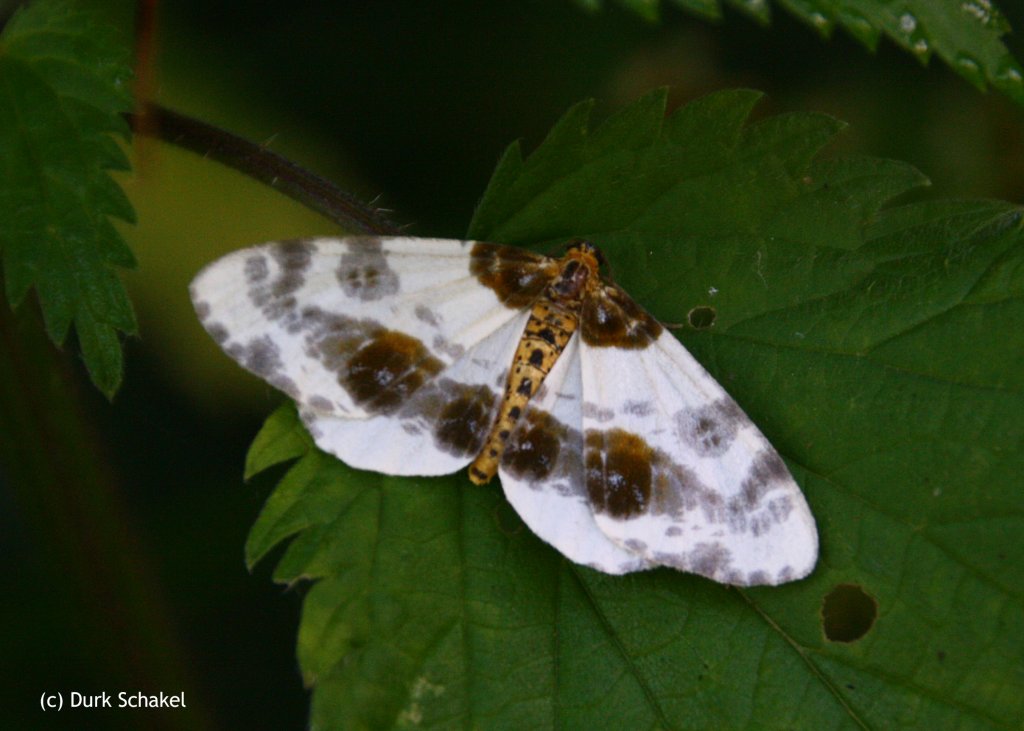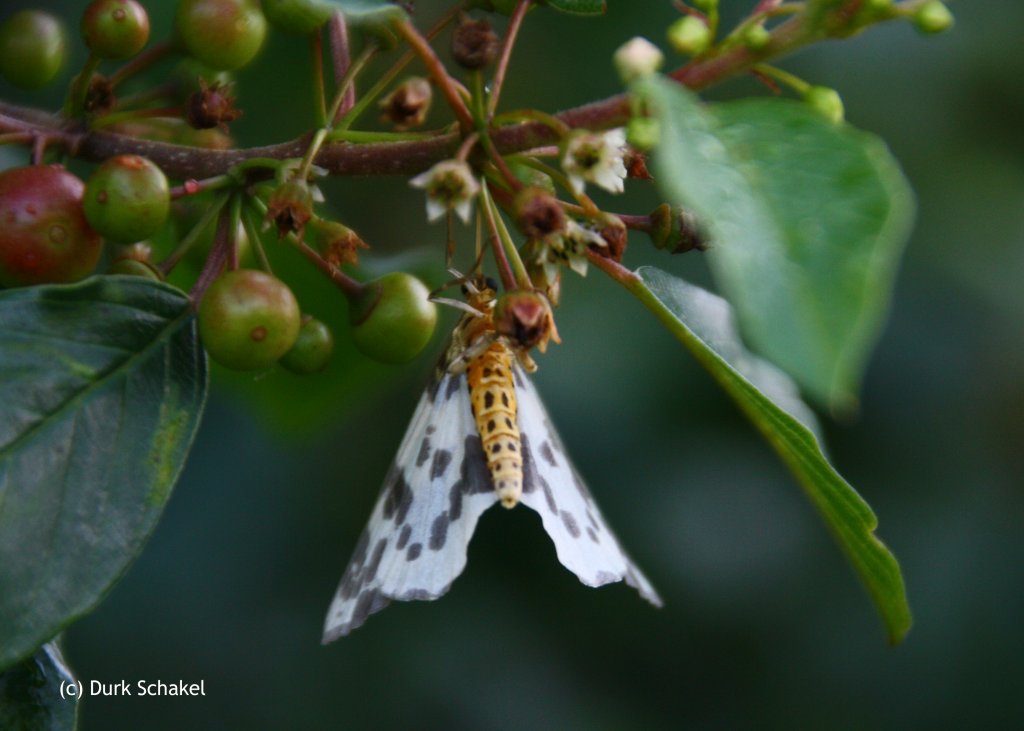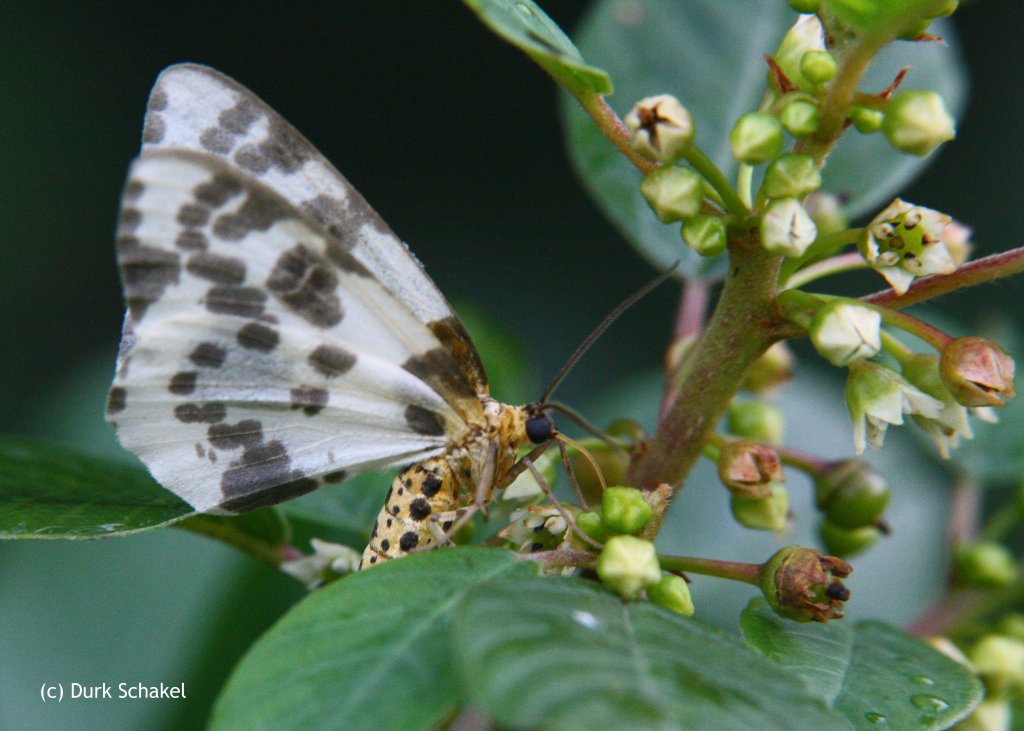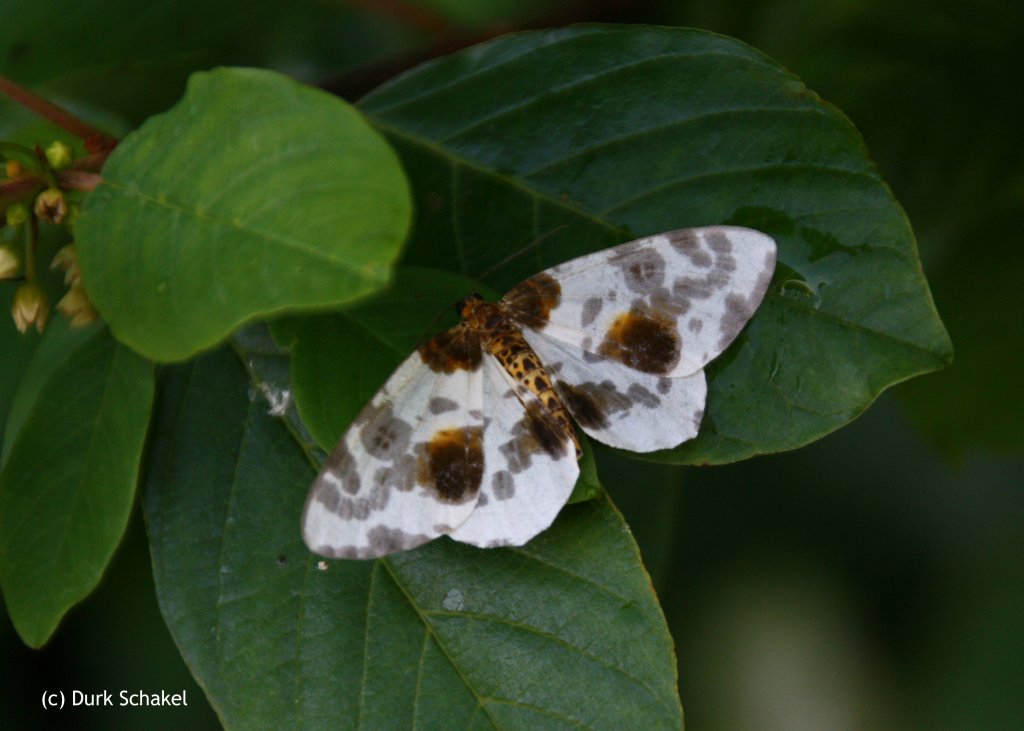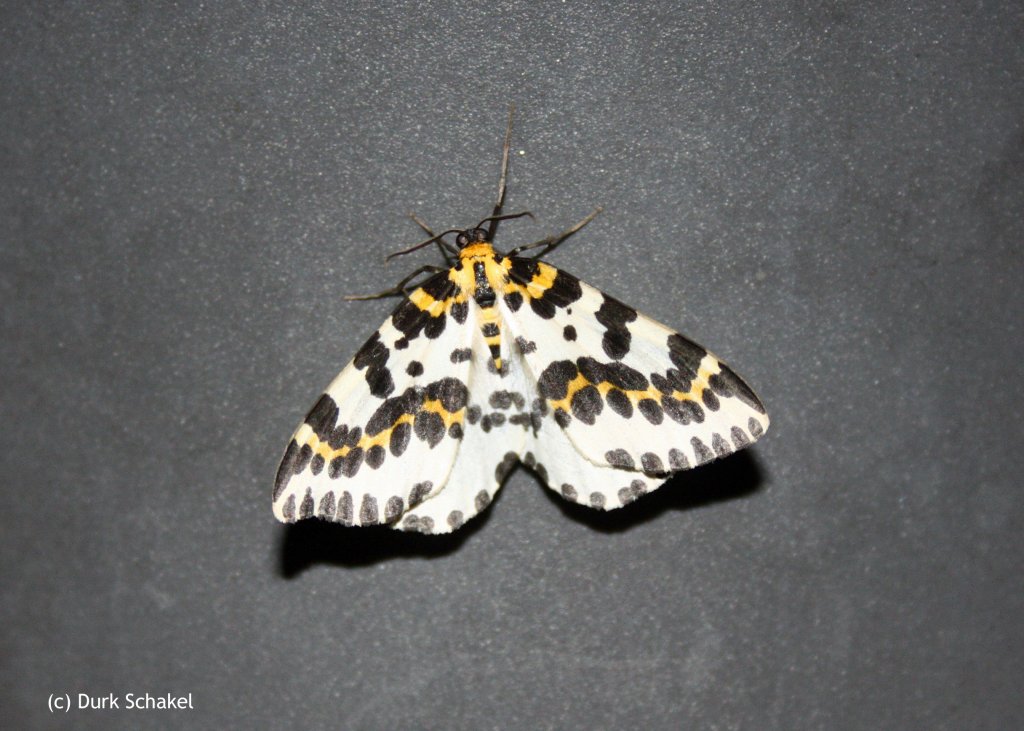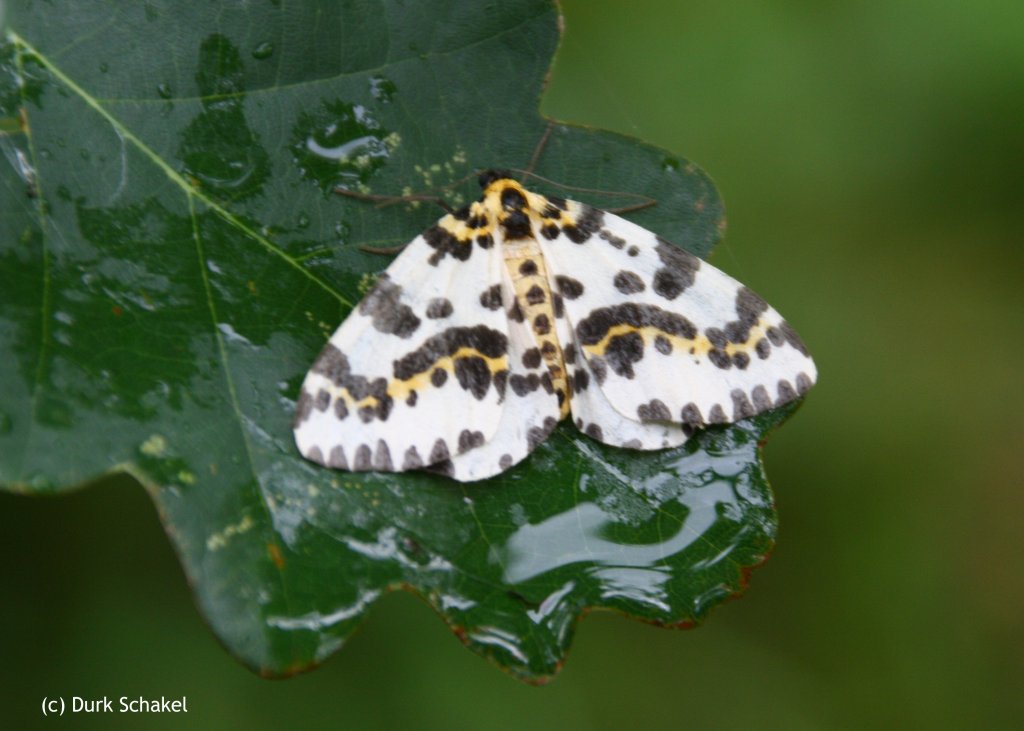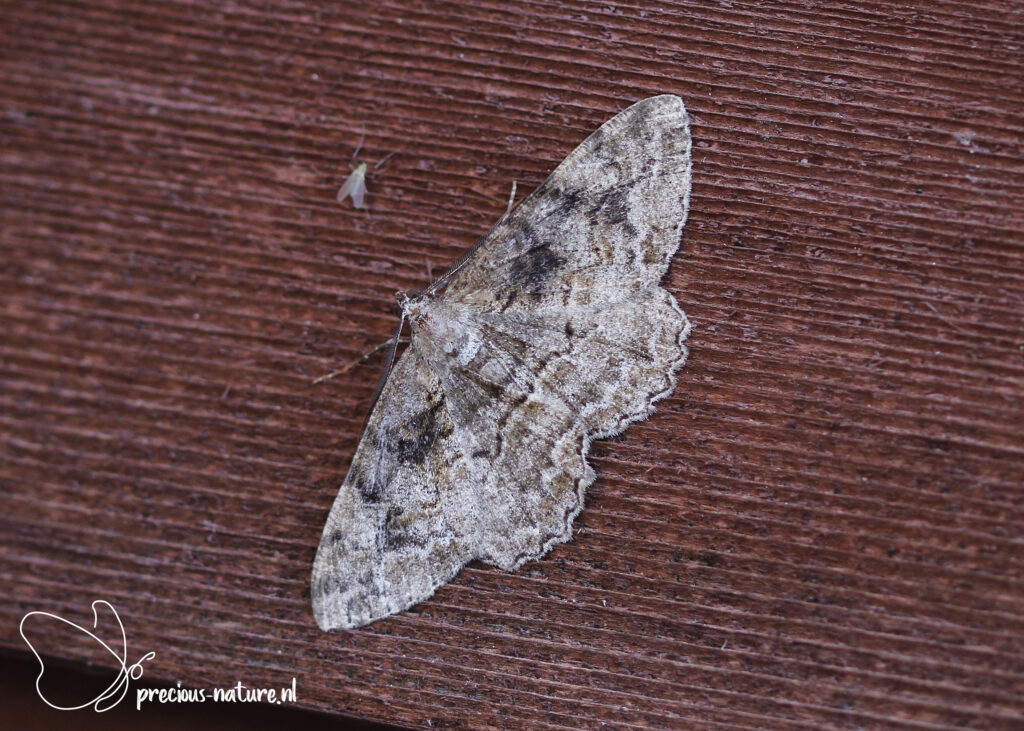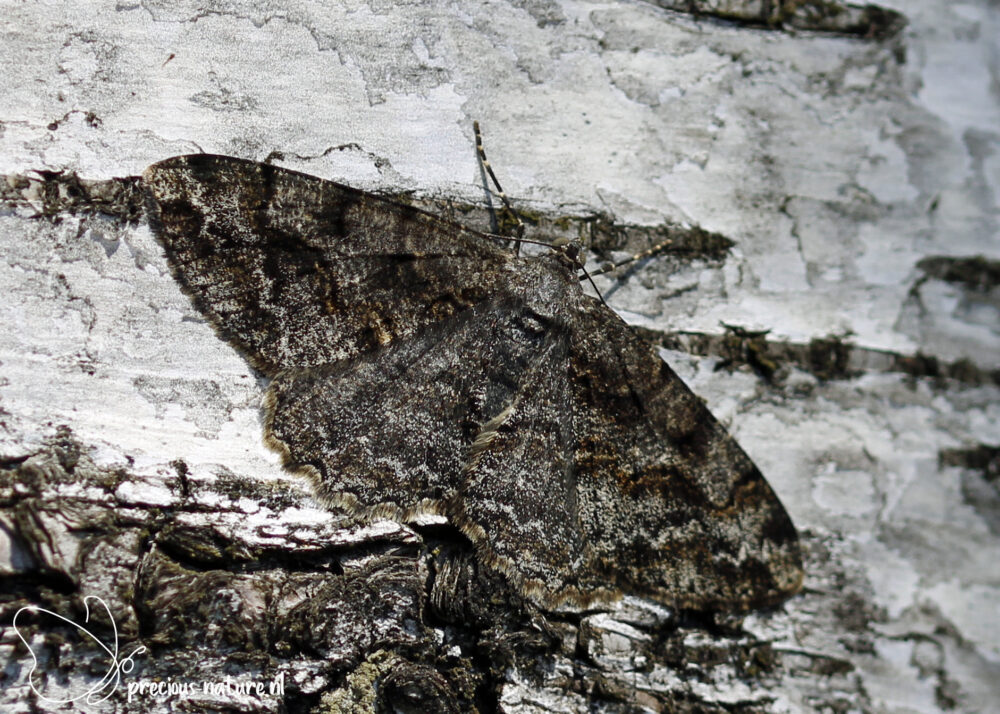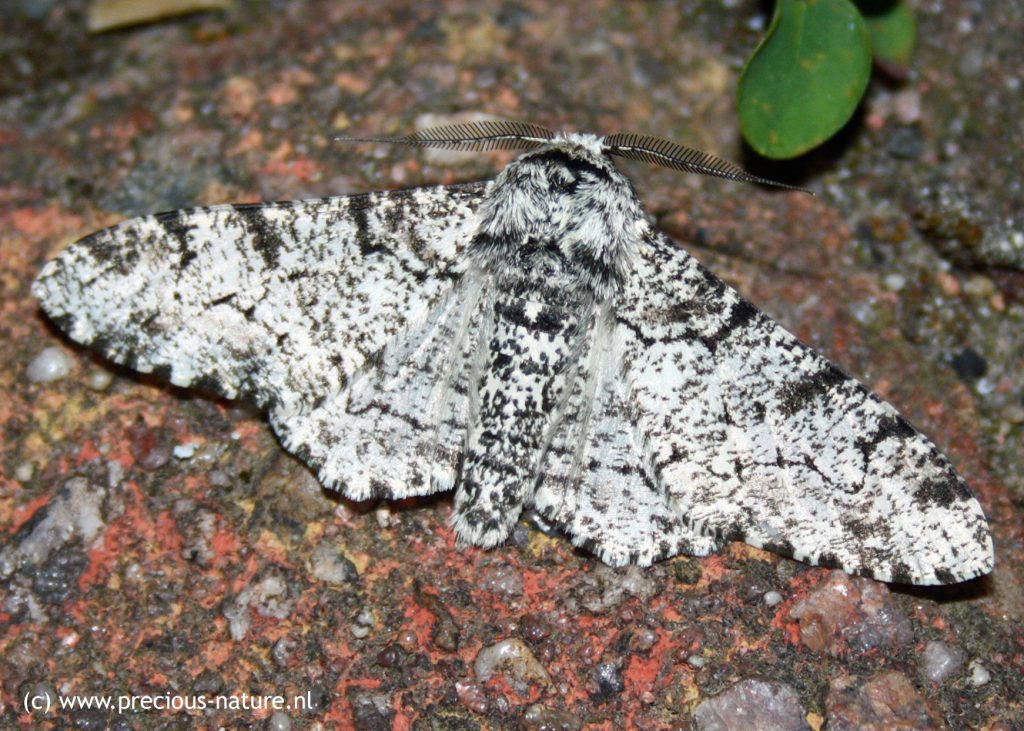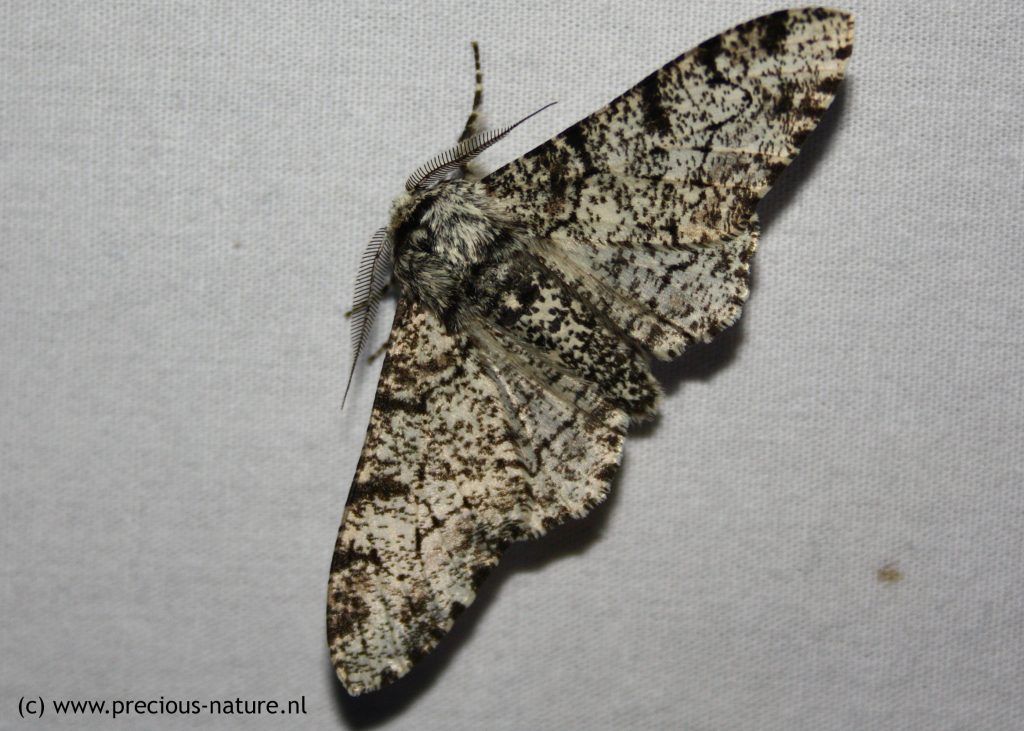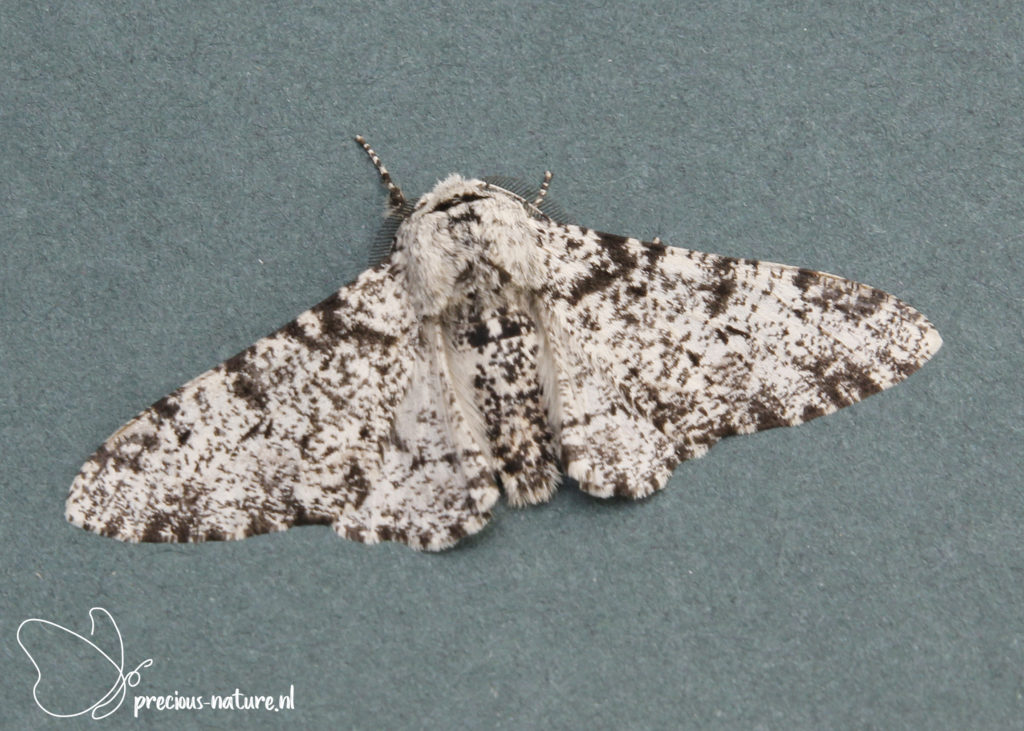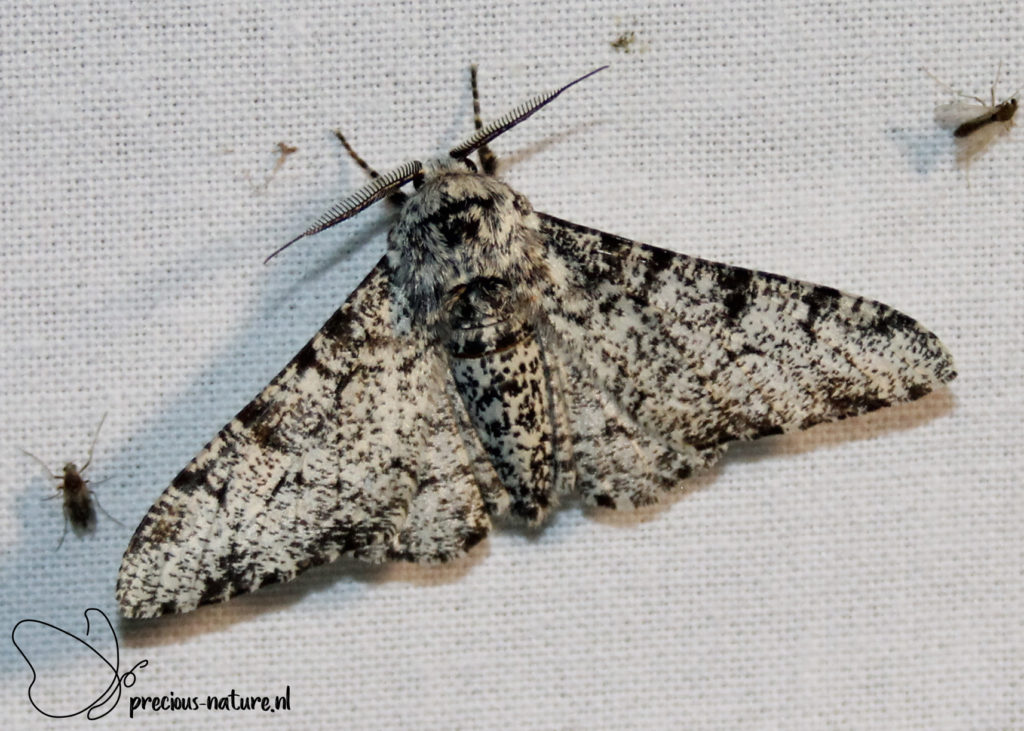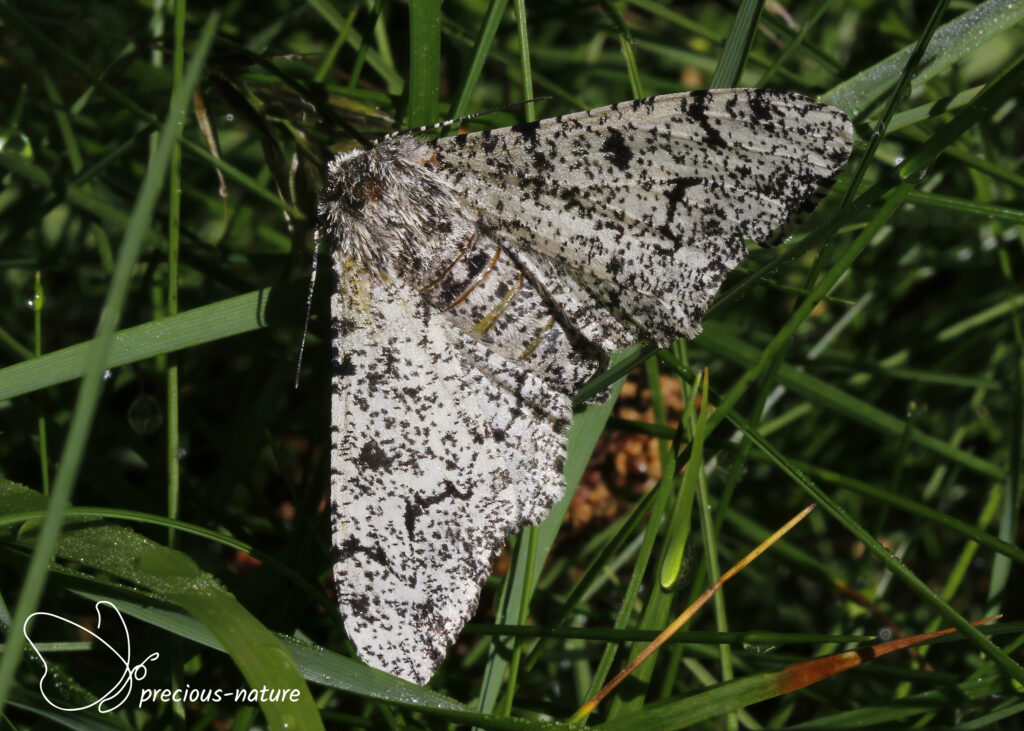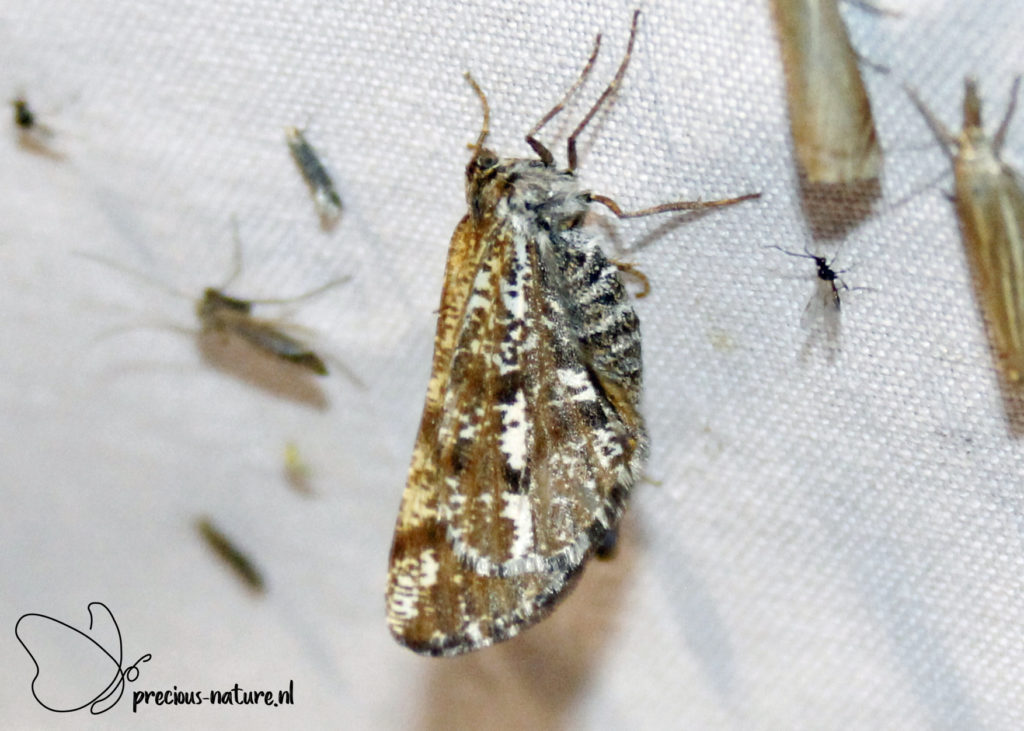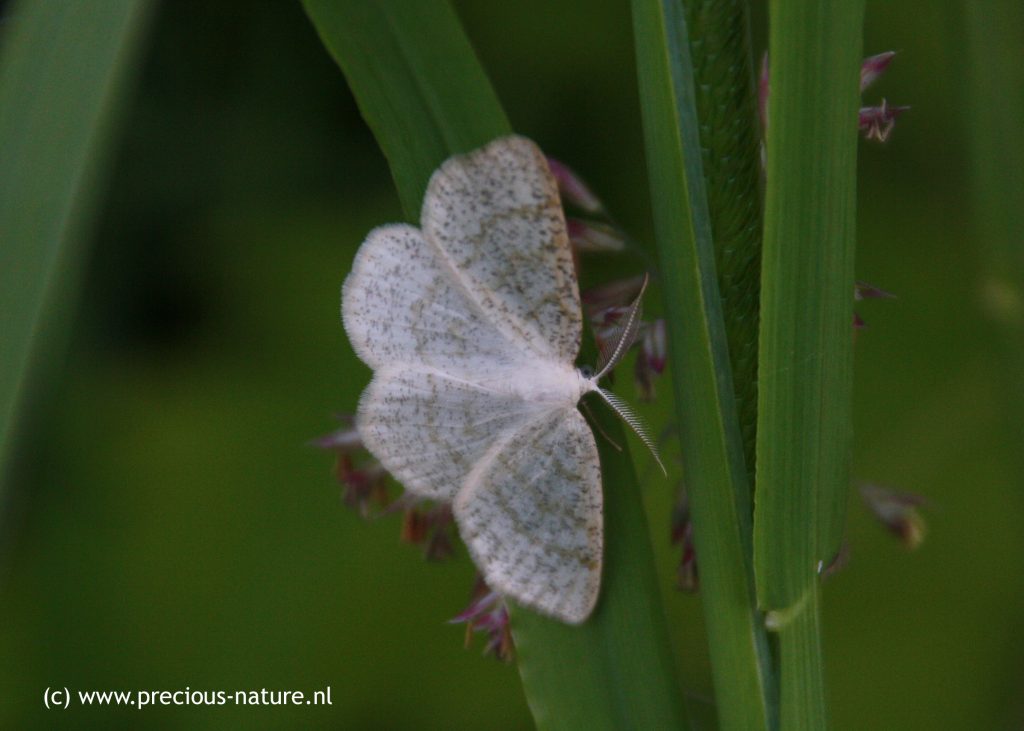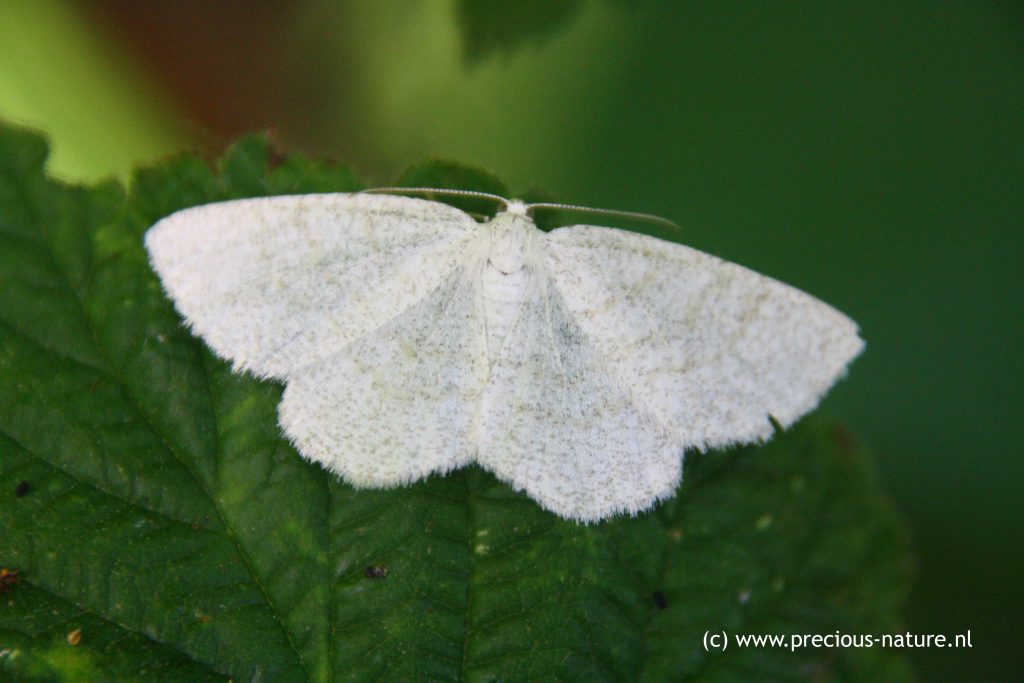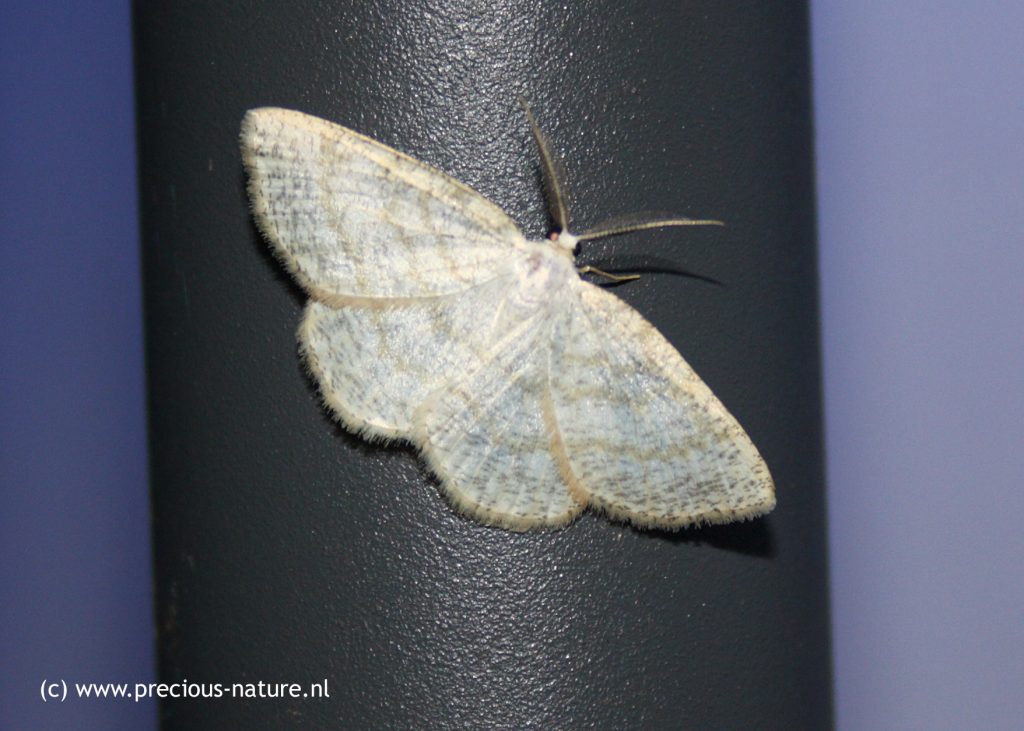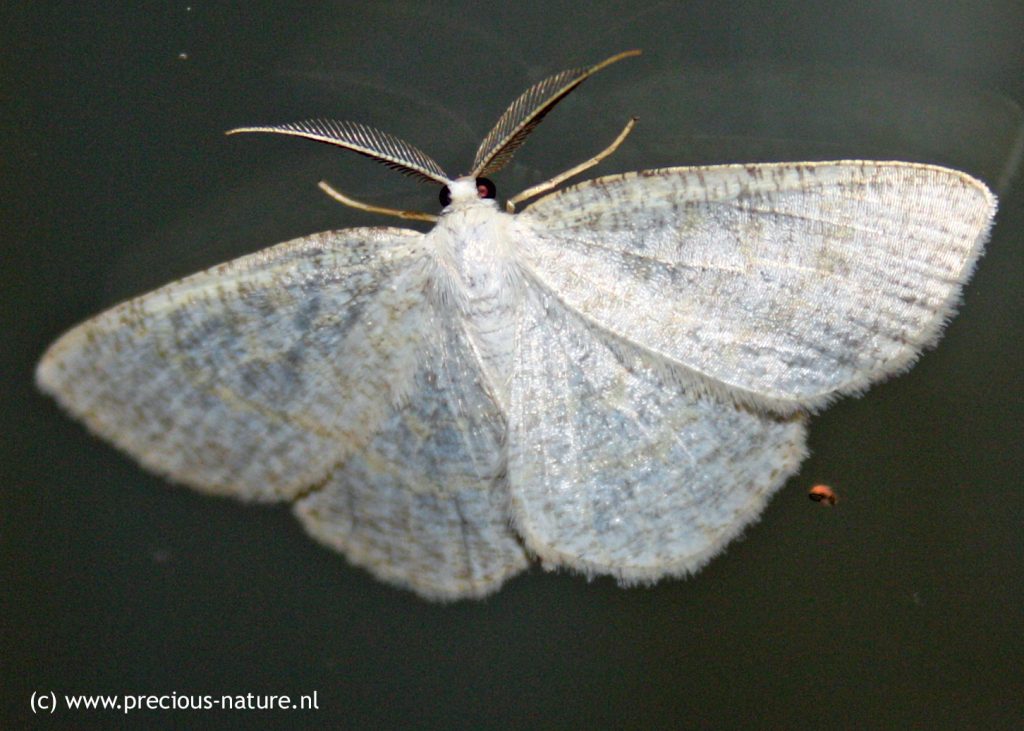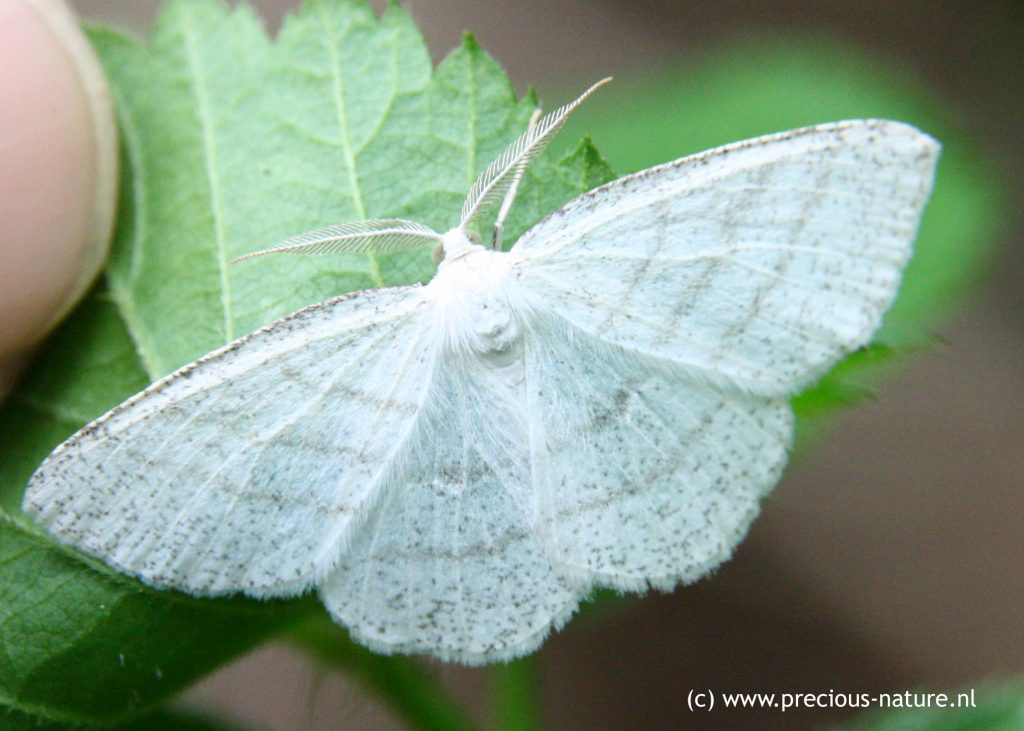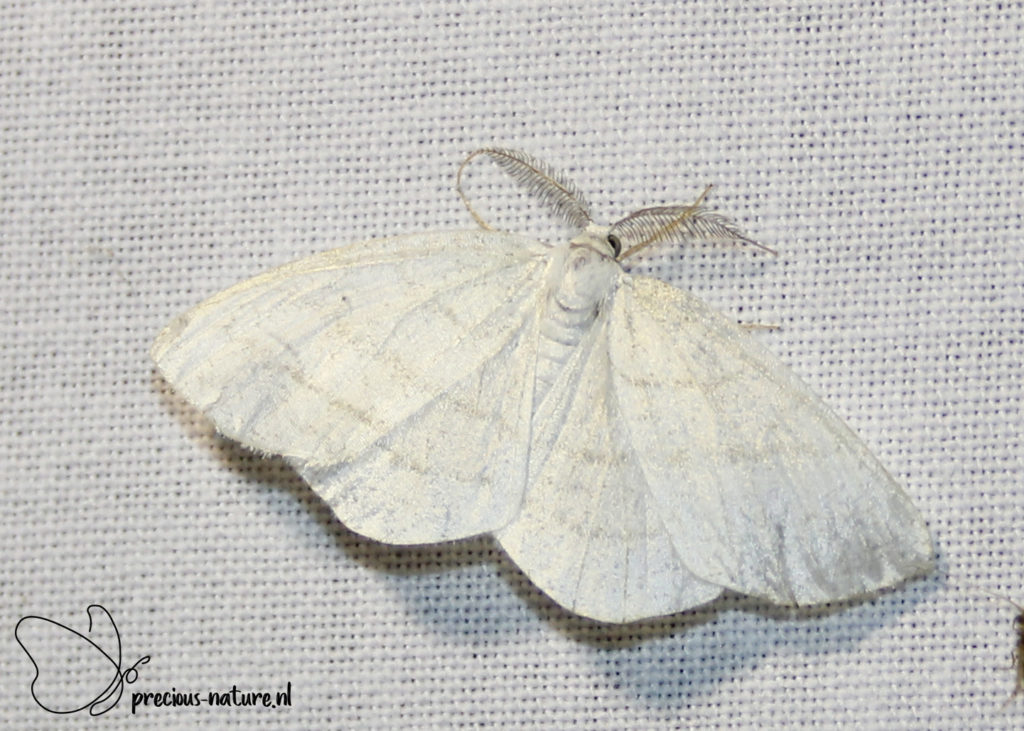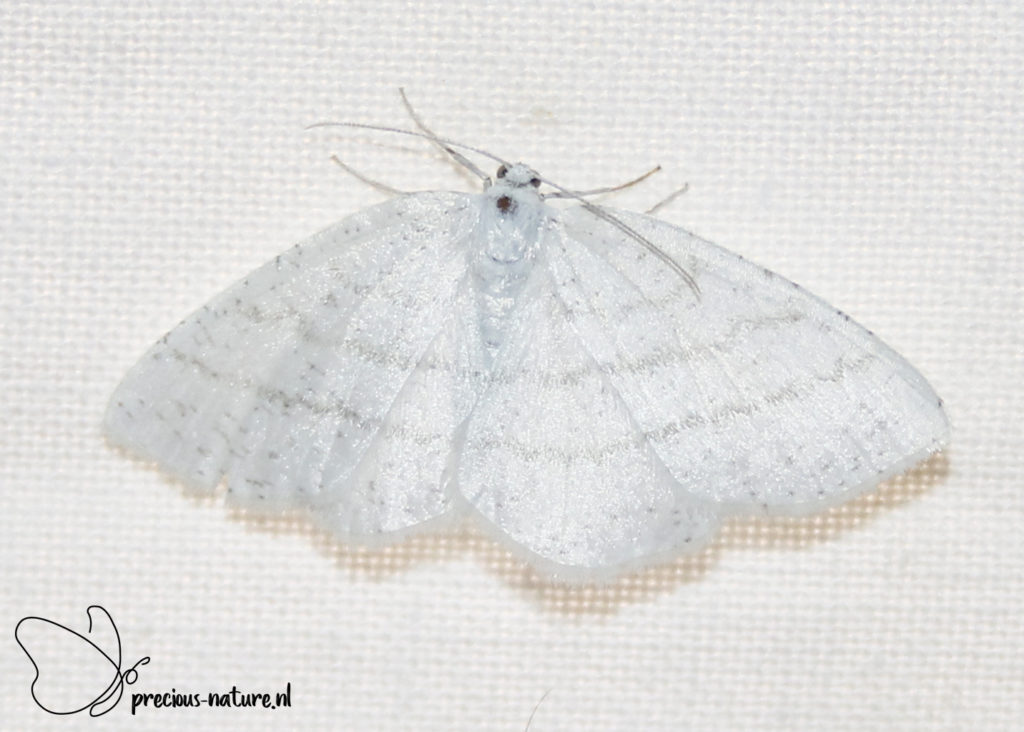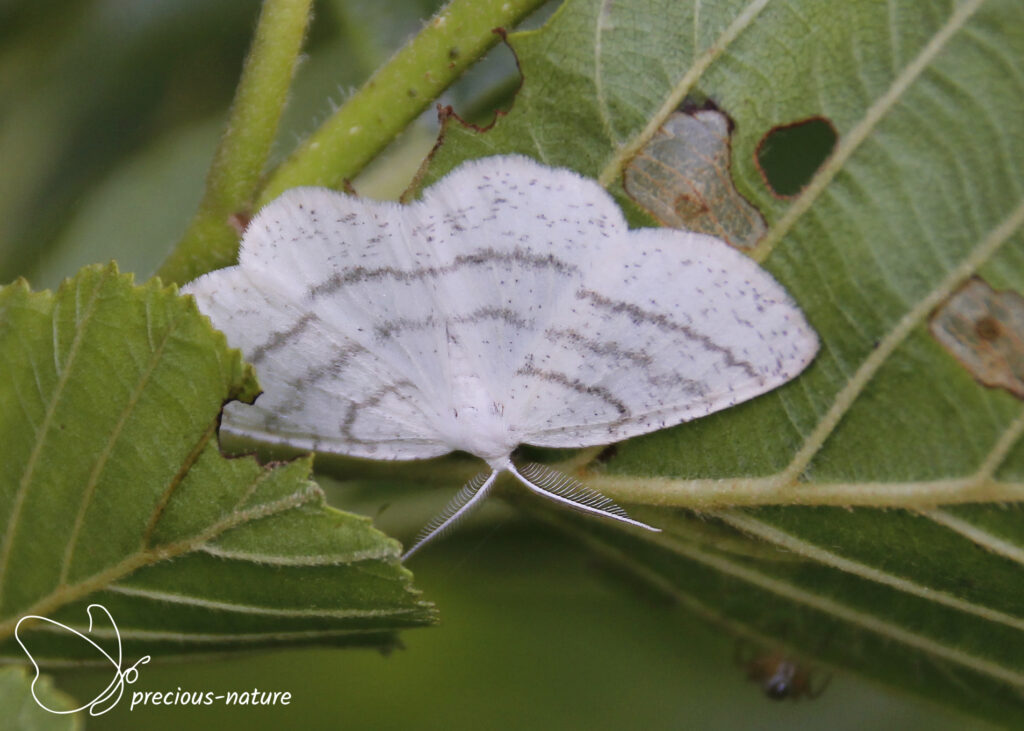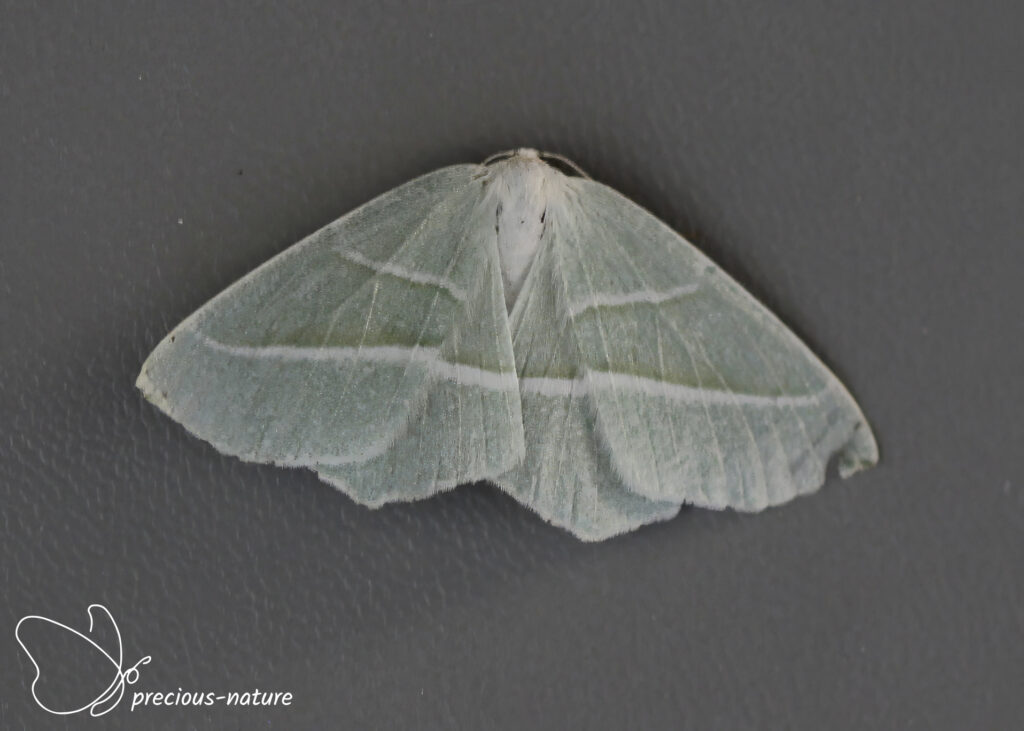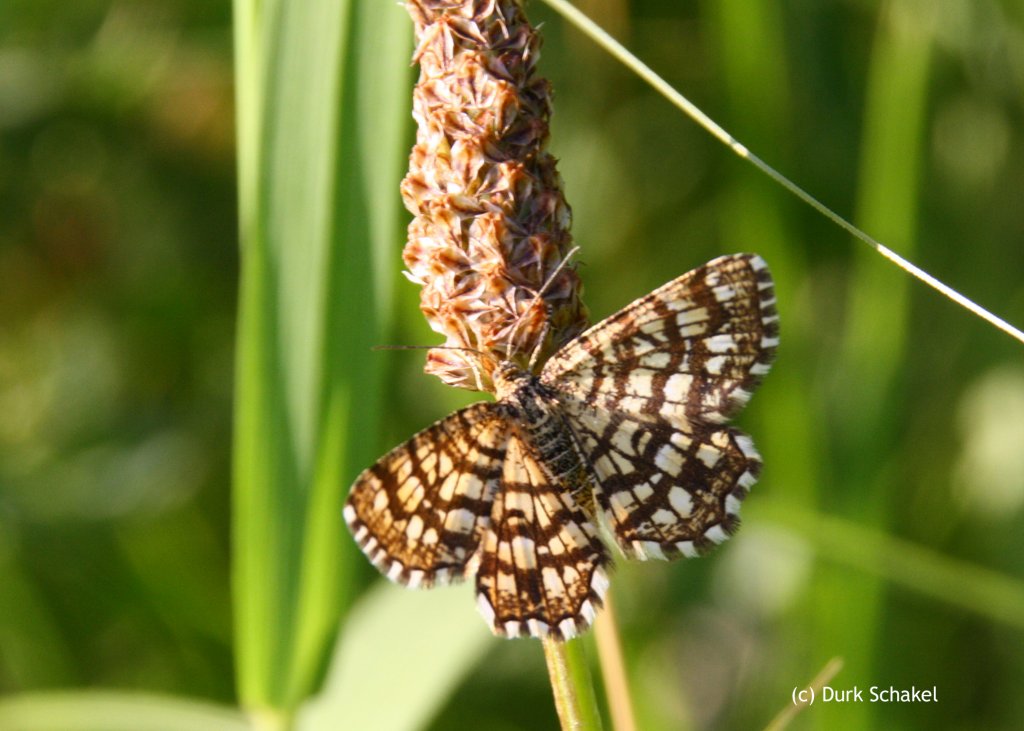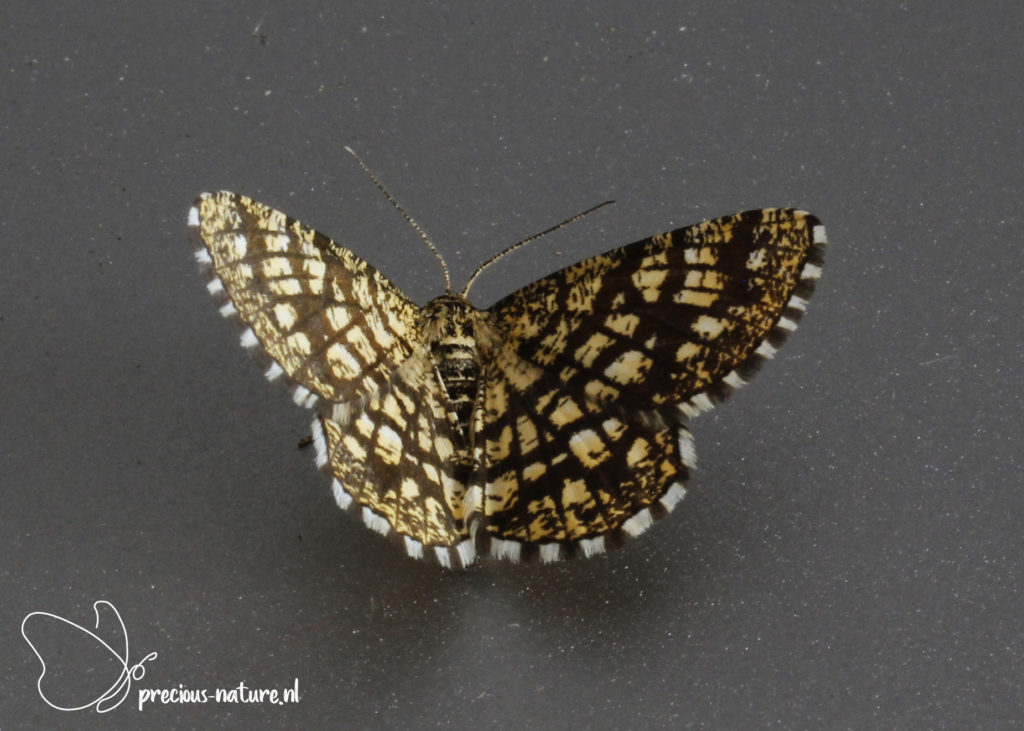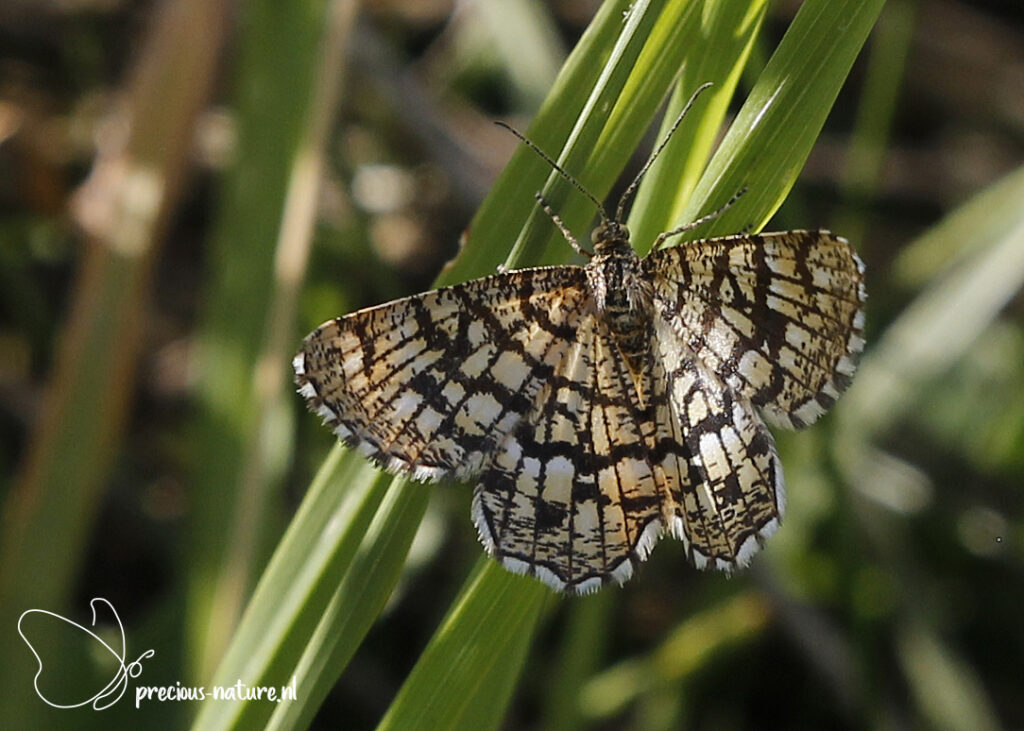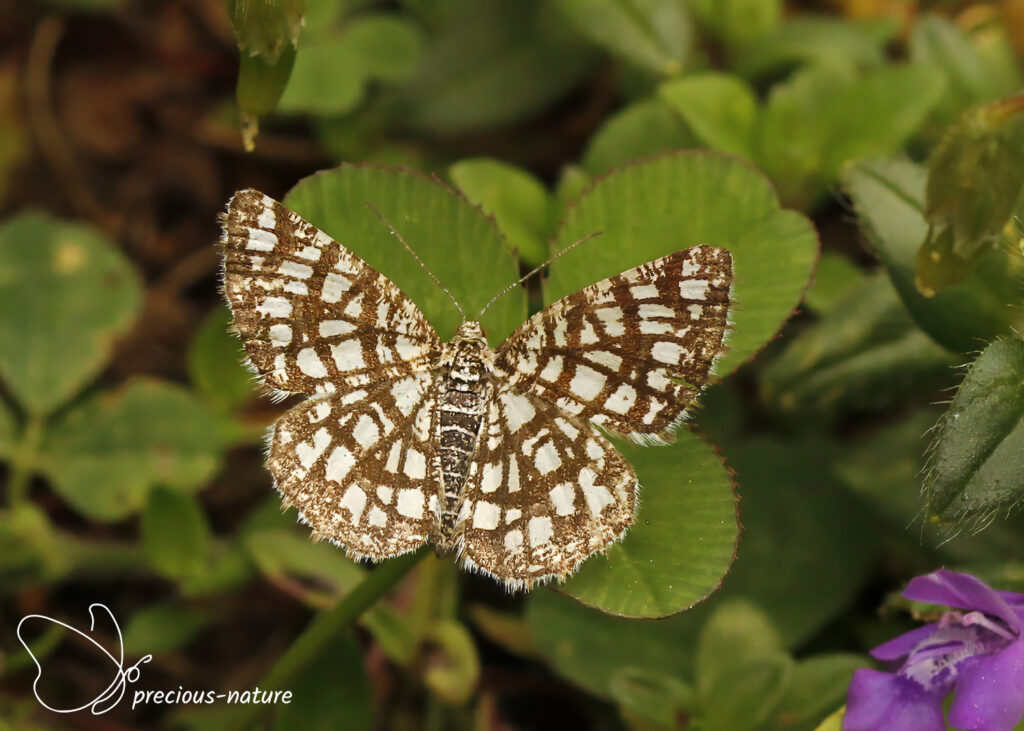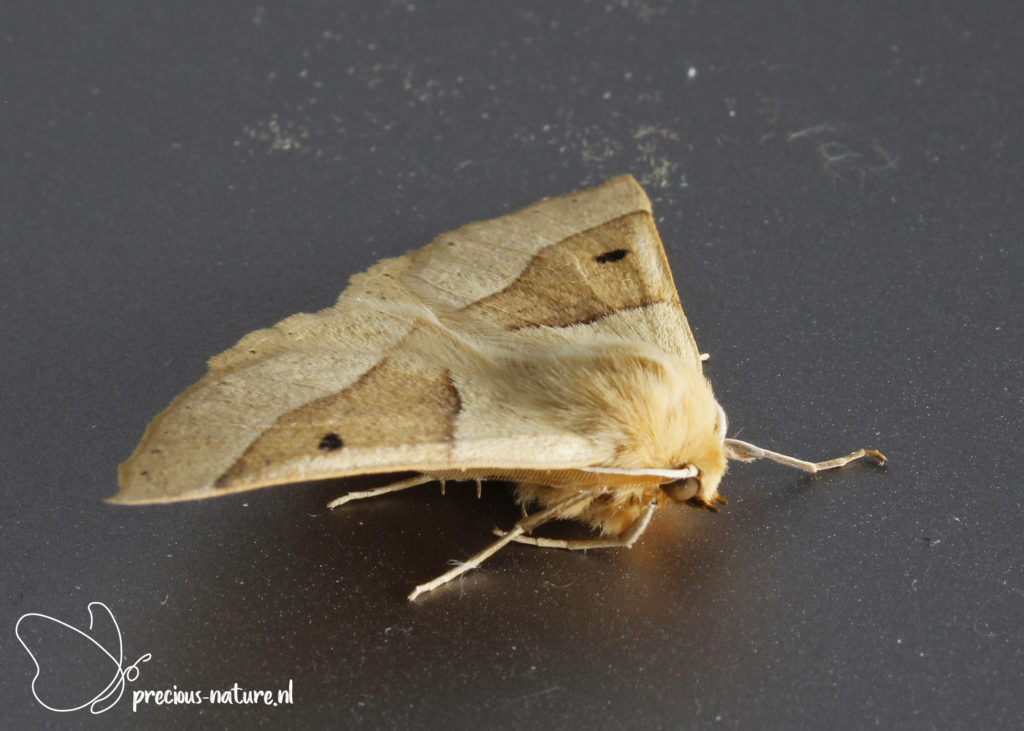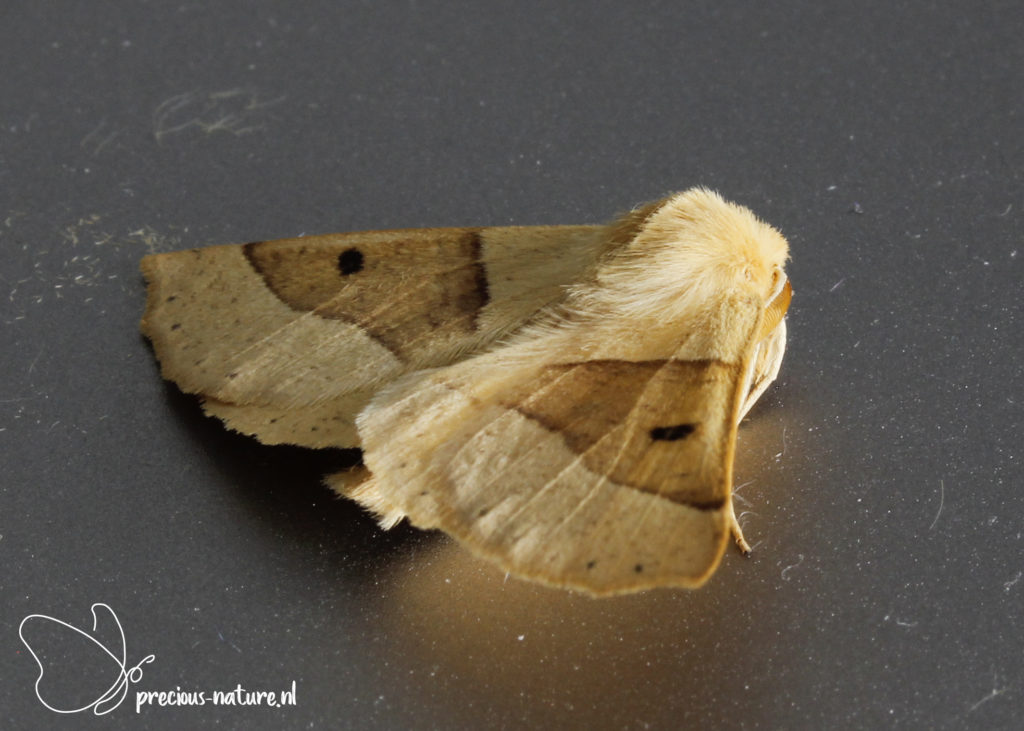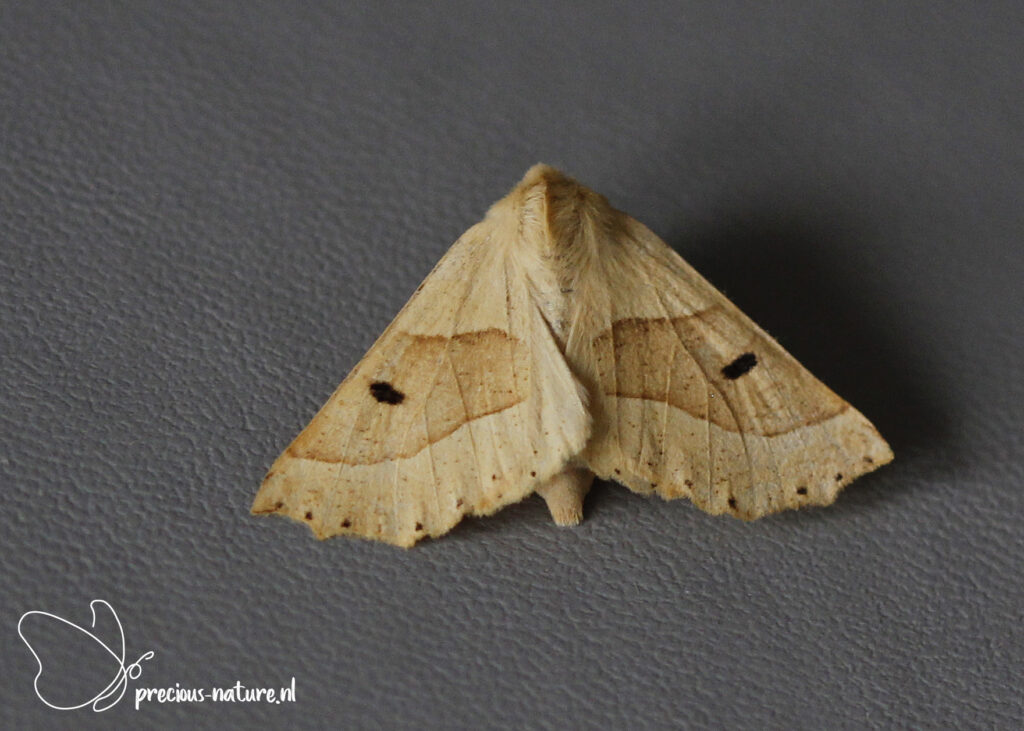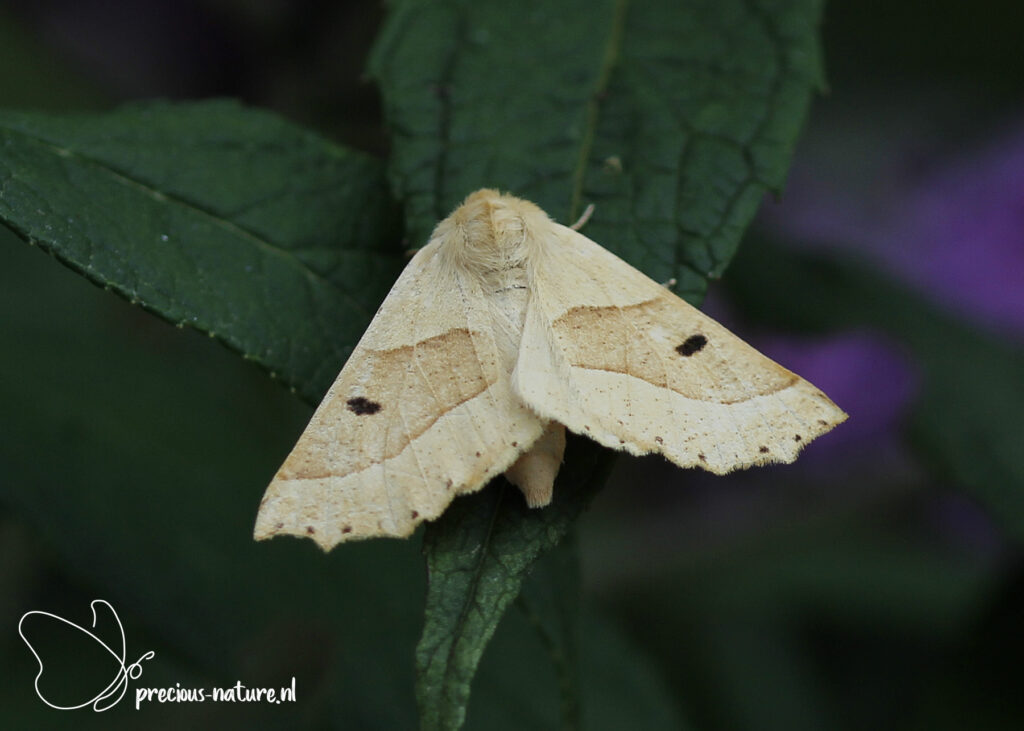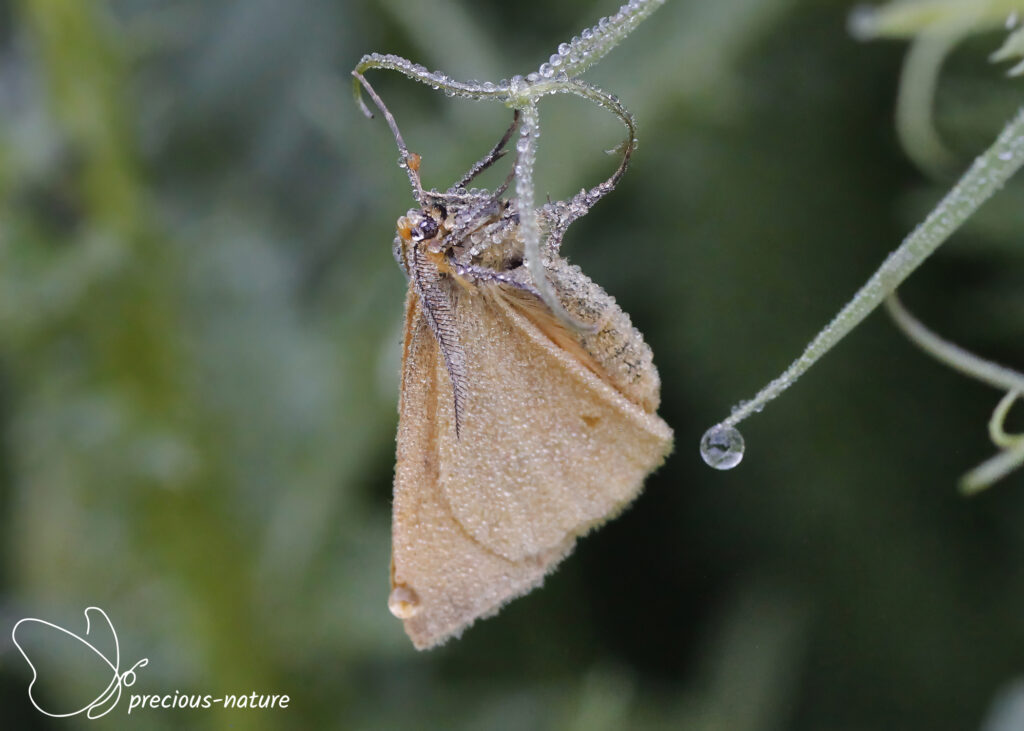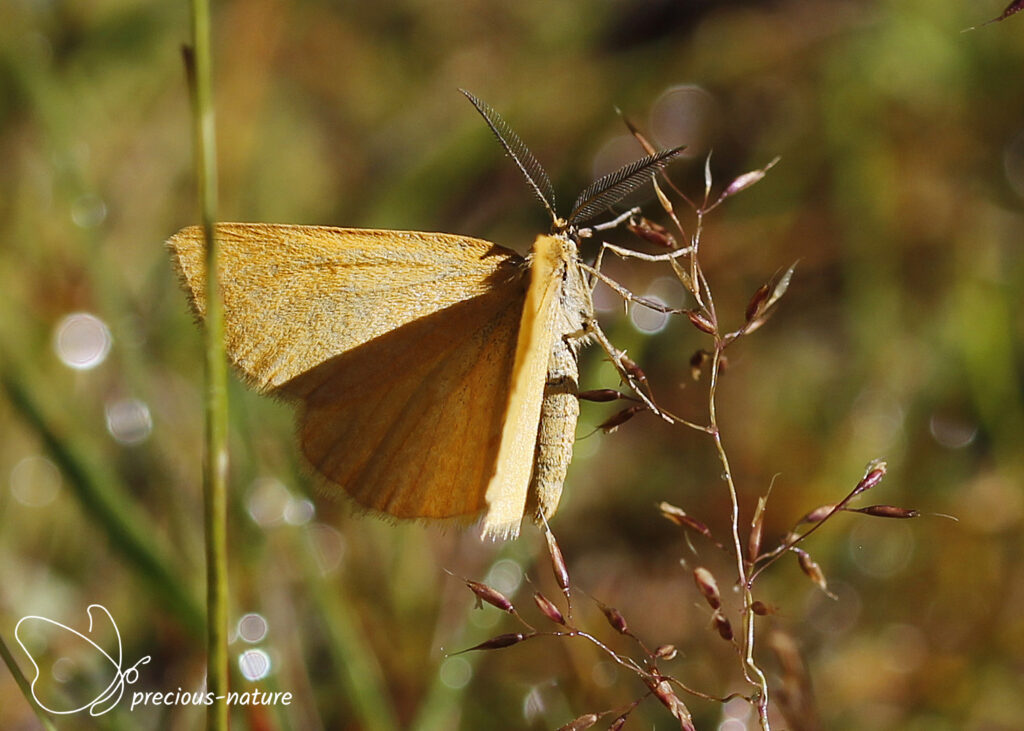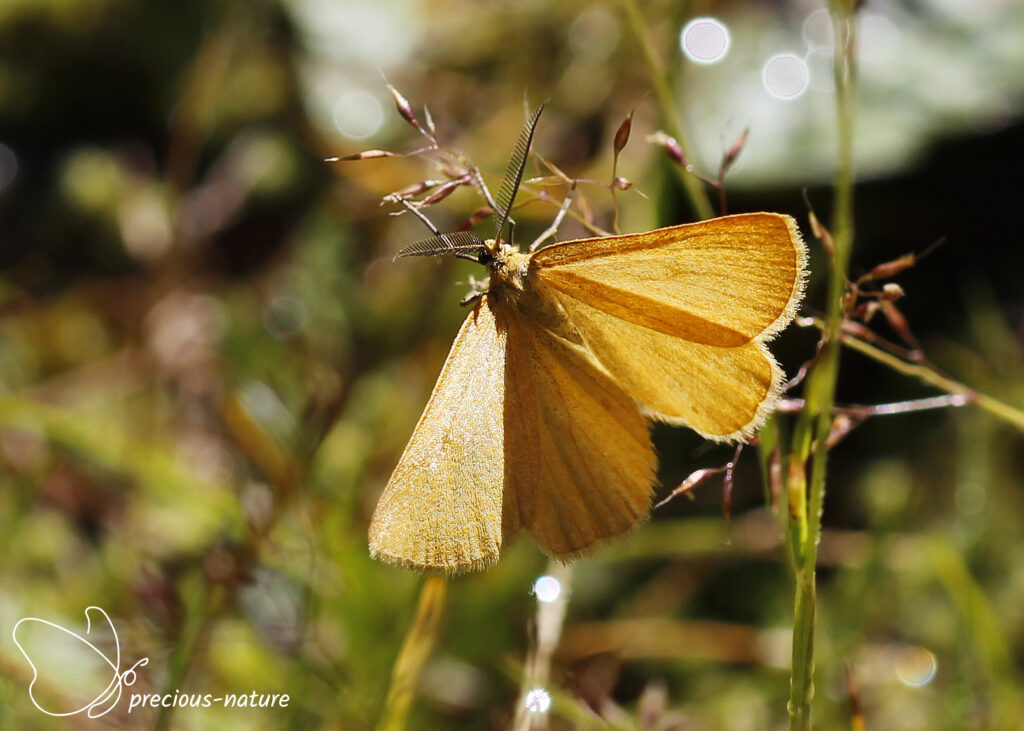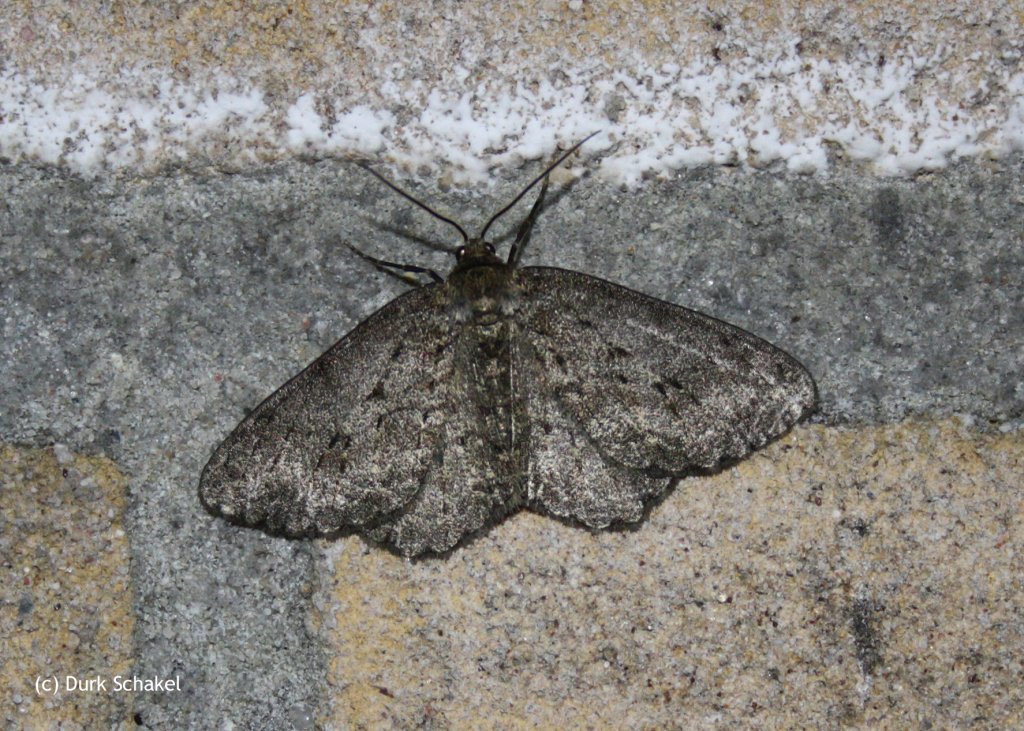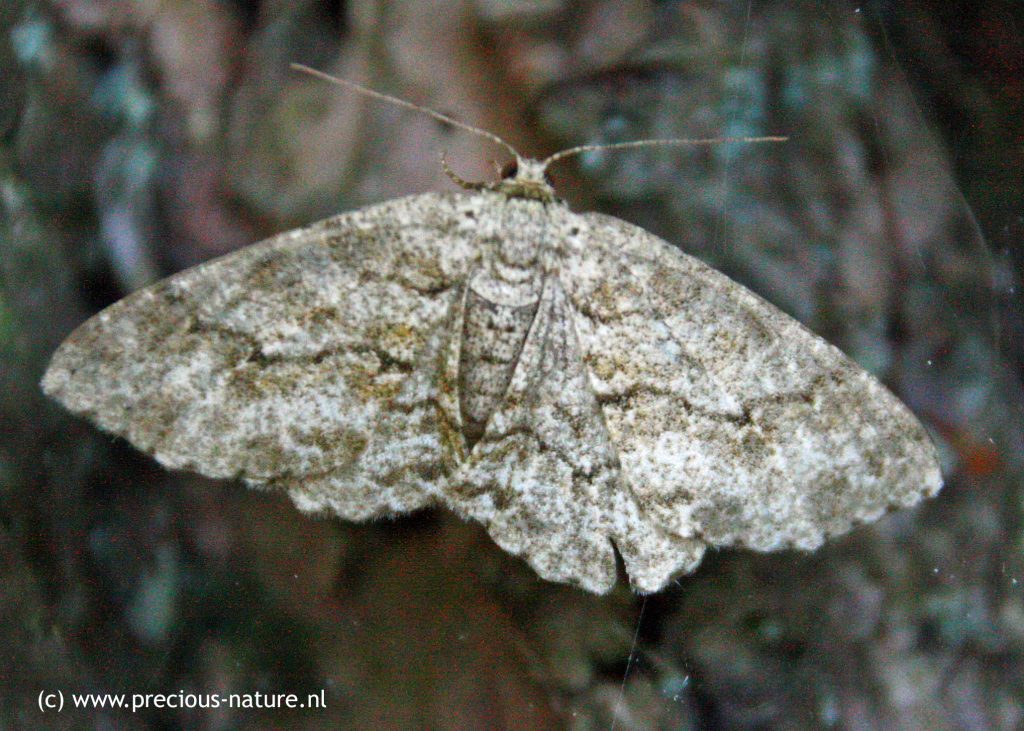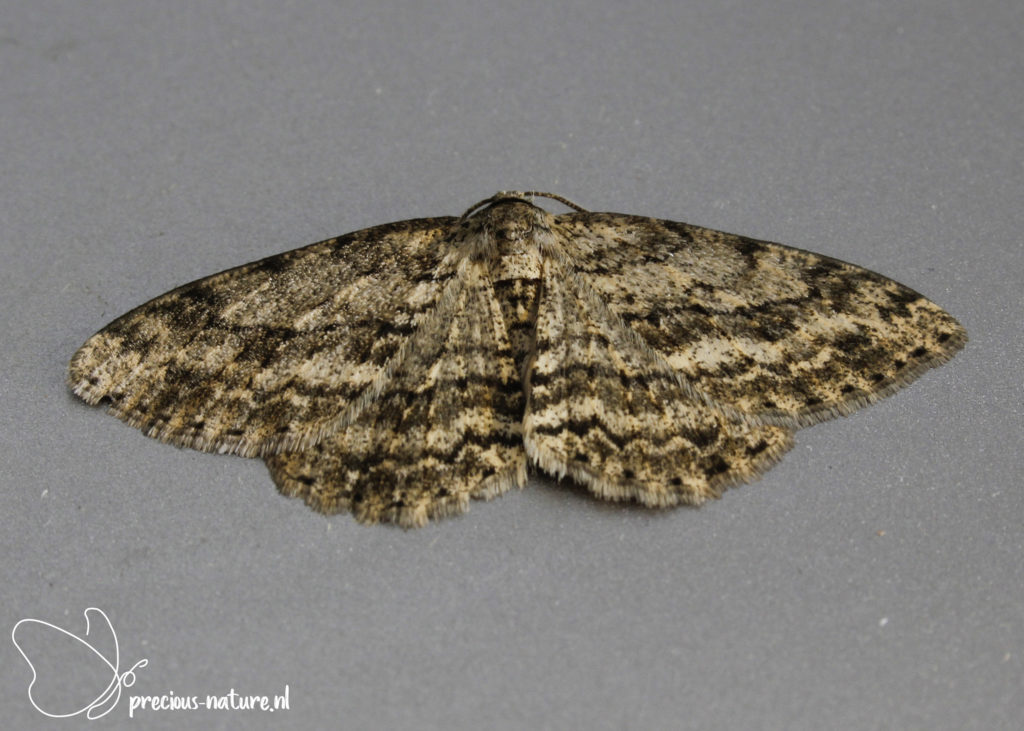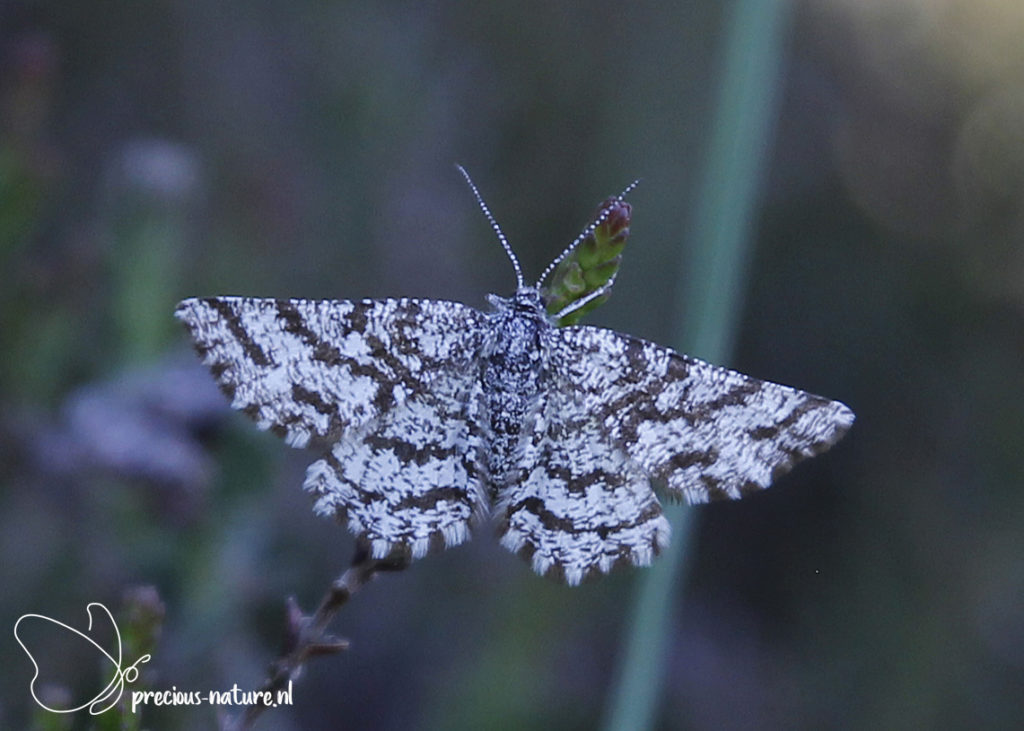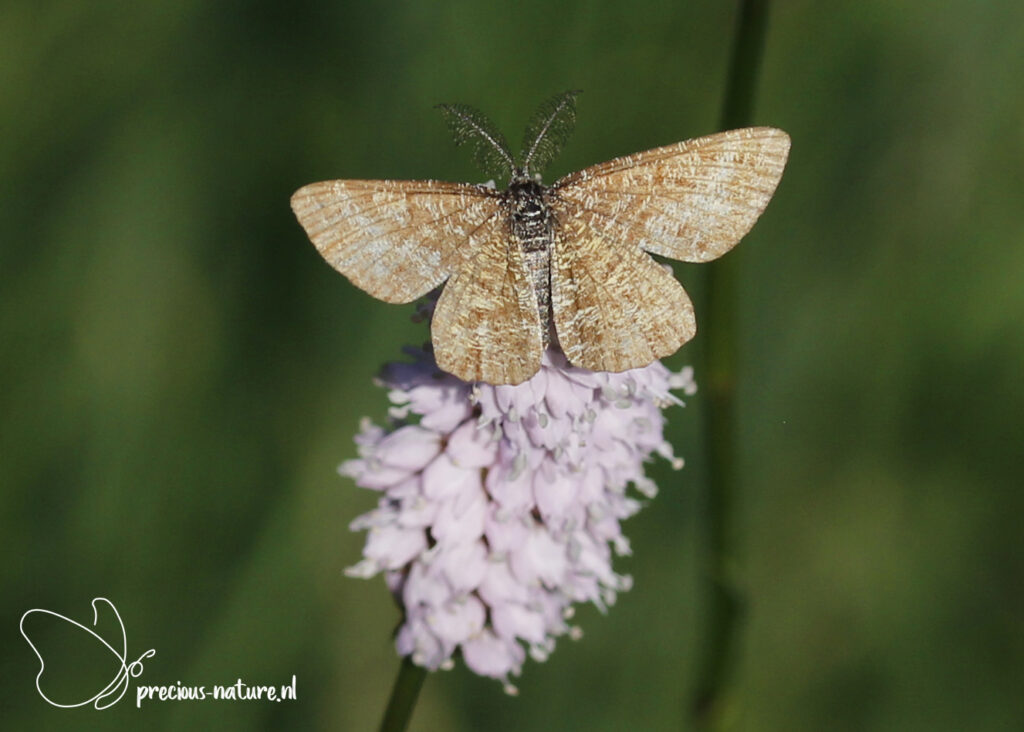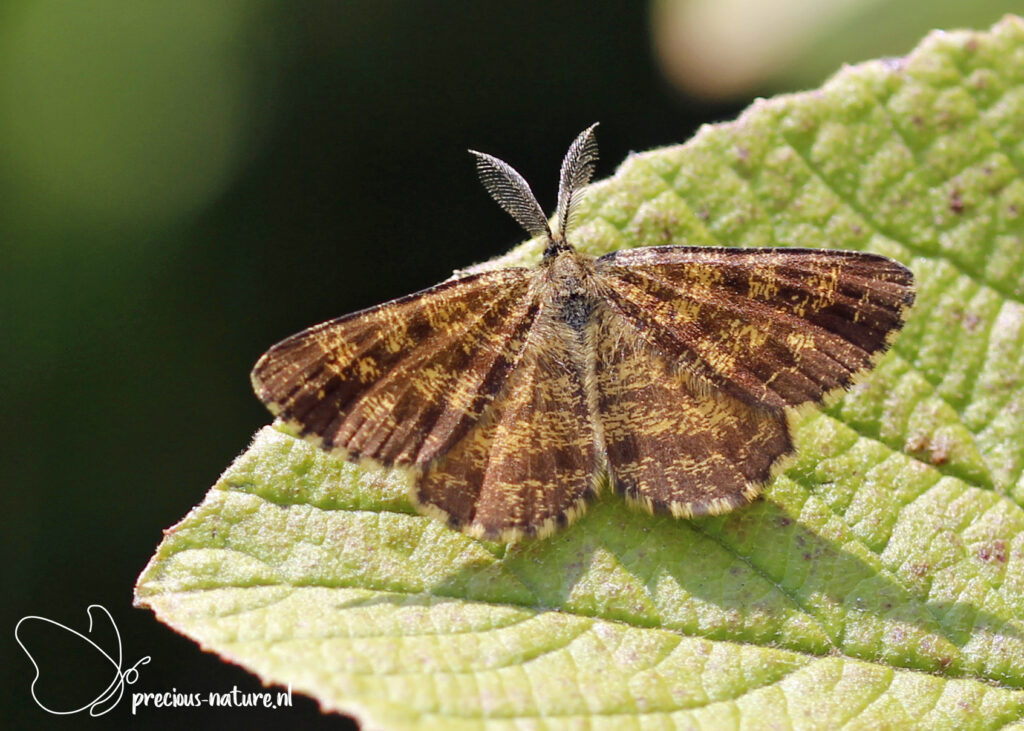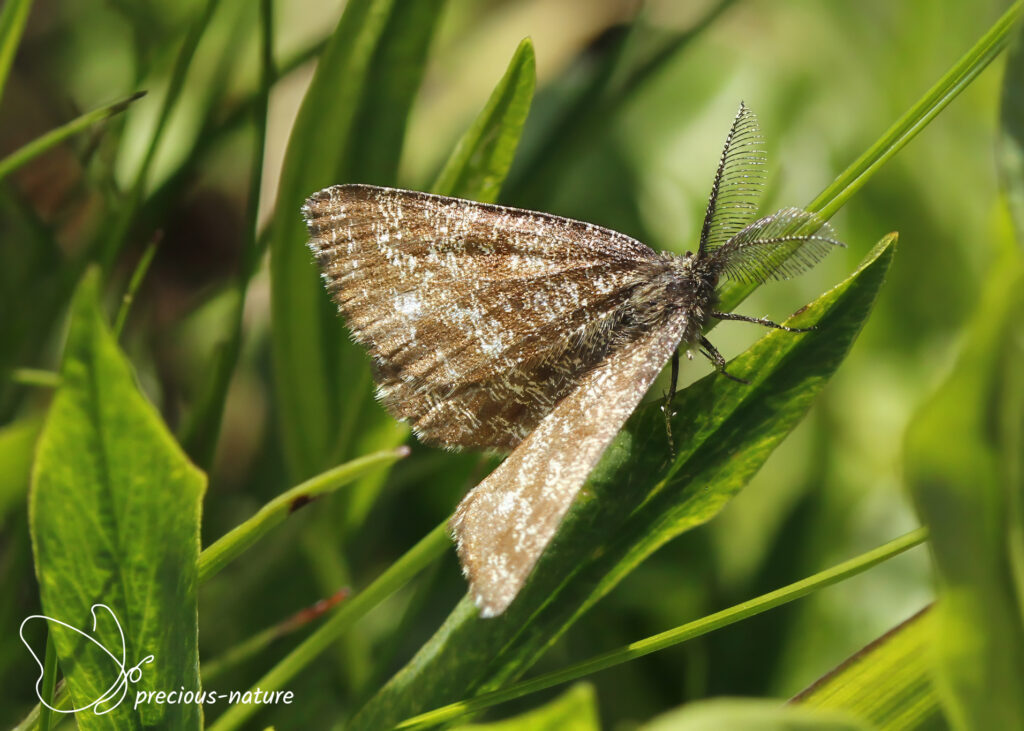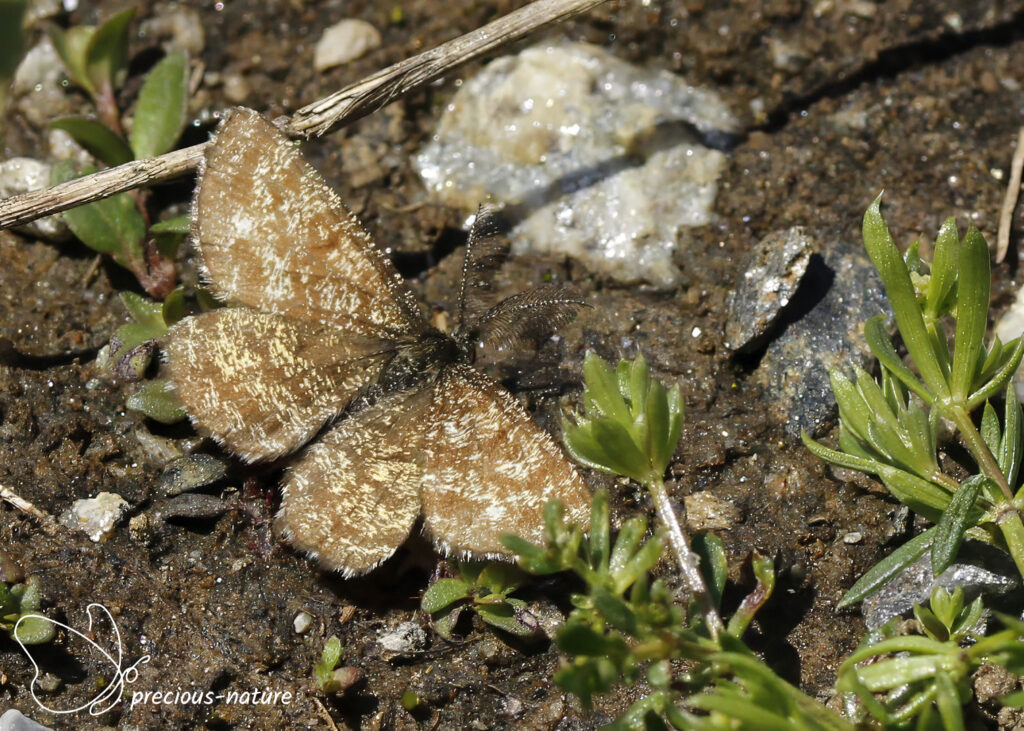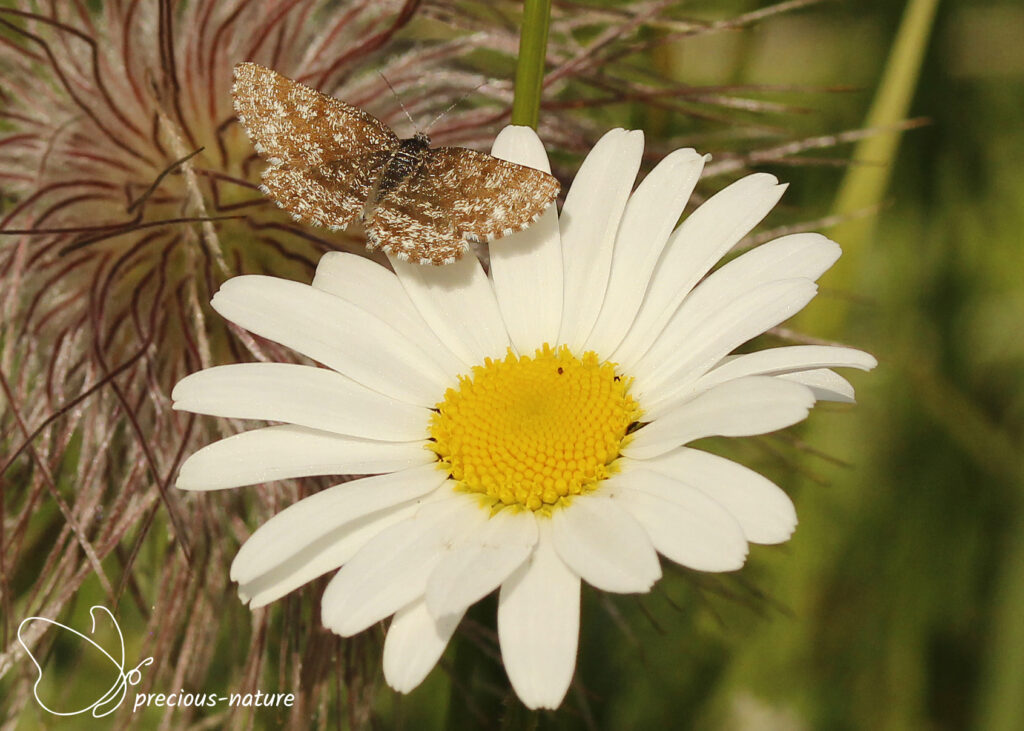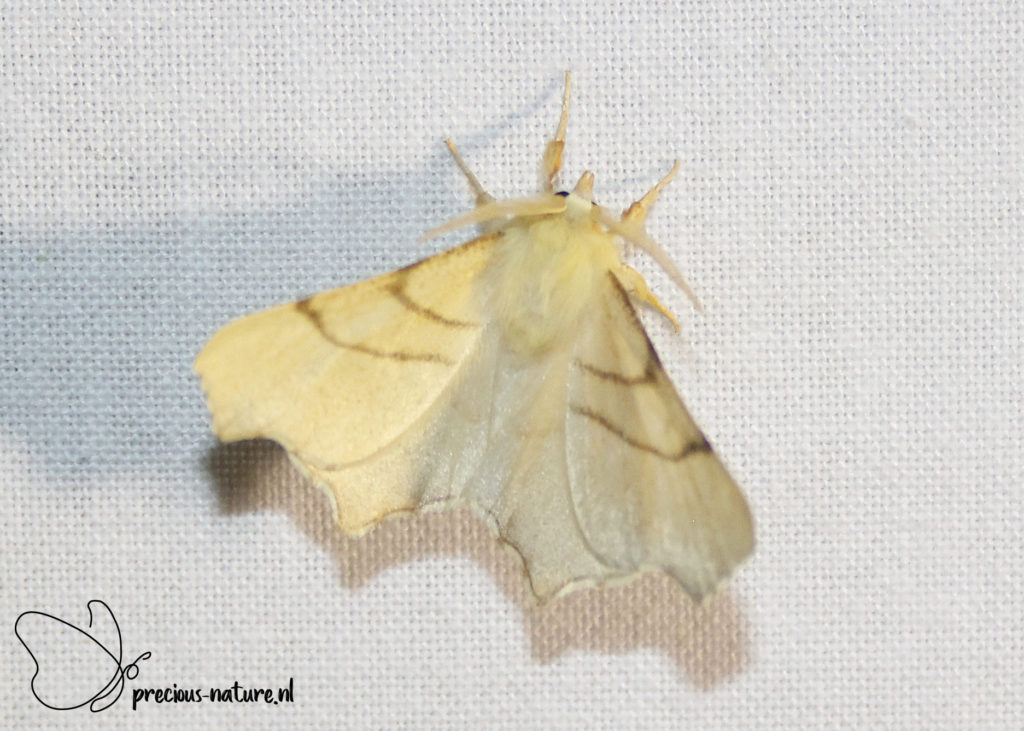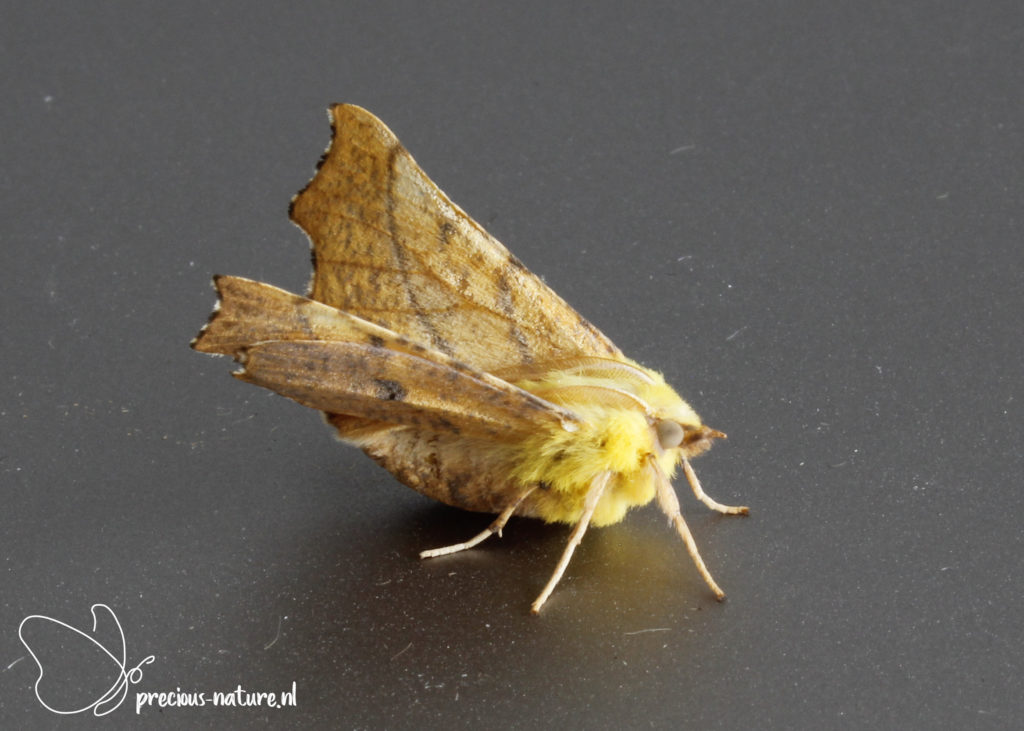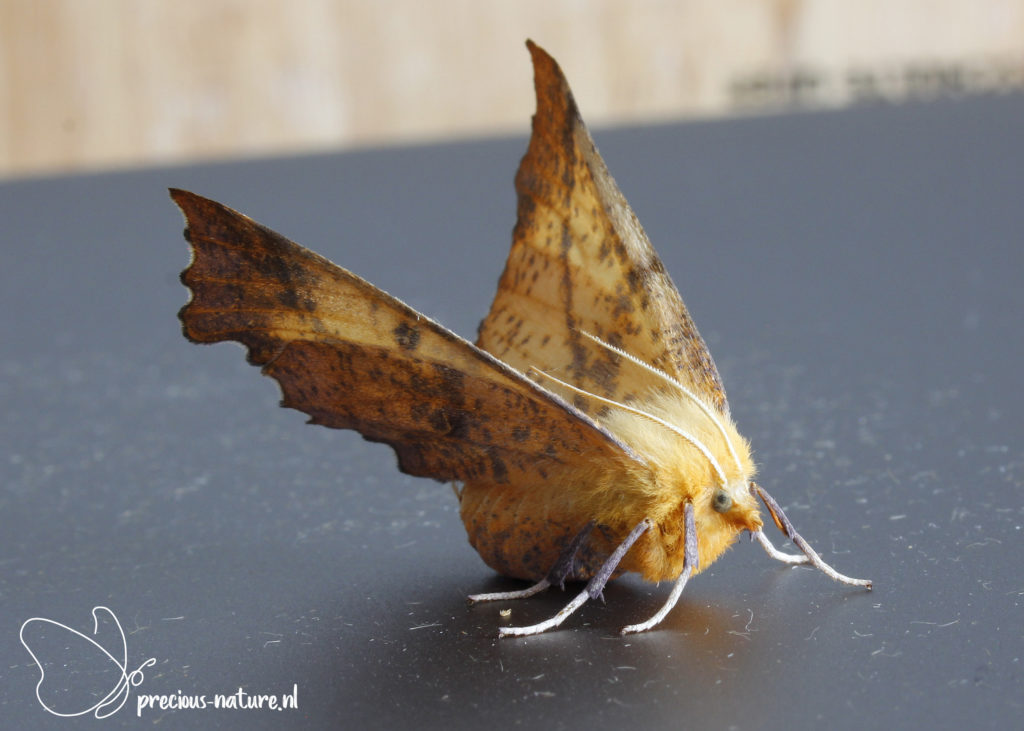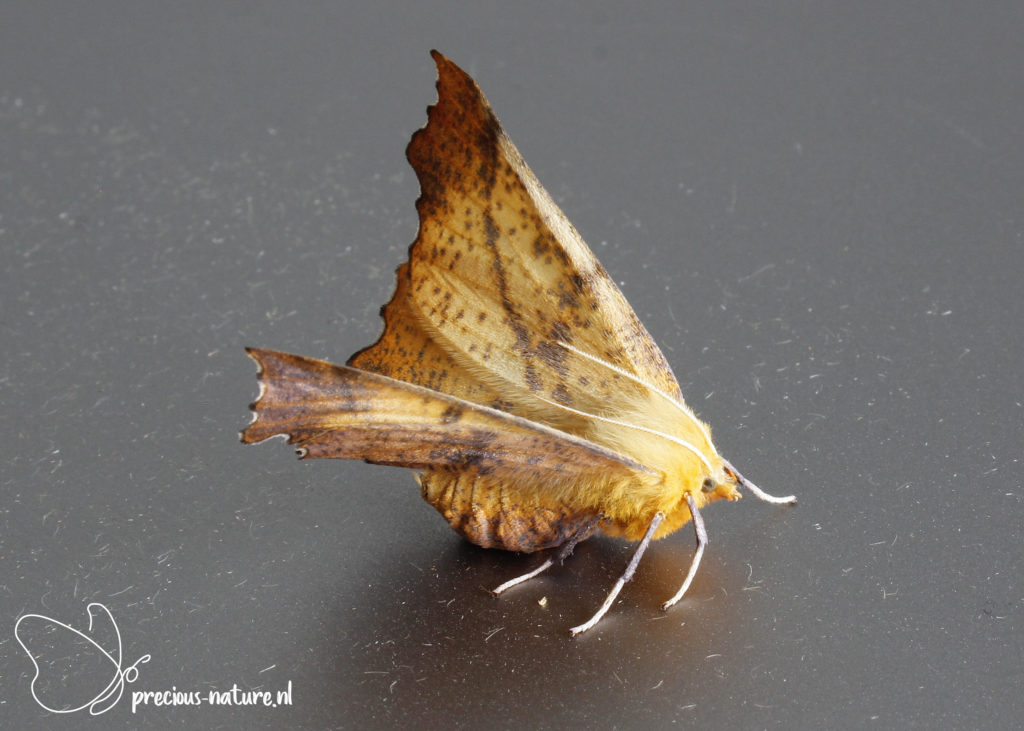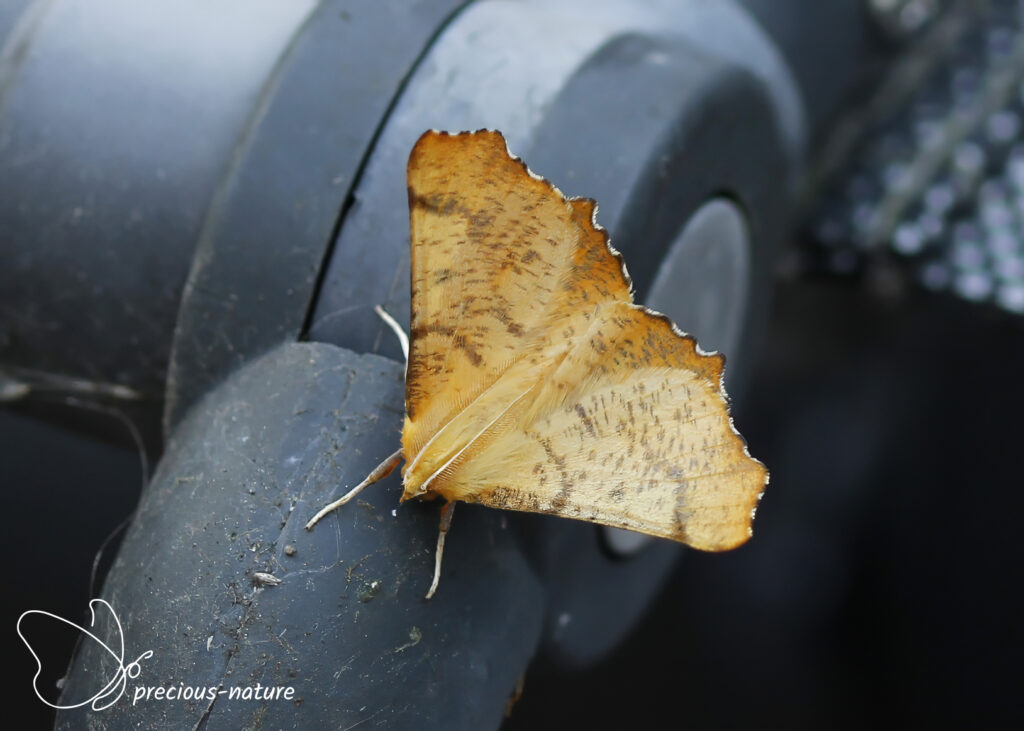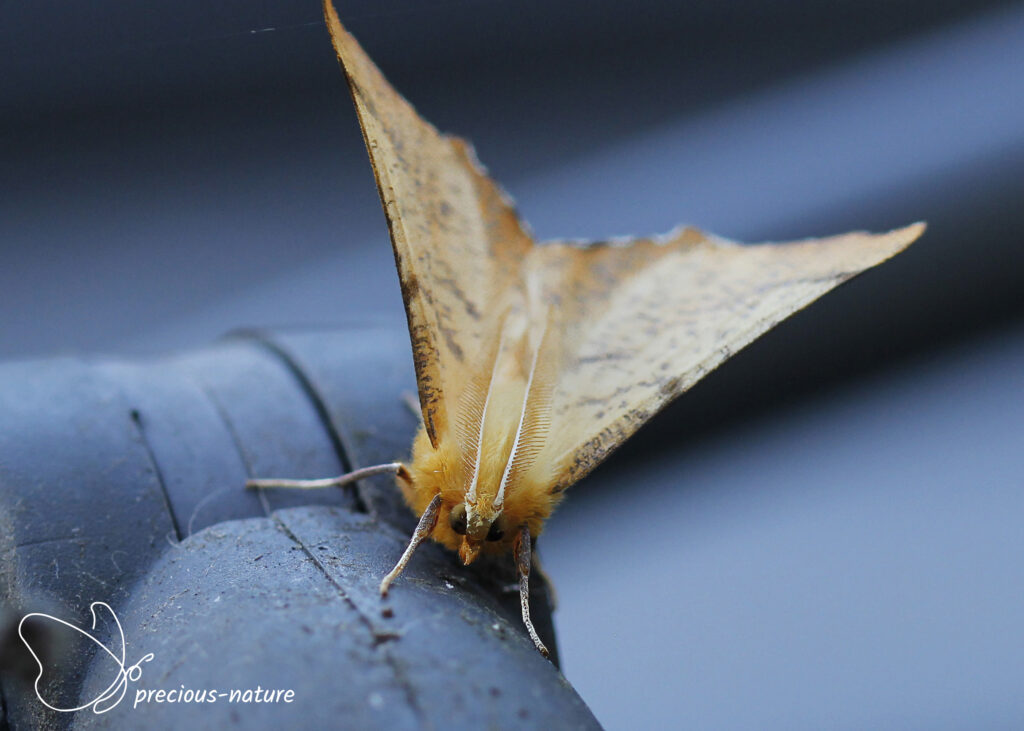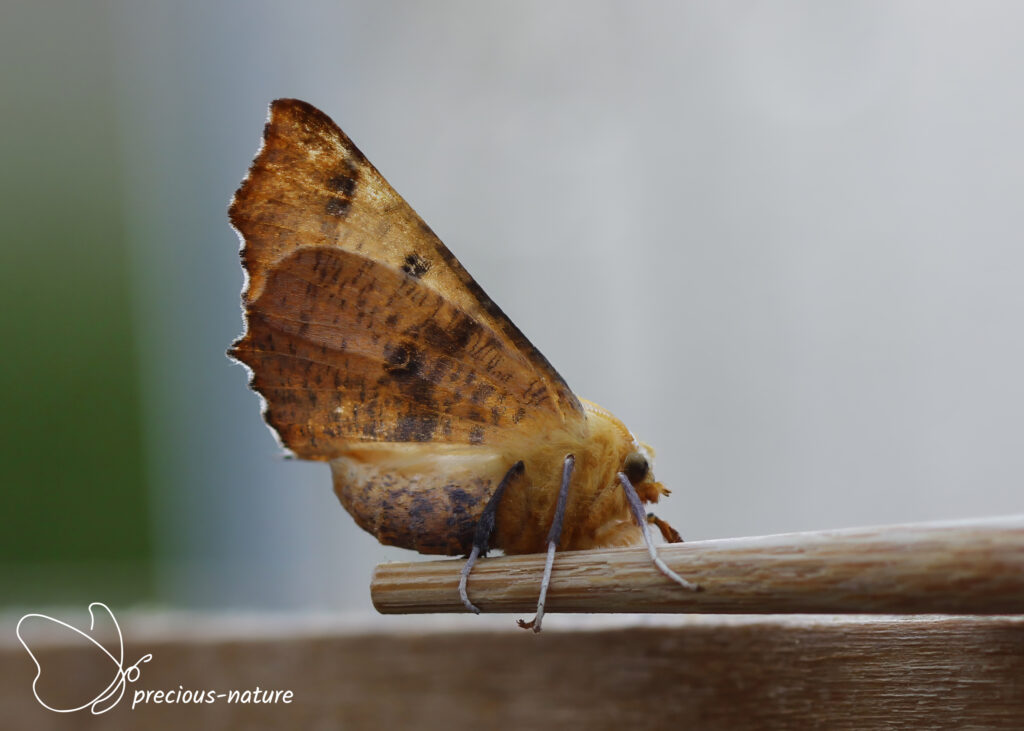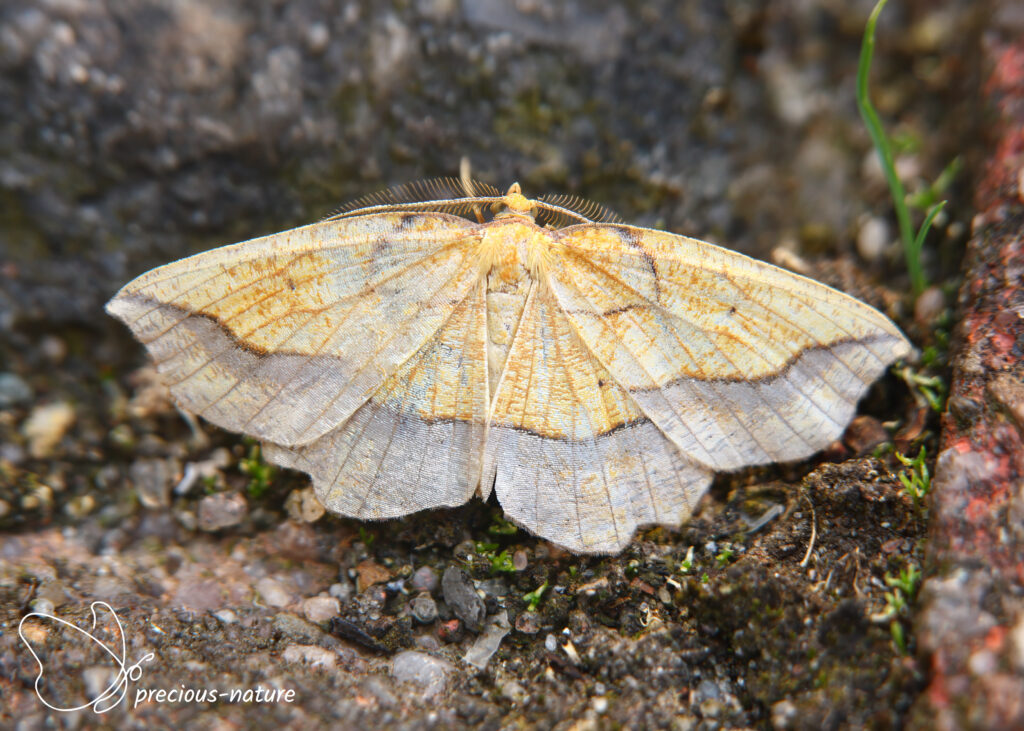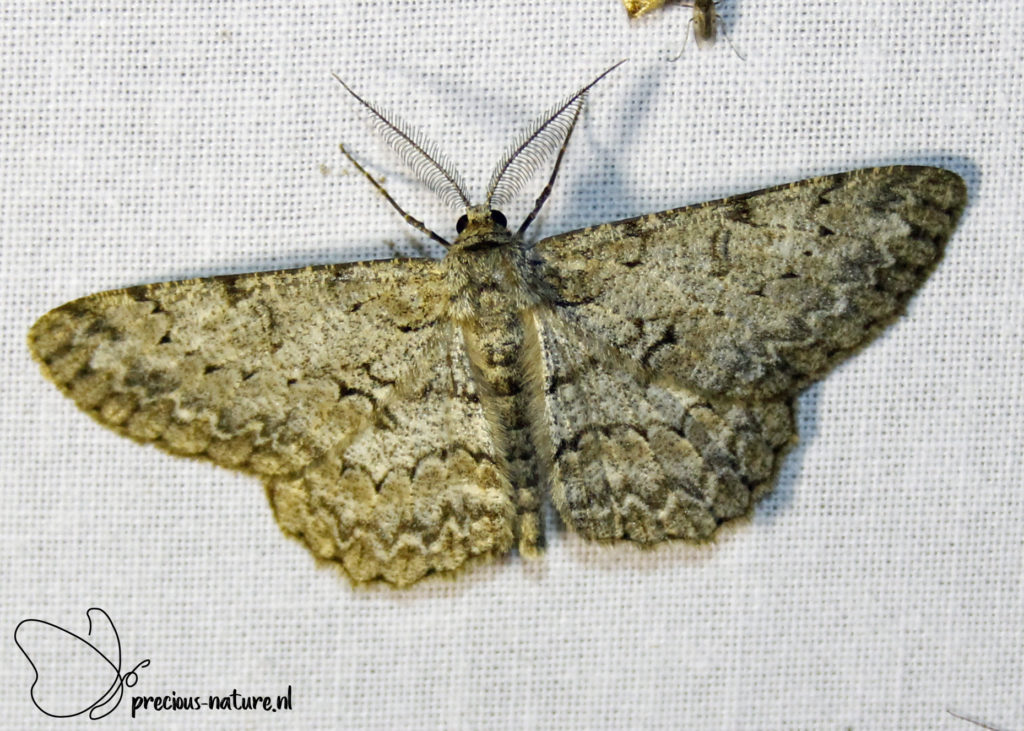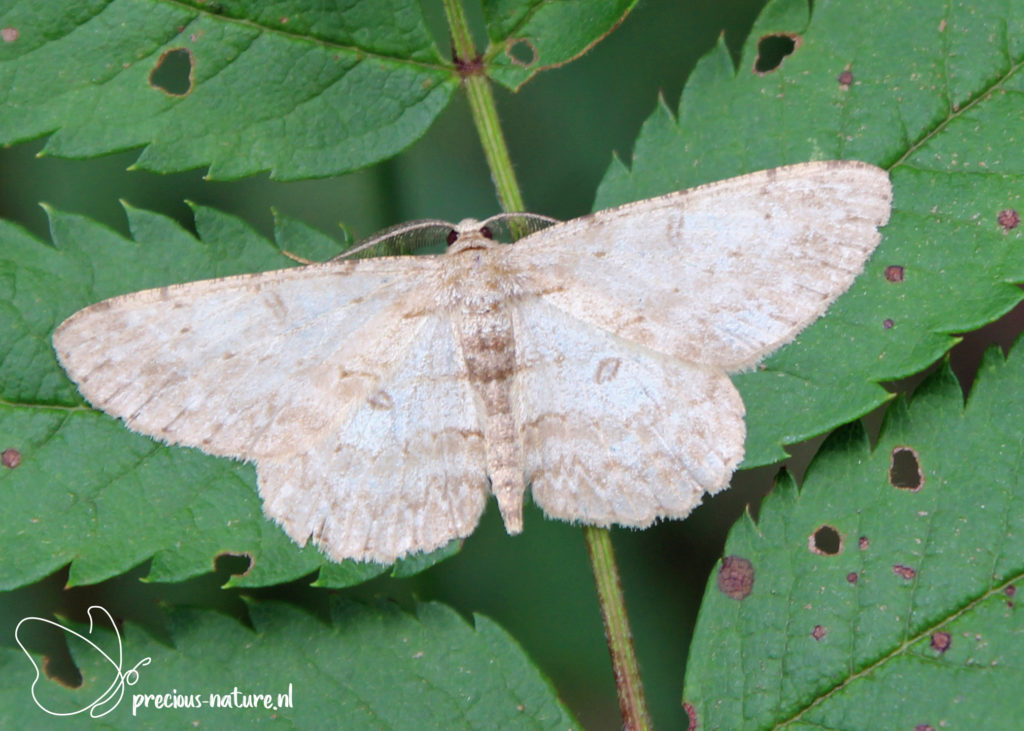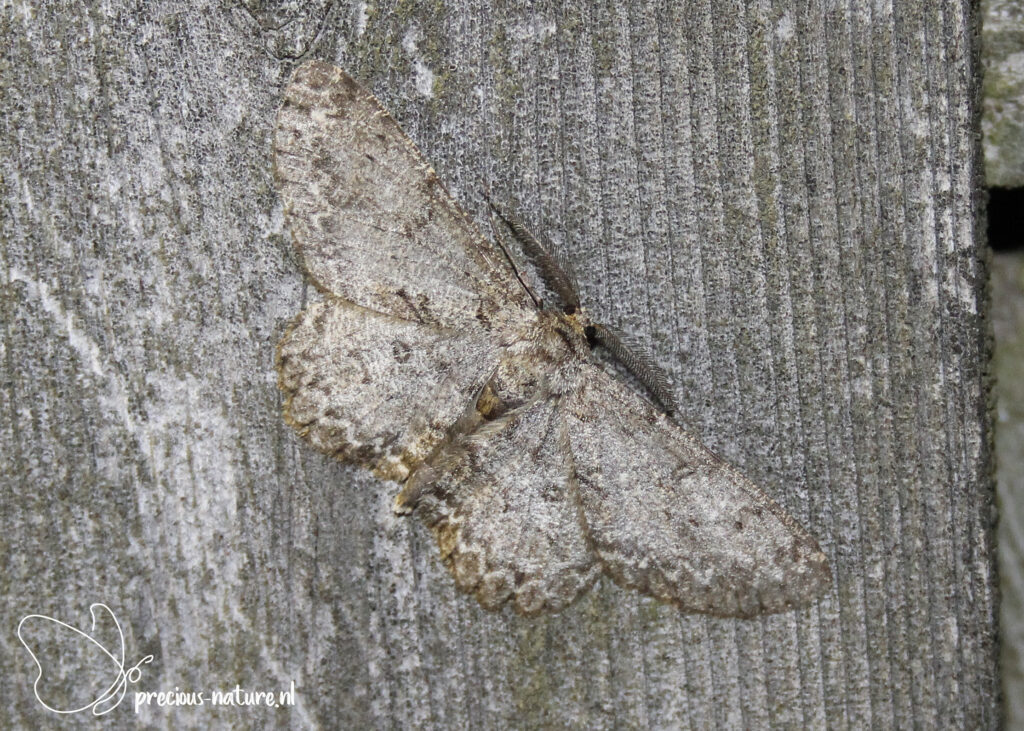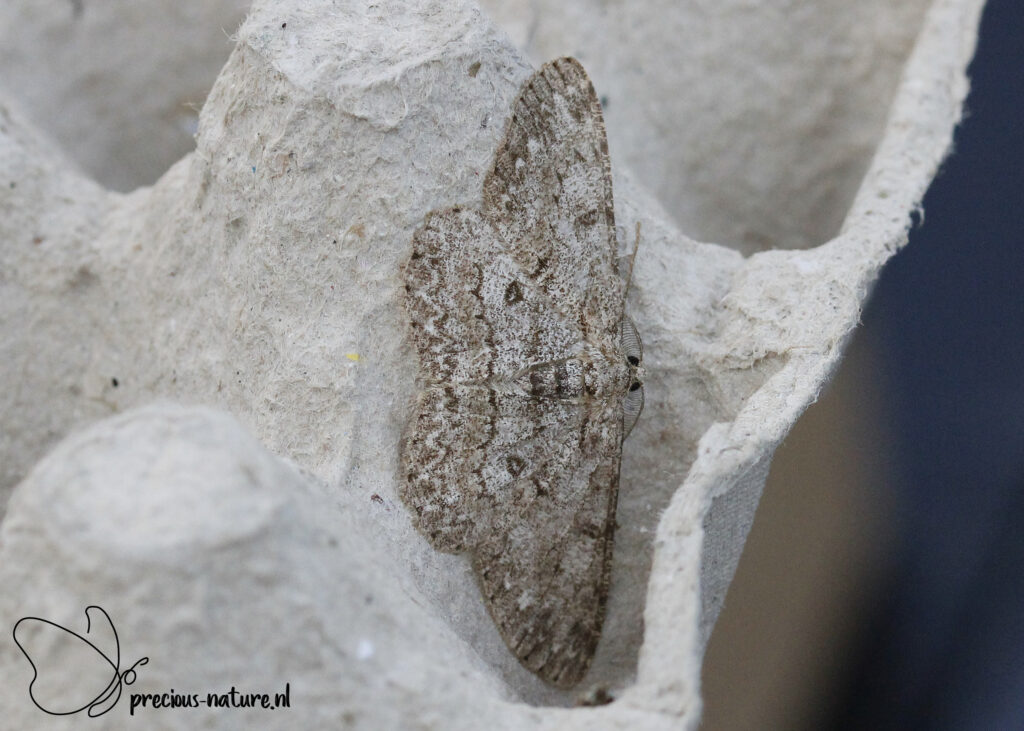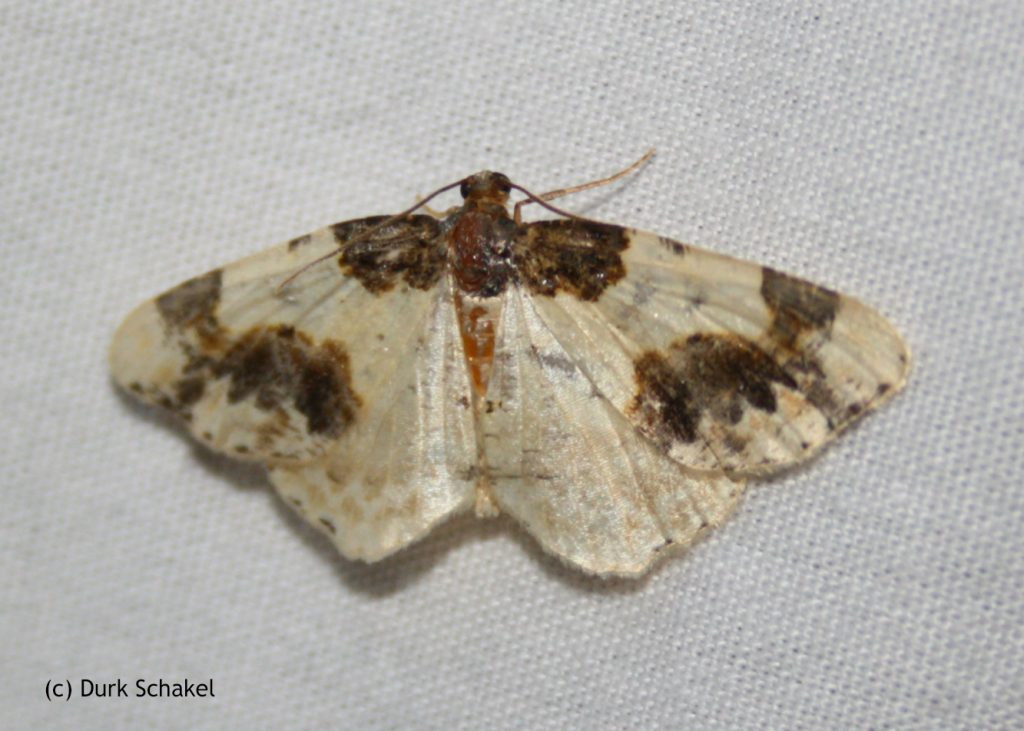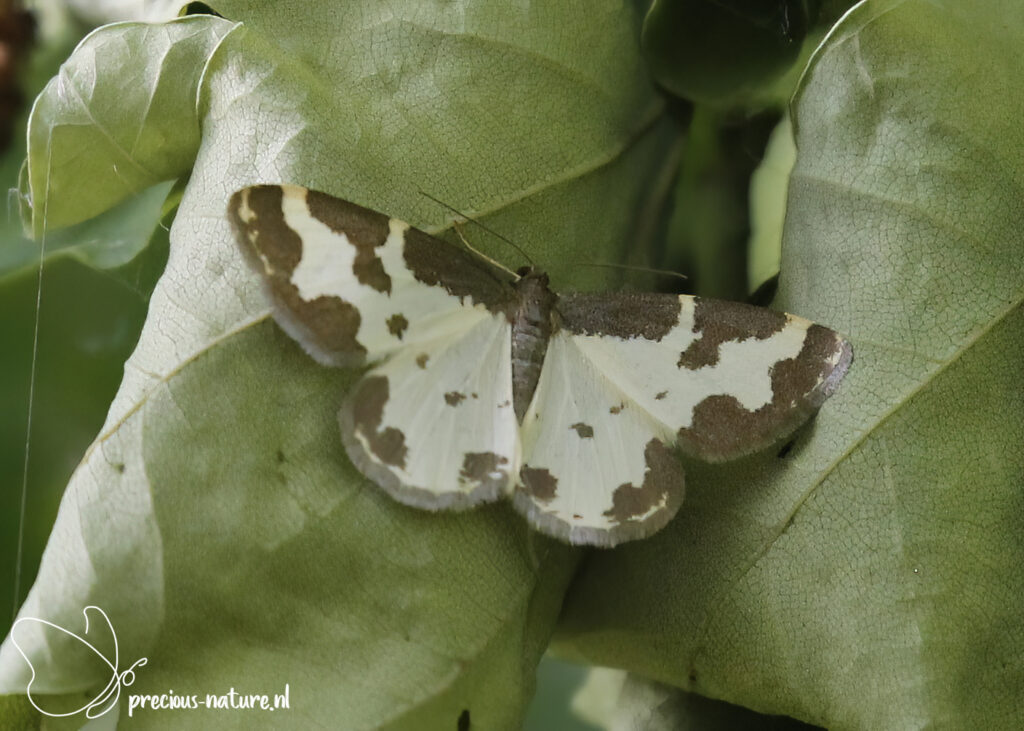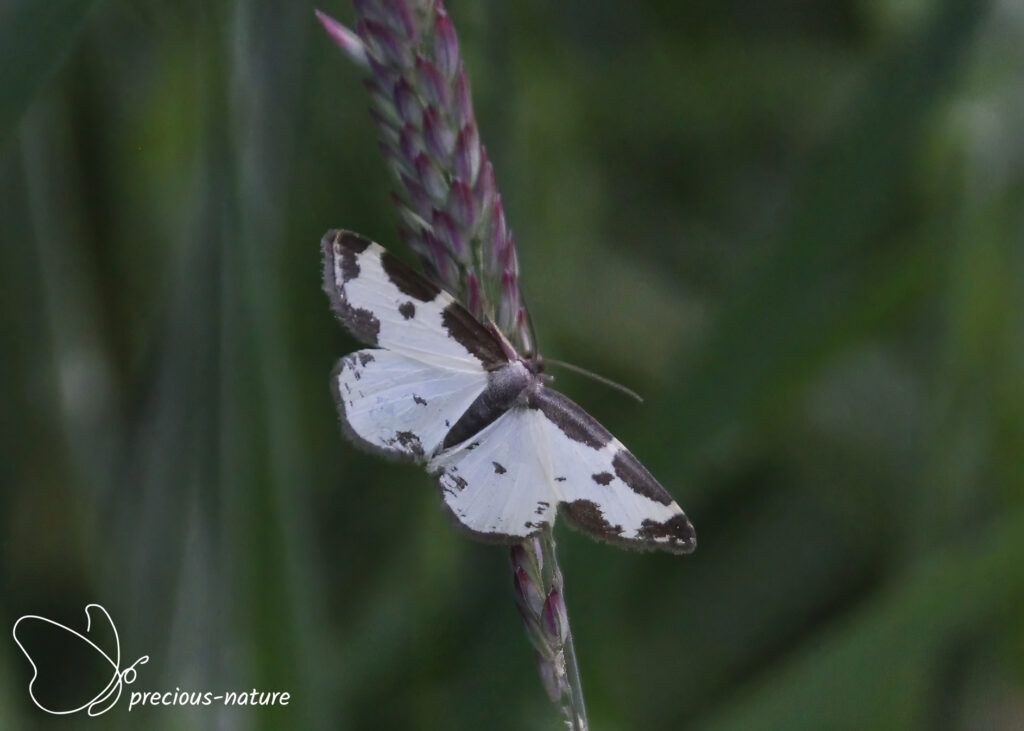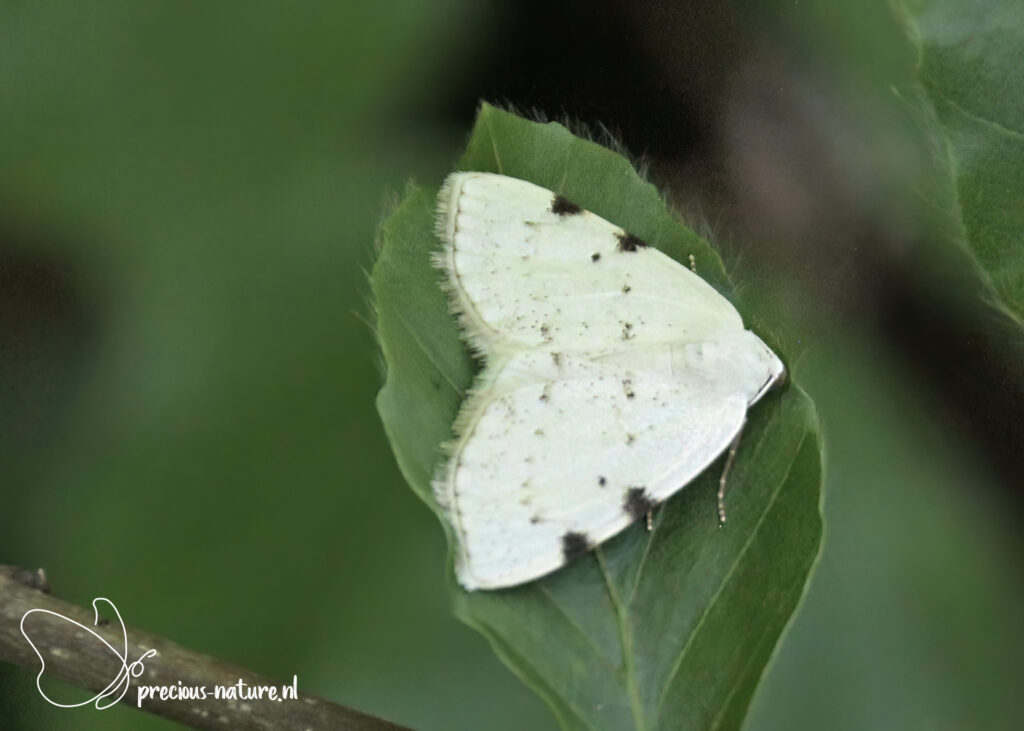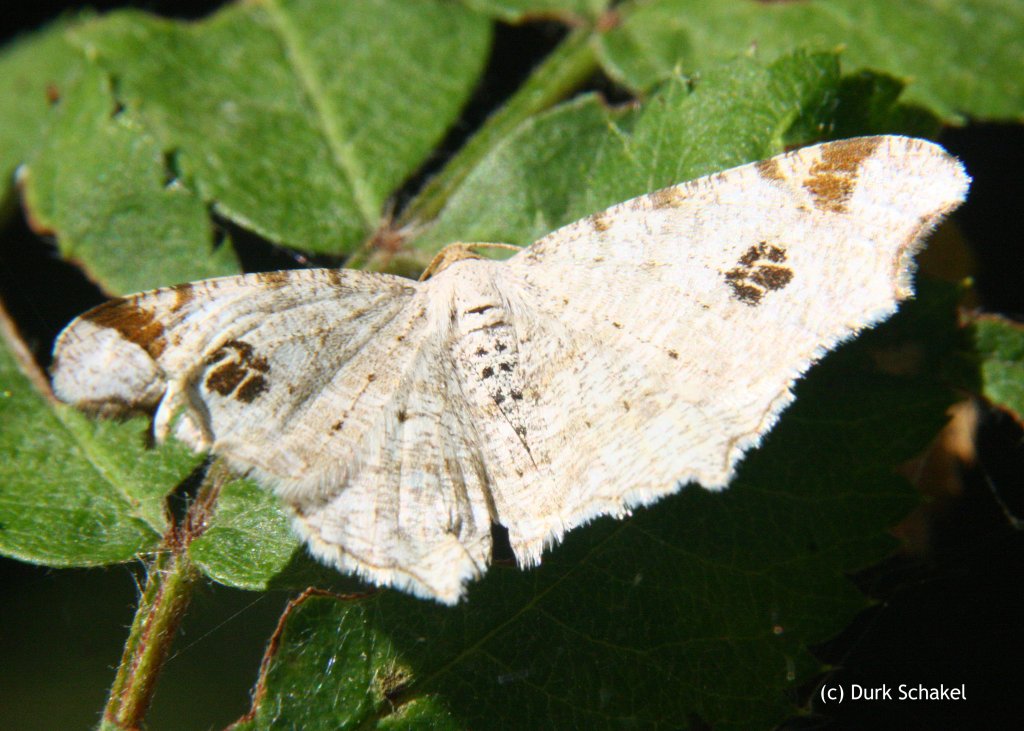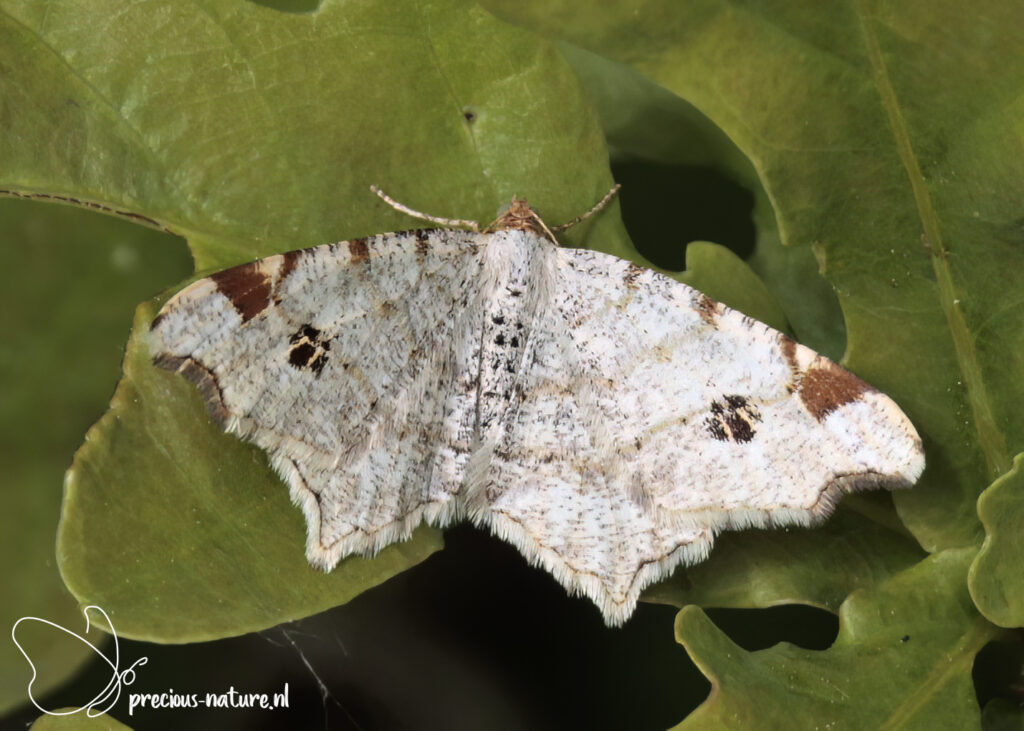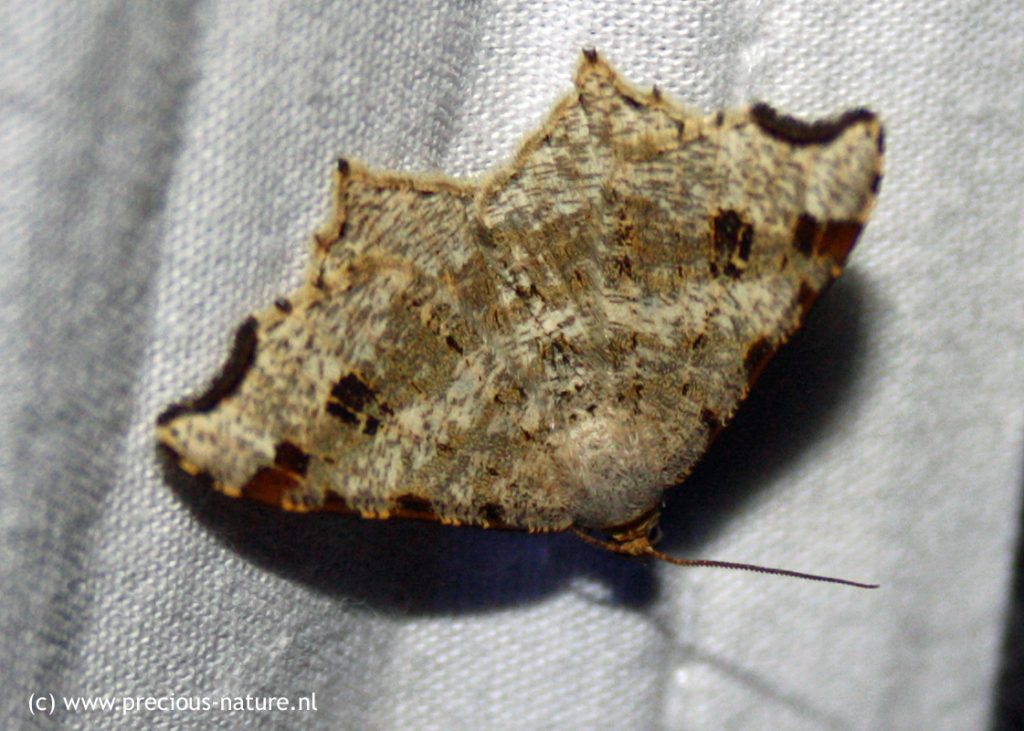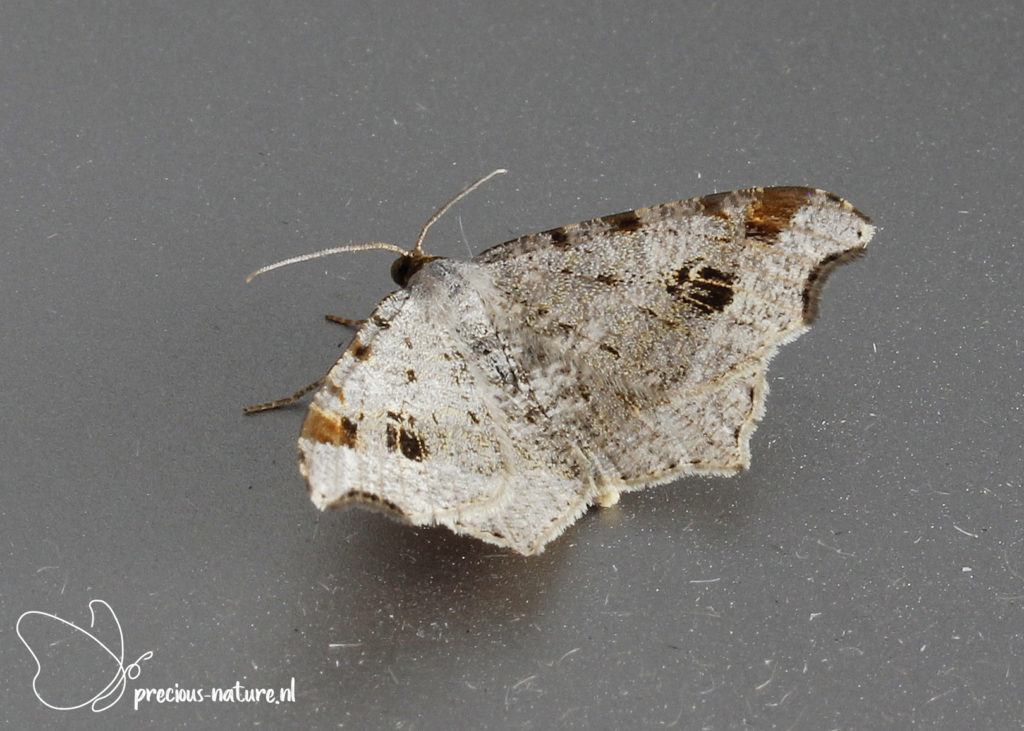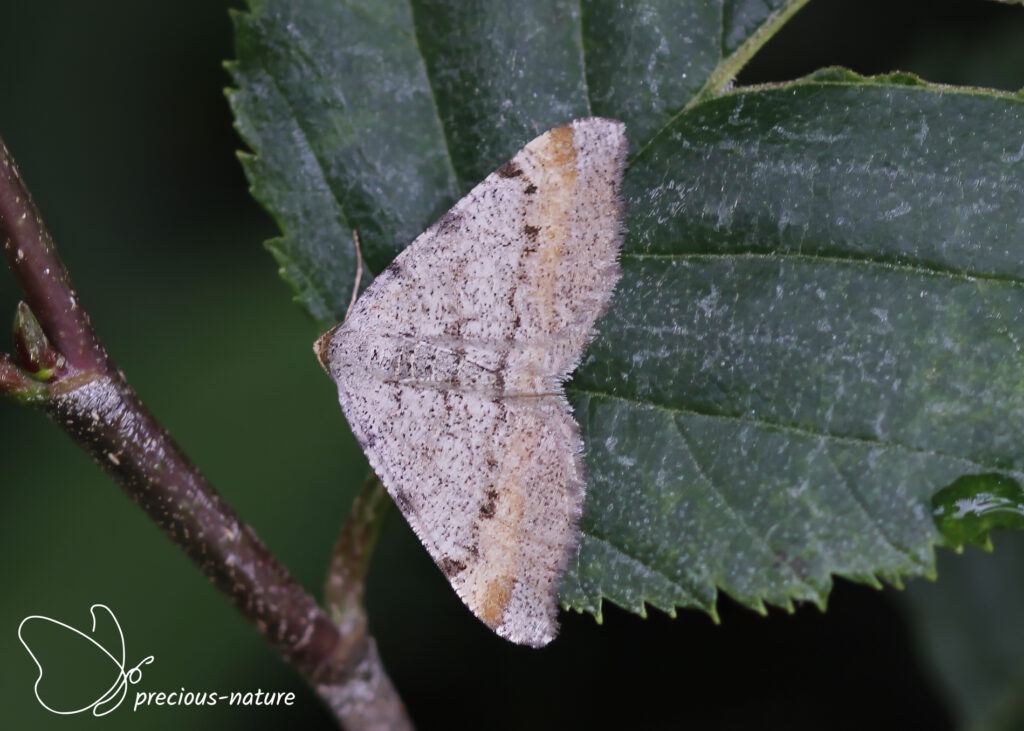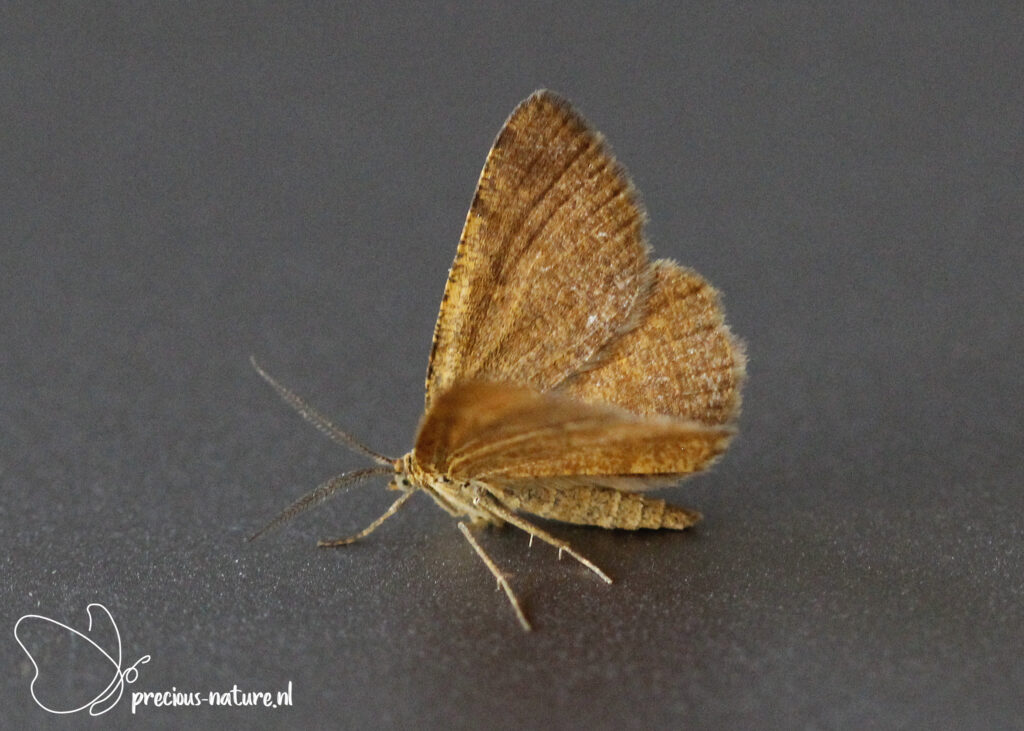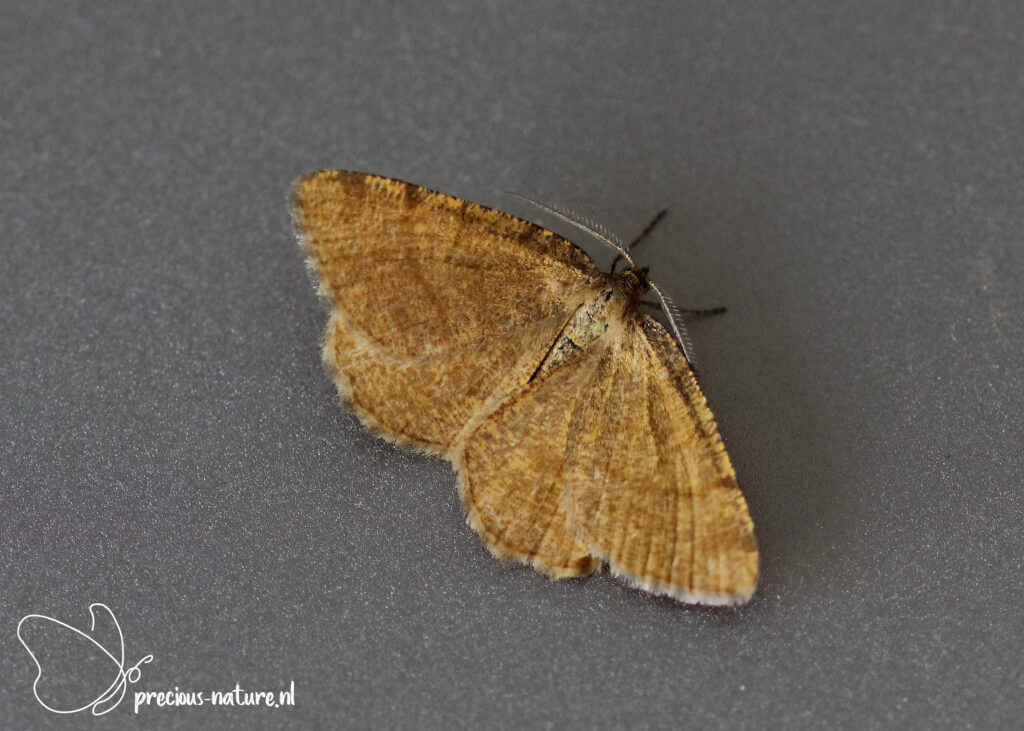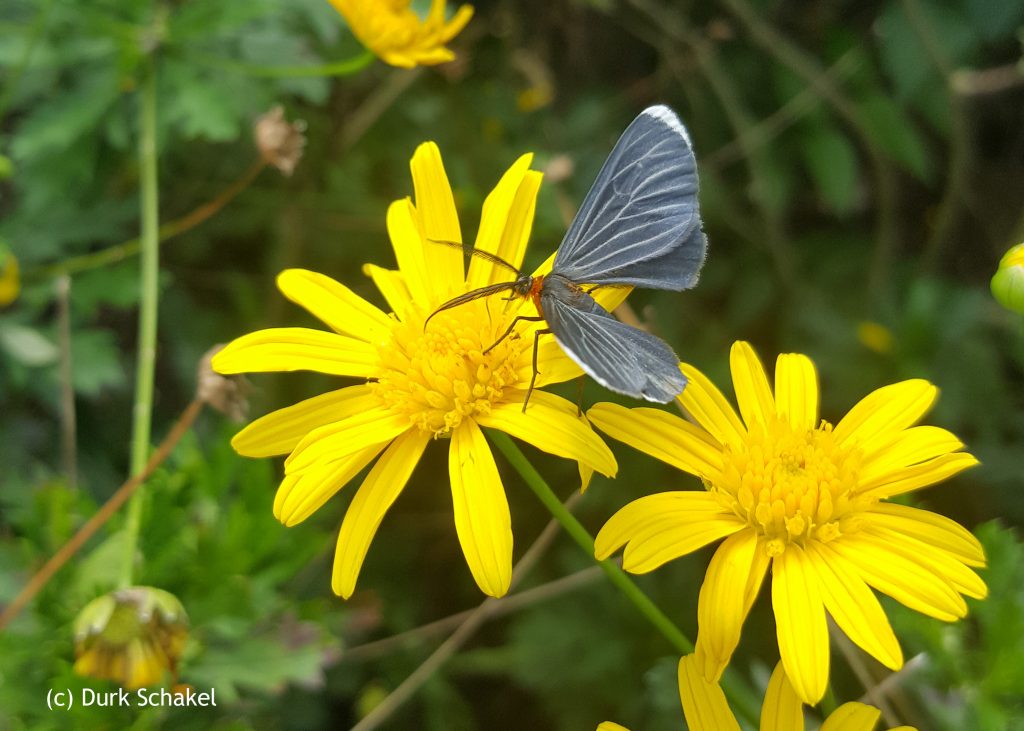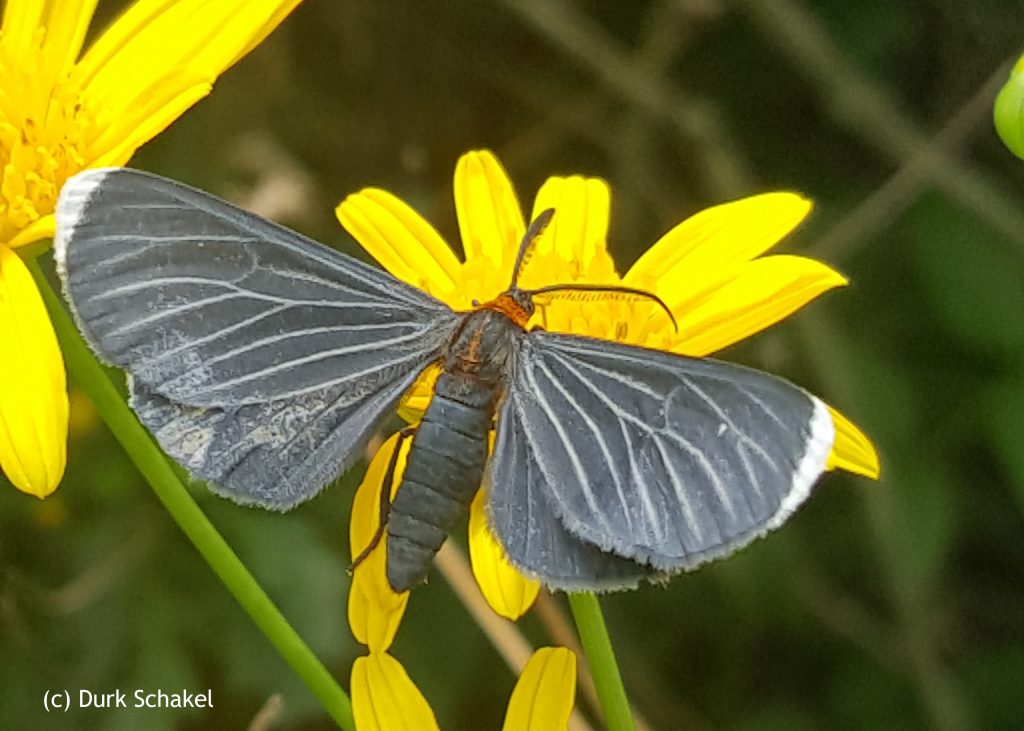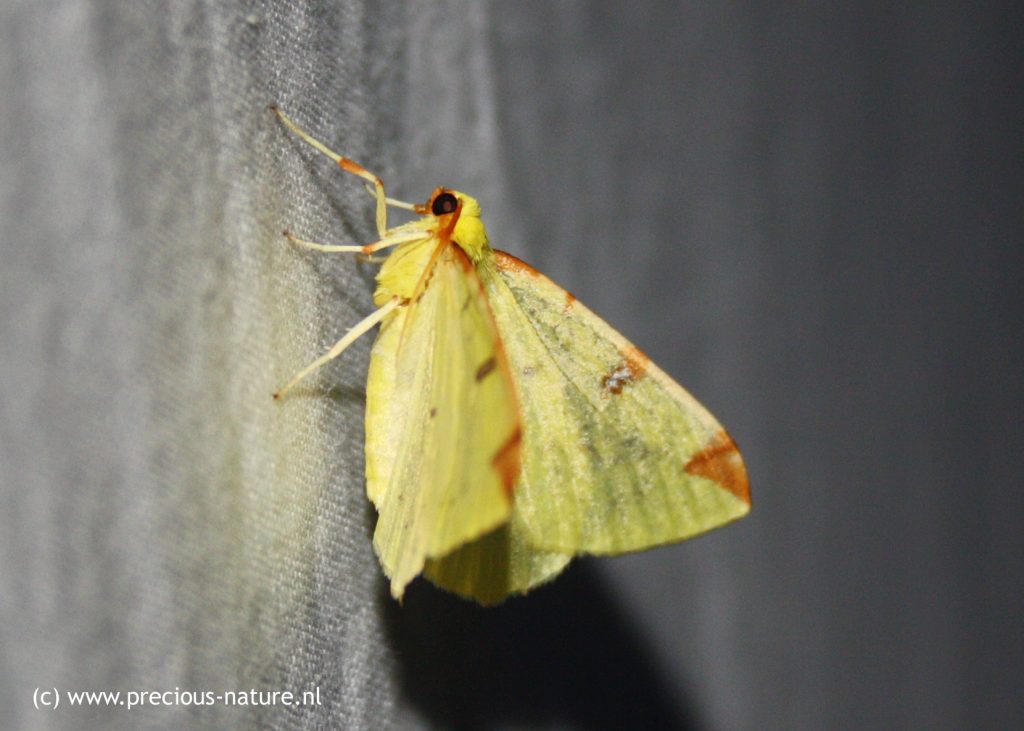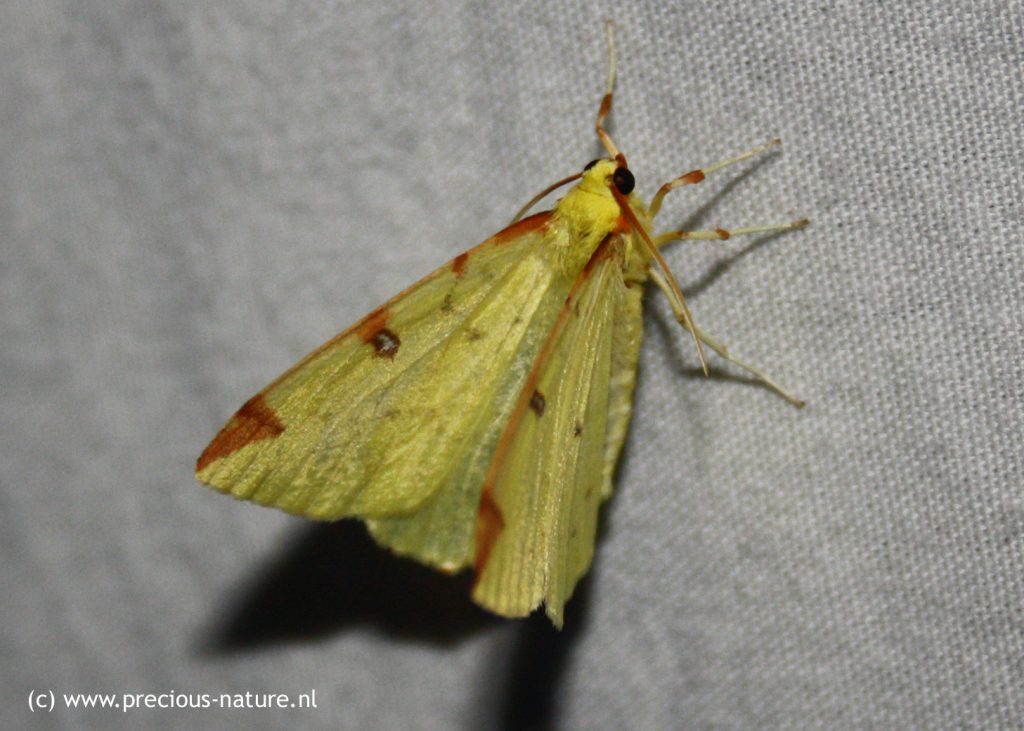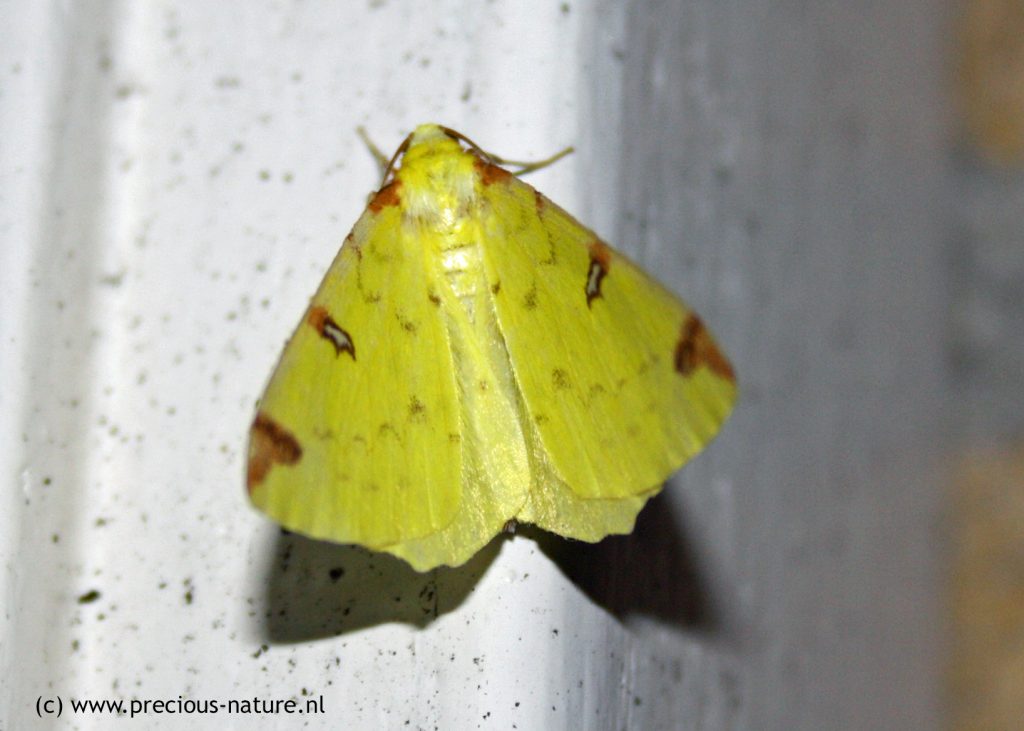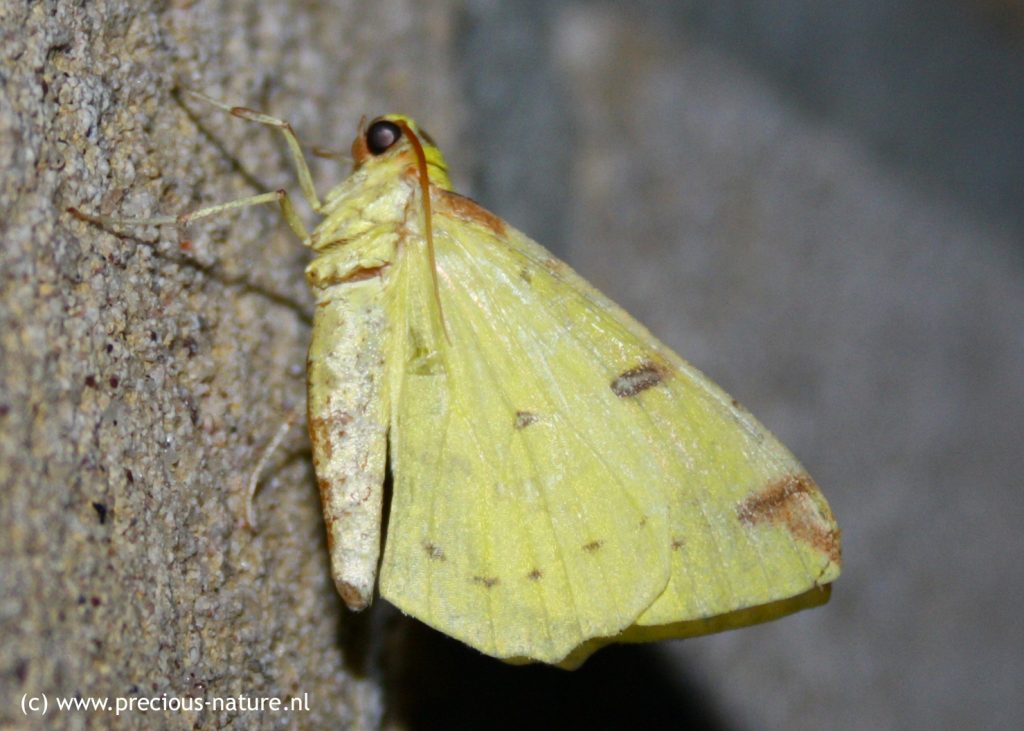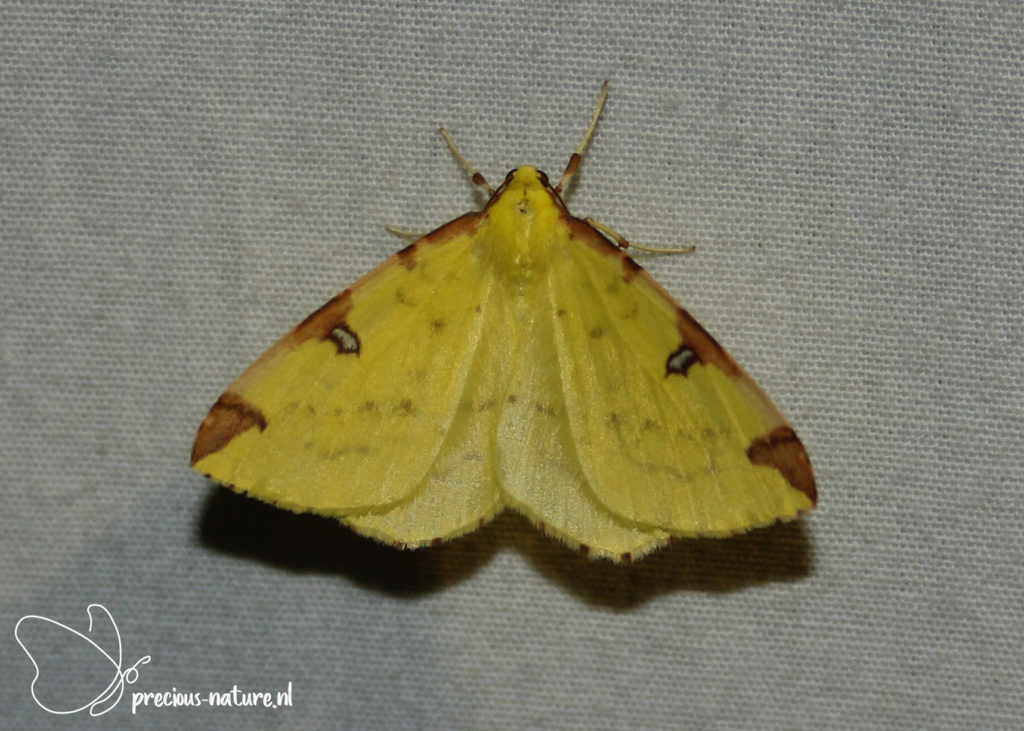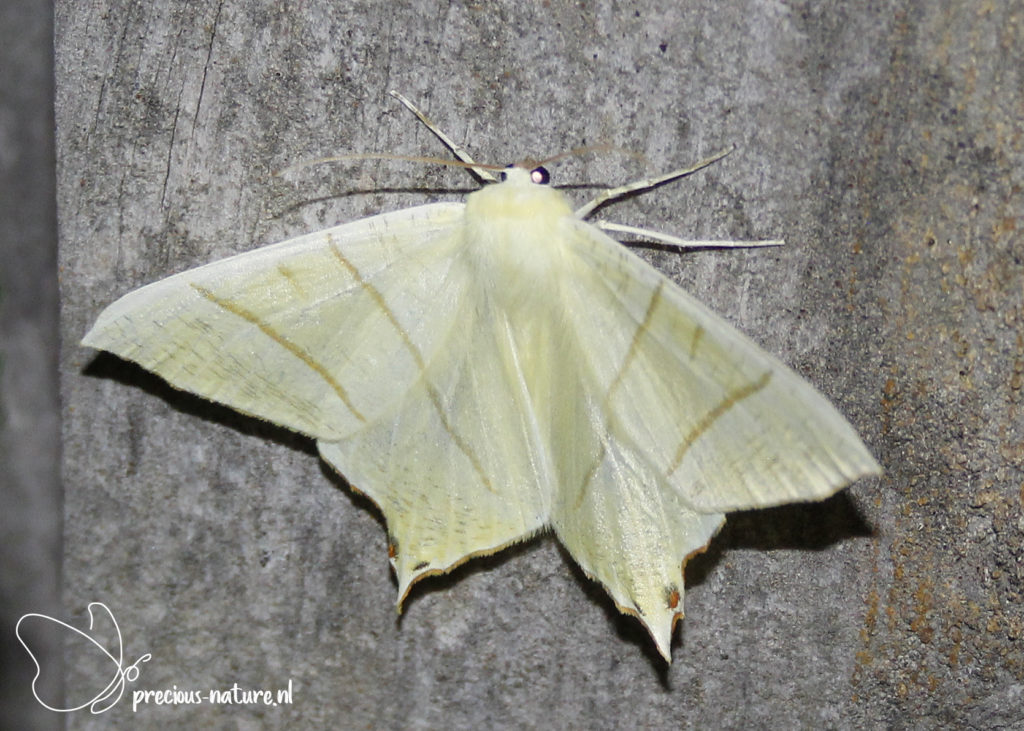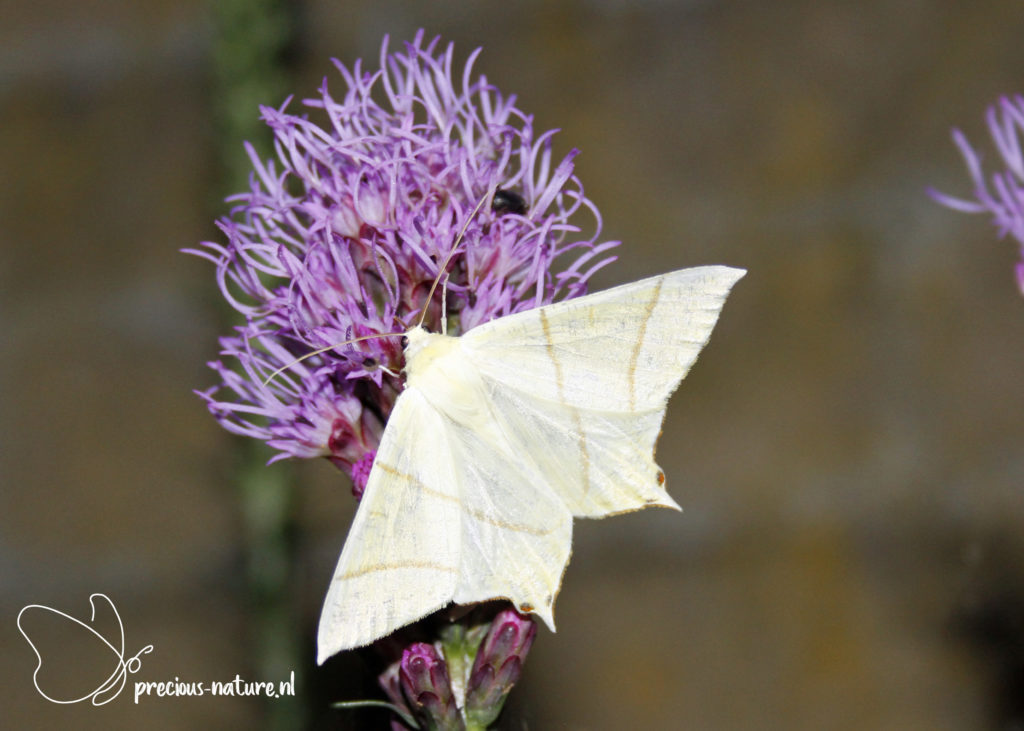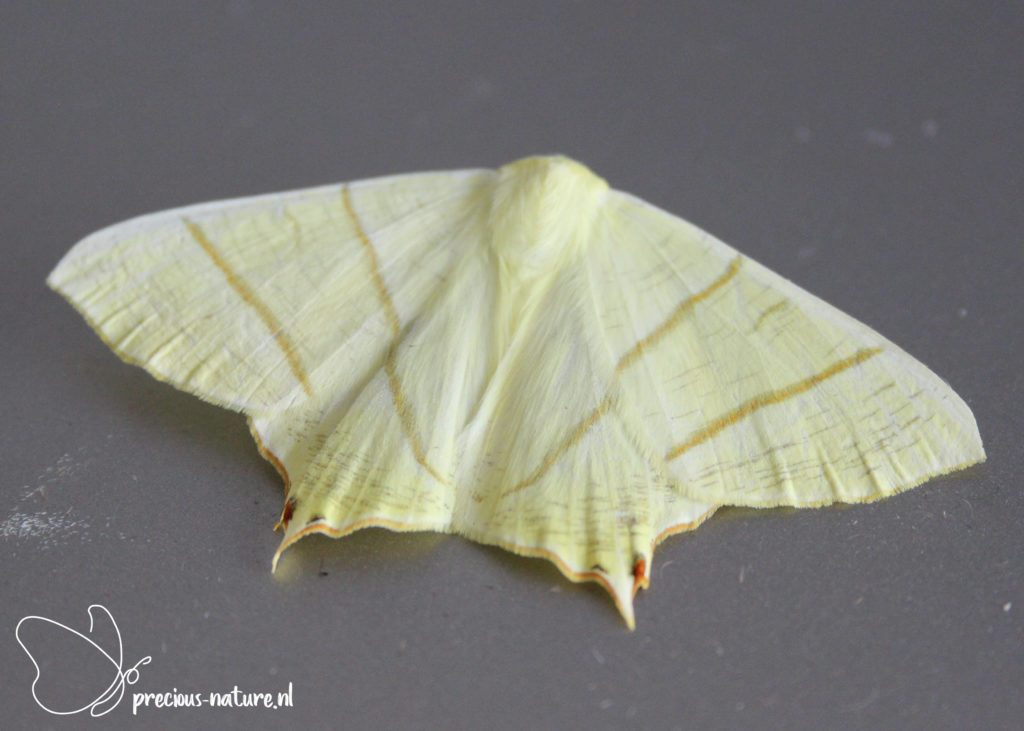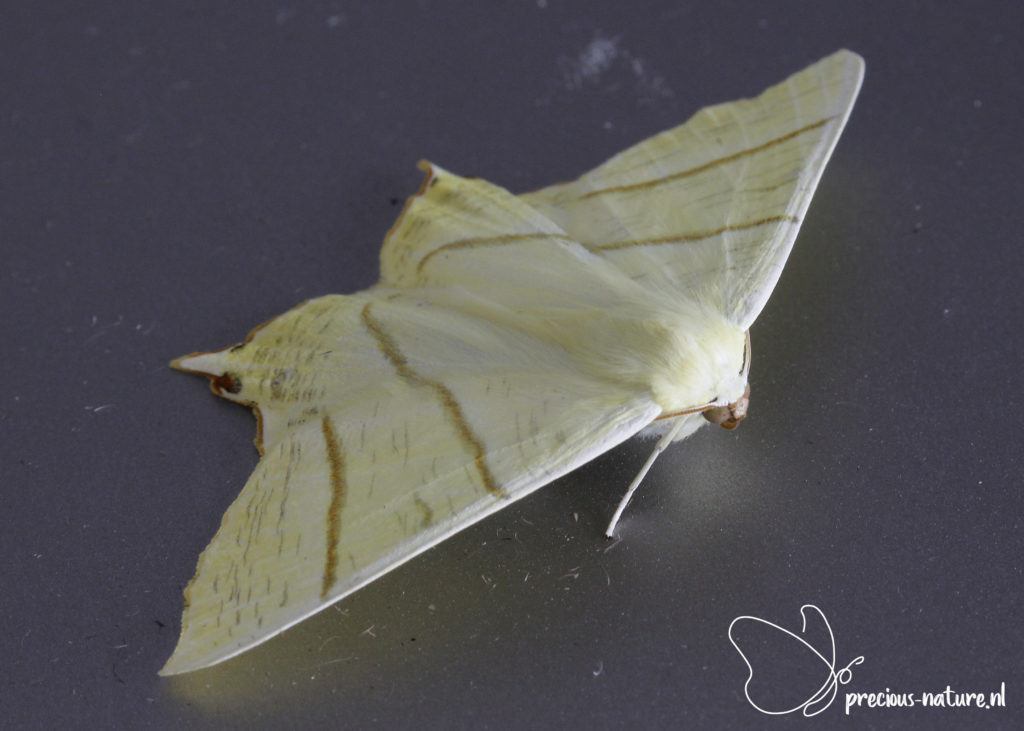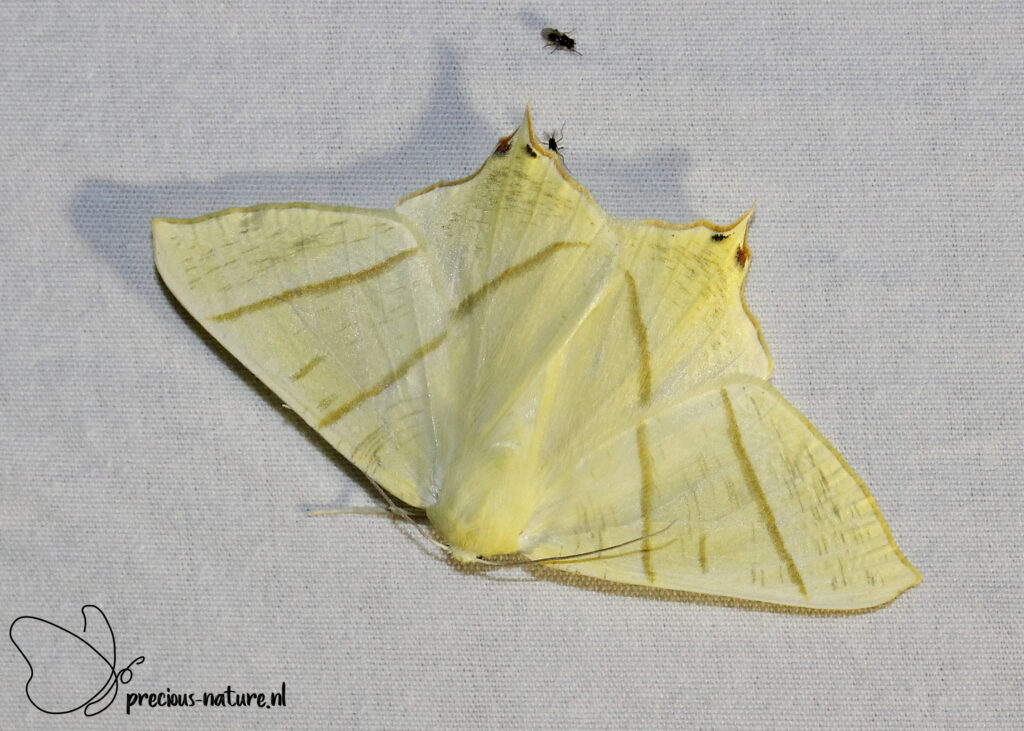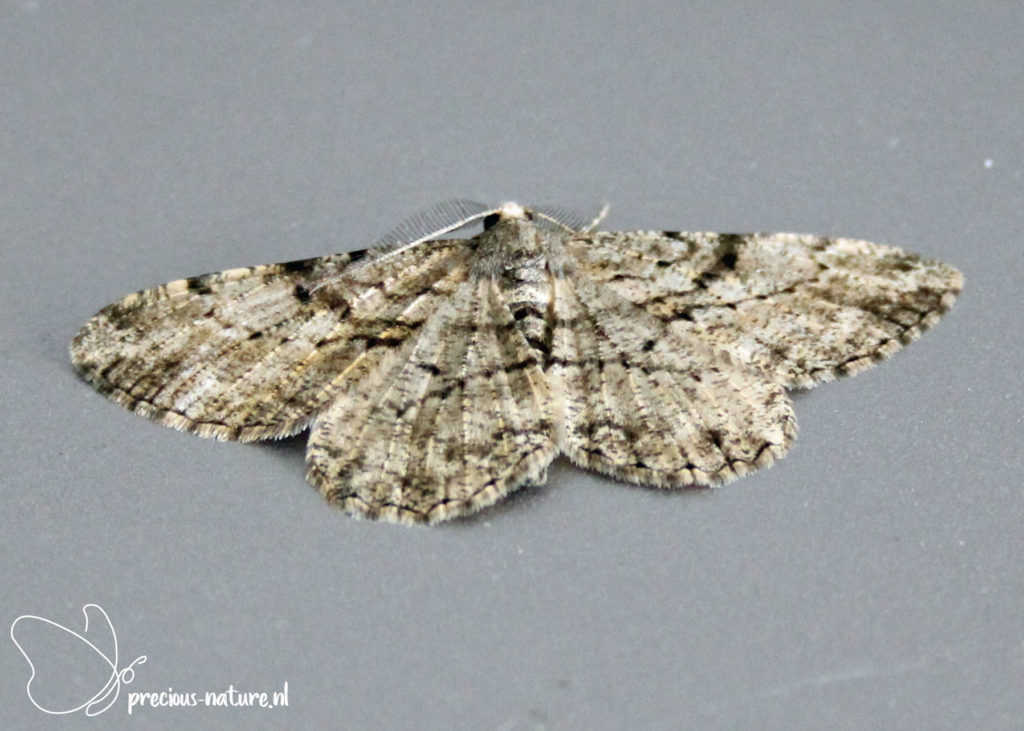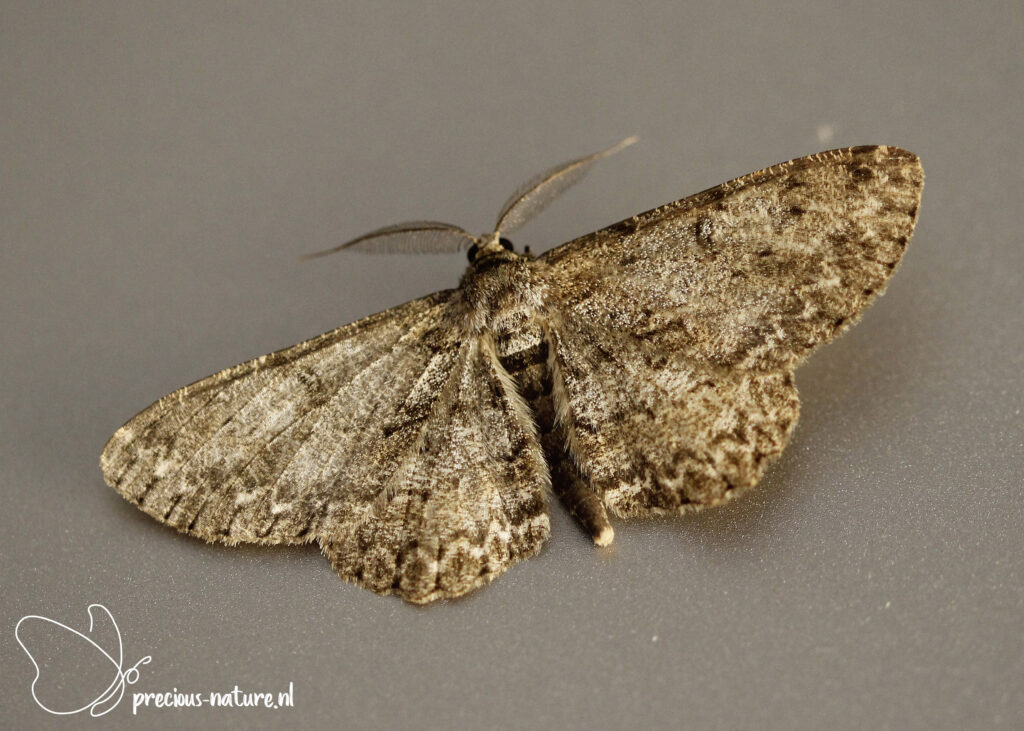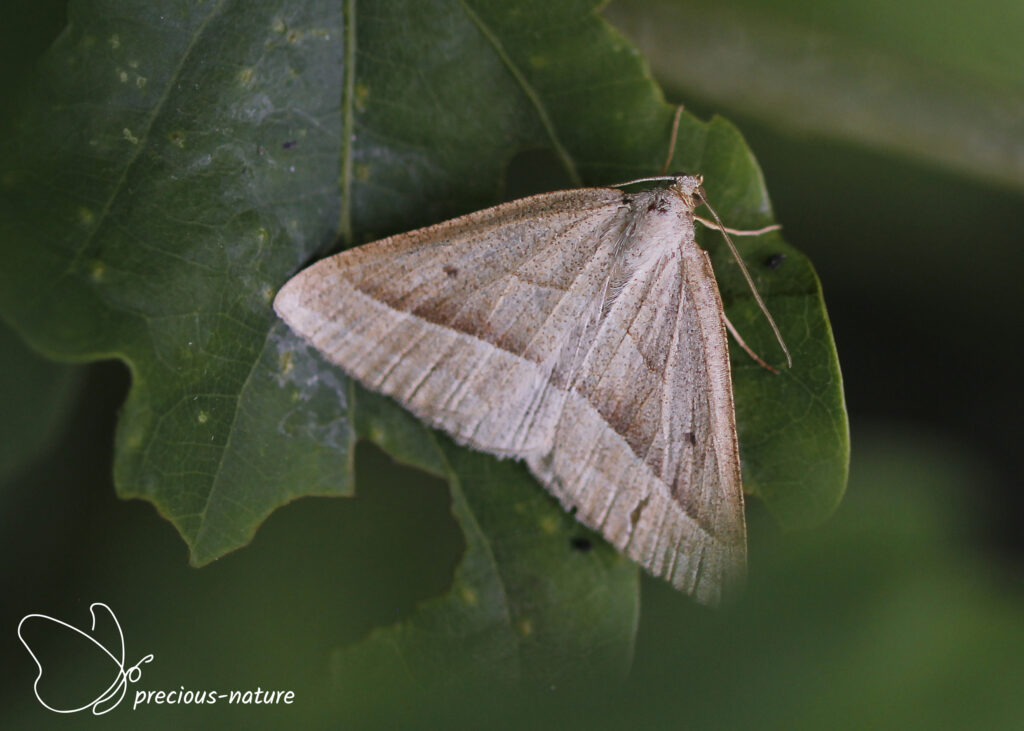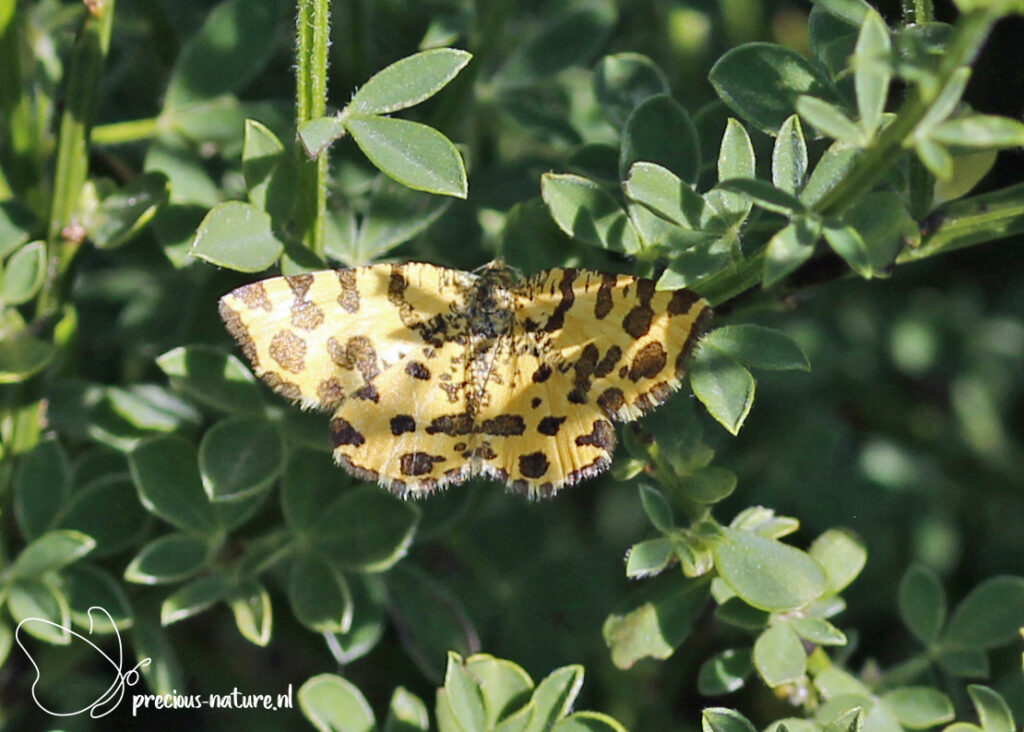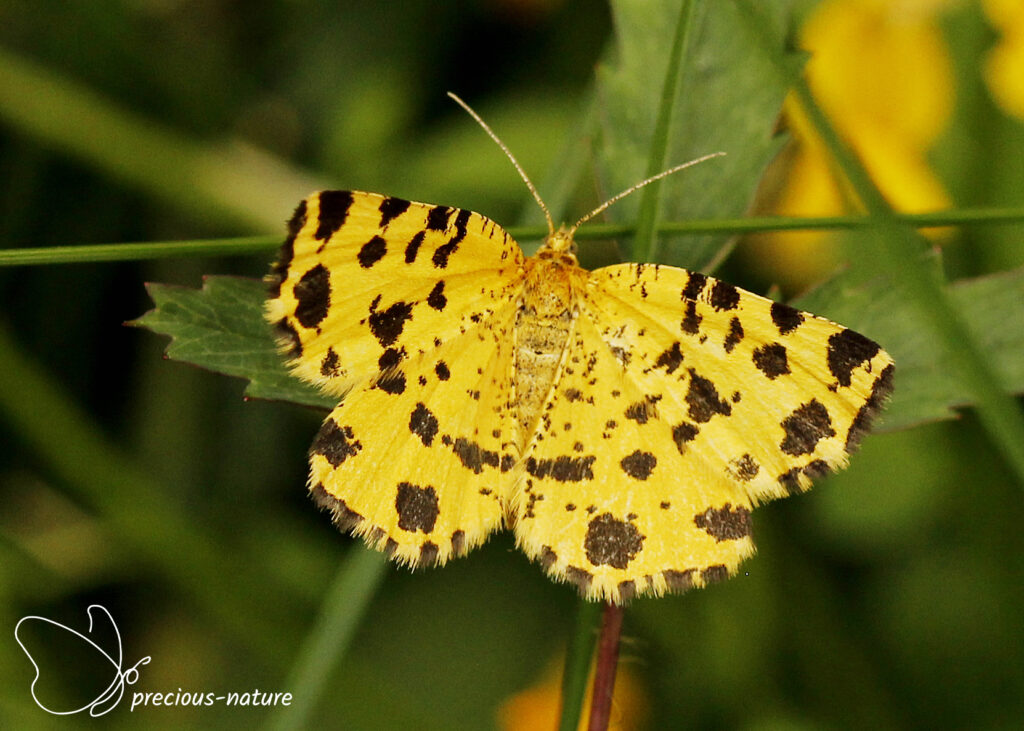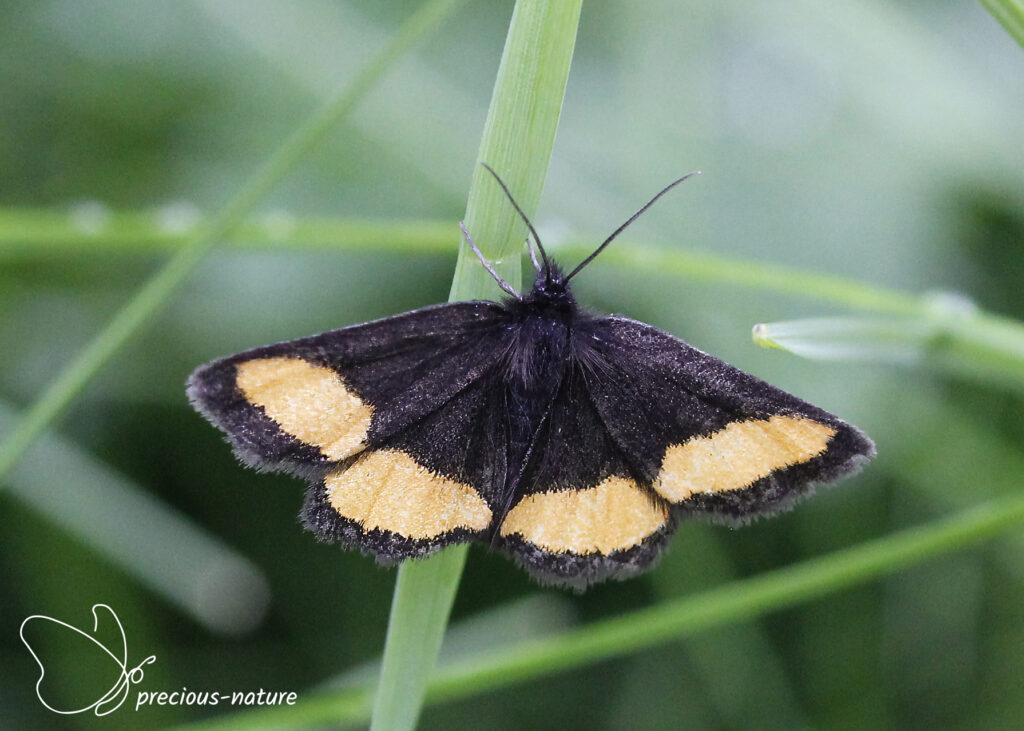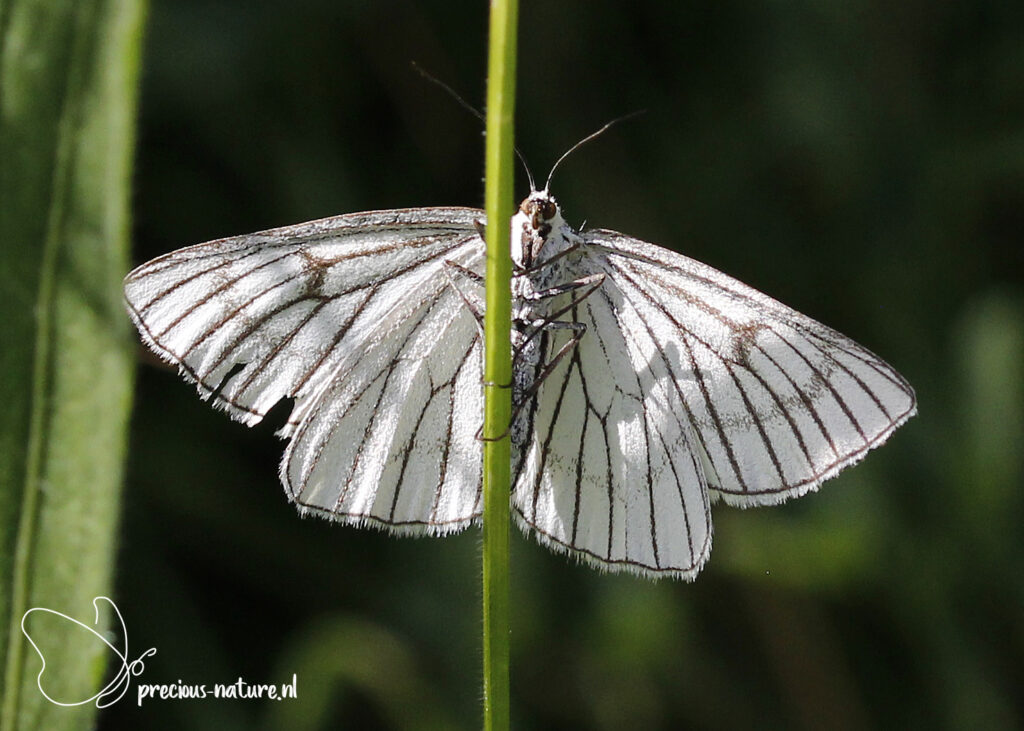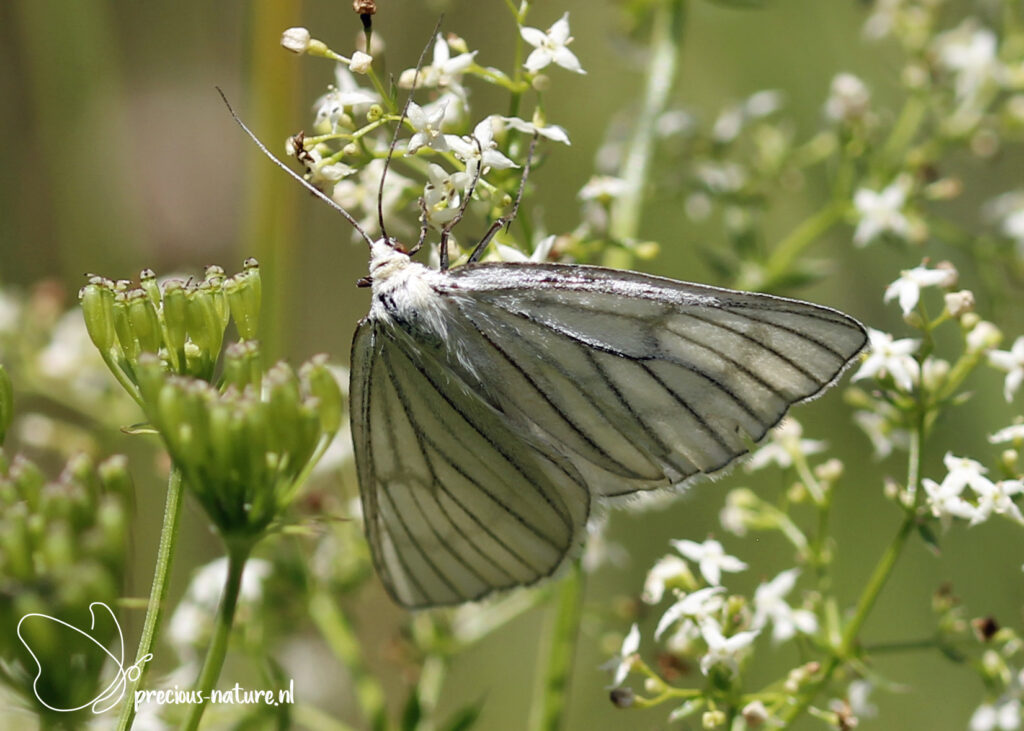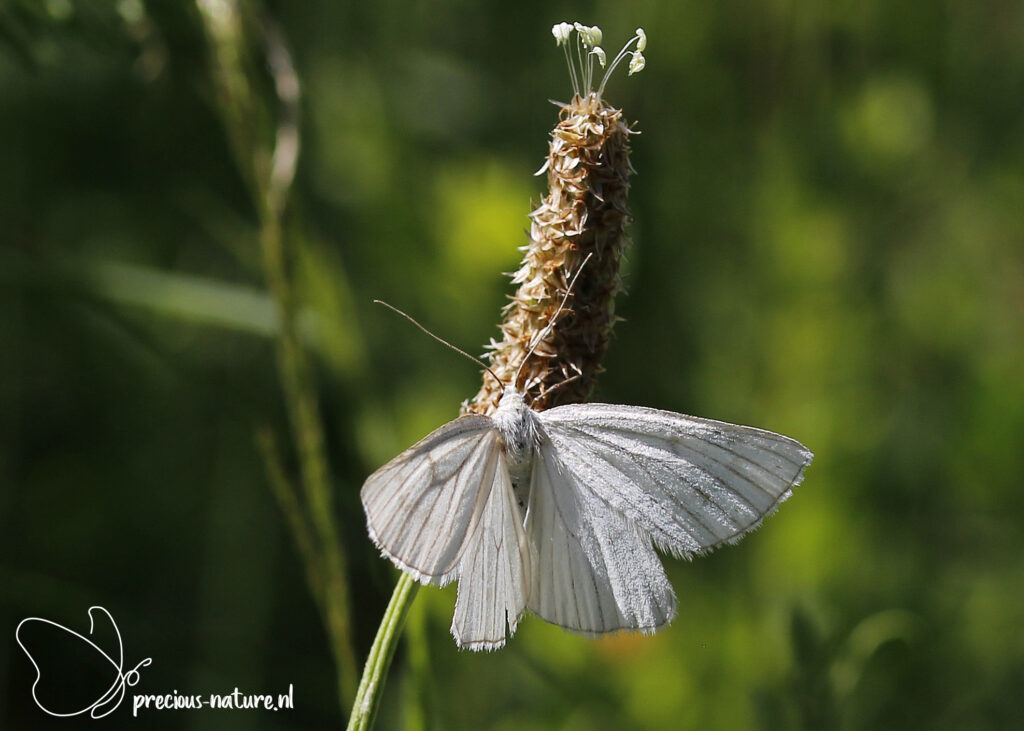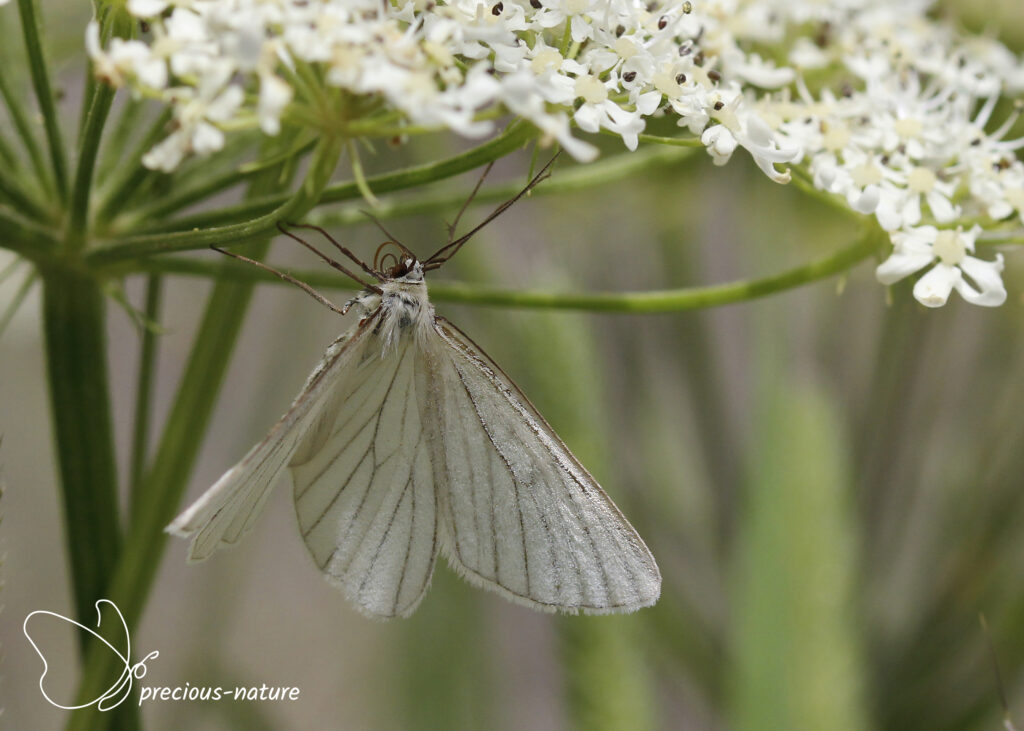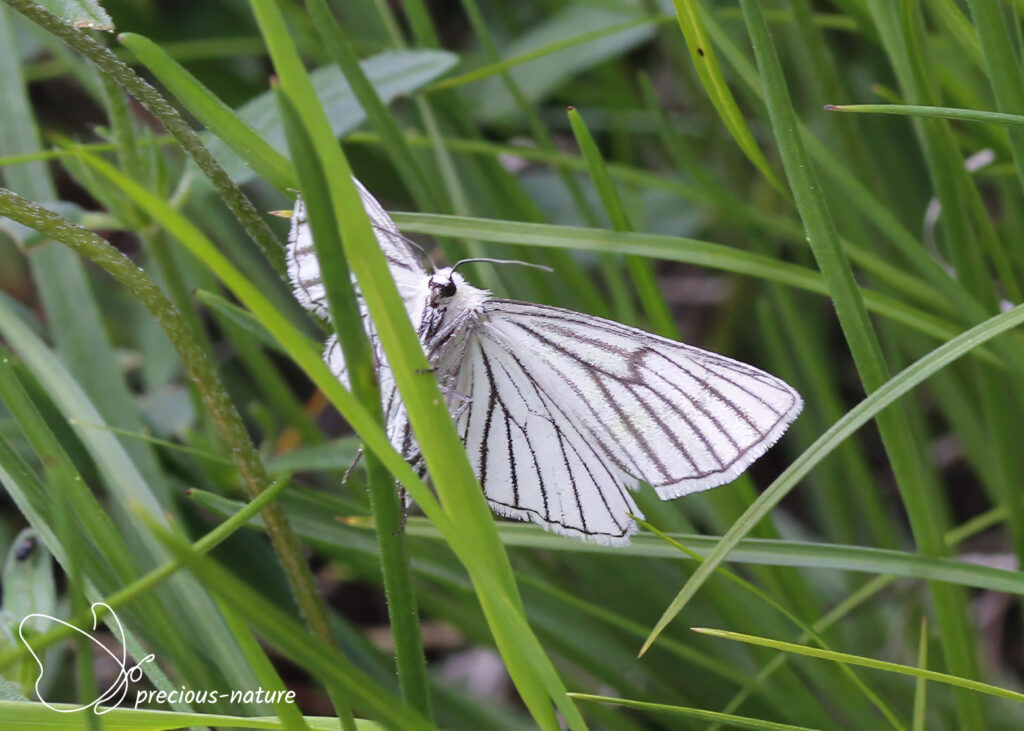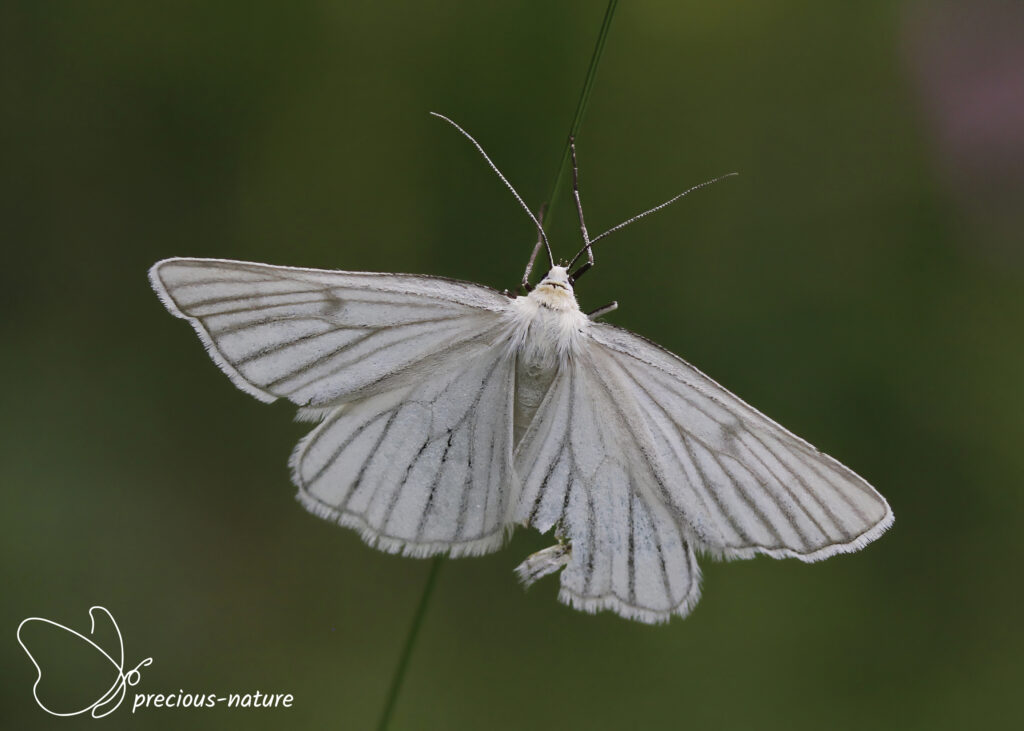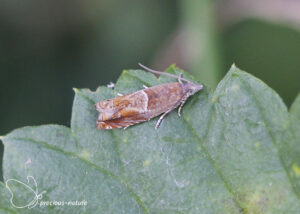Ennomines (Ennominae) is the largest subfamily of the Geometer Moths (Geometridae). They are usually quite small butterflies, although some can grow larger. This subfamily is characterised by the absence of vein M2 in the hindwing.
Genus: Abraxas
Clouded Magpie – 2017 (NL)
(NCBI-index: 190335)
The Clouded Magpie (Abraxas sylvata) flies in one and sometimes in two generations from May to September. This geometer moth rests with partially spread wings. The body is yellow with a black dot pattern, and the wings are mainly white with a black and orange spot pattern on the inner edge of the forewing. The wingspan is 35-44 mm. They fly as soon as it starts to get dim. In 2017, I came across around 15 at the same time, early in the morning, fluttering around some beeches. Host plant: Elm, Beech. Dutch name: Porseleinvlinder. Frisian name: Porsleinflinter.
Flying period:

Genus: Abraxas
Magpie – 2017 (NL)
(NCBI-index: 1.007343)
The Magpie (Abraxas grossulariata) is a very strikingly coloured moth. Like its relative, the body is the Clouded Magpie (Abraxas sylvata), yellow with a black dot pattern. However, the wings are even more dotted with black dots along all edges of the wings and the centerline over the wings. Orange colour can be seen between the dots and stripes on this median line and close to the head in the base. The wingspan is 36-50 mm. It flies in one generation from May to September. Host plant: Blackthorn, Hawthorn, Hazel, Garden Privet, Spindle, Bramble. Dutch name: Bonte bessenvlinder. Frisian name: Bûnte beiflinter.
Flying period:

Genus: Alcis
Mottled Beauty – 2023 (BE)
(NCBI-index: 174269)
Even though it is a moth, you are sometimes lucky enough to encounter the Mottled Beauty (Alcis repandata) during the day, despite its camouflage colour, resting on a tree trunk. The best feature, except in extremely dark or light specimens, is the dark outer transverse line on the forewing. This transverse line runs in large arcs across the top of the forewing. This line is continuous and noticeably wavy. The last curve before the leading edge is noticeably large and shaped like a crescent moon. The central transverse line is usually faint but often forms a dark spot in the front half of the wing, together with the central spot. It is a very variable butterfly, occurring in all shades of grey, often mixed with brown. Light specimens sometimes have a dark central band on the fore and hind wings. The hindwing has a scalloped trailing edge. The flight period spans one generation, from early May to mid-August, and the wingspan ranges from 30 to 45 mm. Host plant: various trees and shrubs. Dutch name: Variabele spikkelspanner. Frisian name: –
Flying period:

Genus: Biston
Peppered Moth – 2018 (NL)
(NCBI-index: 82595)
A fairly large carpet that can come in two completely different colour forms is the Peppered Moth (Biston betularia). The normal colour of this geometer moth is black with white salt and pepper markings. However, there are also specimens whose wings are black-brown, where you can see the dark veins in the wings, the “carbonaria”. These specimens were once dominant in industrial areas with high levels of pollution. The abdomen is fairly wide, and many hairs can be seen on the thorax. The flight period spans from May to mid-August in one generation, and the wingspan ranges from 44 to 56 mm. Host plant: Blackthorn, Hawthorn, Birch, Lime, Poplar, Oak. Dutch name: Peper-en-zoutvlinder. Frisian name: Bjirkespanner.
Flying period:

Genus: Bupalus
Bordered White – 2020 (NL)
(NCBI-index: 104490)
During a moth session in a nature reserve with many trees, the Bordered White (Bupalus piniaria) was attracted to the bright light. In the resting position, this geometer moth keeps its wings folded, unlike many other geometer moths. The white longitudinal stripe and dark transverse lines on the bottom of the hindwing are visible. In males, the ground colour of the top of the wings varies from white to yellow. A brown zone can be seen along the dorsum of both wings, which extends broadly at the apex of the forewing towards the costa. The female is more yellow-brown and lacks dark edges and a dark apex. The wingspan is 34-40 mm, and the flight period is from May to the end of July. Host plant: Pine. Dutch name: Dennenspanner. Frisian name: Dinnespanner.
Flying period:

Genus: Cabera
Common Wave – 2015 (NL)
(NCBI-index: 934826)
The Common Wave (Cabera exanthemata) is a light brown to brown-grey speckled white moth. The wings have light brown curved transverse lines, three on the forewing and two on the hindwing. The speckle on the wings varies in intensity. The speckling is usually stronger in the female. This moth differs from the Common White Wave (Cabera pusaria) because of the more wavy transverse lines. The wingspan is 30-35 mm. The flight period is two generations, from April to September. Host plant: Willow, Poplar. Dutch name: Bruine grijsbandspanner. Frisian name: –
Flying period:

Genus: Cabera
Common White Wave – 2018 (NL)
(NCBI-index: 722659)
The Common White Wave (Cabera pusaria) resembles the Common Wave (Cabera exanthemata) but has greyer transverse lines almost straight on the forewing. The three silver-grey cross lines on the forewing are more clearly visible than those on the hindwing. Sometimes, one or more lines may be missing. The wingspan is 25-28 mm. The flight period spans from April to September, occurring in two generations. The one I spotted first had just crawled out of the cocoon. The wings were not yet fully unfolded and dried. Host plant: Birch, Alder. Dutch name: Witte grijsbandspanner. Frisian name: –
Flying period:

Genus: Campaea
Light Emerald – 2018 (NL)
(NCBI-index: 934813)
After I reacted very enthusiastically to the first spot of the summer butterfly in 2017, I am enthusiastic about such a big green geometer moth flying around in my garden at night. The Light Emerald (Campaea margaritaria) is a striking green moth with two white transverse lines on the forewing and one on the hindwing that is edged on one side with a green-yellow line. The green colour is best seen in fresh specimens. After a few days, that green colour fades and can completely change to white. A red spot can be recognised at the slightly hook-shaped apex. The flight period spans two generations, from May to September, and the wingspan ranges from 36 to 52 mm. The second generation is often smaller and darker in colour. Host plant: Oak, Hawthorn, Blackthorn, Hazel, Silver Birch, Beech. Dutch name: Appeltak. Frisian name: Griene wytbânspanner.
Flying period:

Genus: Chiasmia
Latticed Heath – 2017 (NL)
(NCBI-index: 722671)
The Latticed Heath (Chiasmia clathrata) is an easily identified geometer moth that flies around during the day. It has a nice network of brown veins and transverse lines on a yellowish background. The transverse lines are thick, and the veins are thin. The edges of the wings are alternately brown and white checkered. Rarely can a melanic form occur. The adults fly in the sunshine and are also readily disturbed by vegetation. The Latticed Heath flies in two generations from April to September, and the wingspan is 22-30 mm. Host plant: Clover, trefoils, Lucerne. Dutch name: Klaverspanner. Frisian name: Klaverspanner.
Flying period:

Genus: Crocallis
Scalloped Oak – 2020 (NL)
(NCBI-index: 934829)
Every year, there is surprise and enthusiasm for a new species. In my backyard, suddenly, there was a moth with a special name, the Scalloped Oak (Crocalis elinguaria). Although there is some variation in colour and intensity of the wing markings, the broad brown median band, with a distinct black-brown spot, stands out well on the yellowish geometer moth. The brown median band resembles a triangle with a broad base starting at the costa. The edges of the band are slightly darker brown. The hindwing is slightly lighter and more evenly coloured. In a resting position, the wings are flat, with the forewing overlying the hindwing. The flying period spans from June to August in one generation, and the wingspan ranges from 36 to 44 mm. Host plant: various deciduous trees and shrubs. Dutch name: Kortzuiger. Frisian name: Koartsûger.
Flying period:

Genus: Crocota
Blushing Dyer – 2024 (CH)
(NCBI-index: 1.869761)
The Blushing Dyer (Crocota tinctaria) is a geometer moth that is common in alpine meadows and on the prairies of the European mountain ranges, where it even flies easily during the day. The combed antennae can recognise the male and have a shiny yellow colour, while the female is somewhat more opaque and has thread-like antennae. The veins have a slightly darker yellow colour and are easily recognised. The flight period spans one generation, from June to August, and the wingspan ranges from 29 to 35 mm. Host plant: Gentian, Plantain. Dutch name: Oranjegele alpenweidemot. Frisian name: –
Flying period:

Genus: Ectropis
Small Engrailed – 2017 (NL)
(NCBI-index: 572747)
The Small Engrailed (Ectropis crepuscularia) is a species that is very variable in colour. This makes it difficult to determine, just like with other geometer moths. The Small Engrailed varies from white or brown-white to brown or grey-brown. It is a relatively large geometer moth with the inner veins on the top of the forewing marked with thin black stripes. A white line is visible beyond the outer transverse line. He flies in two generations from February to September, and his wingspan is 30-40 mm. Host plant: various deciduous trees. Dutch name: Gewone spikkelspanner. Frisian name: Gewoane spikkelspanner.
Flying period:

Genus: Ematurga
Common Heath – 2018 (NL)
(NCBI-index: 2.876618)
The Common Heath (Ematurga atomaria) is a day-active moth that flutters mainly on and around Heather. On warm days, they are quickly rushed to rest a few meters further. The colours of this carpet are very variable. The ground colour ranges from white, especially in the female, to warm light brown, yellow-brown, or dark grey. On both the fore- and hindwings are several dark brown transverse lines in the form of narrow bands that vary in width. The central transverse lines merge or sometimes intersect at the inner edge of the forewing. The bands are not always clear. Sometimes, only dark freckles are present. The flight period spans two generations, from April to August, and the wingspan ranges from 24 to 30 mm. Host plant: Heather, Bell Heather, Cross-leaved Heath, clovers. Dutch name: Gewone heispanner. Frisian name: Heidespanner.
Flying period:

Genus: Ennomos
September Thorn – 2020 (NL)
(NCBI-index: 934814)
The September Thorn (Ennomos erosaria) is a geometer moth with smooth, rarely faintly speckled, orange-yellow or light brown wings. Two brown cross lines run across the forewing, which runs slightly towards each other in the direction of the inner edge. The outer transverse line has no twist, which distinguishes it from the August Thorn (Ennomos quercinaria), and which points towards the apex at the costa. Another characteristic distinction with the August Thorn is that the September Thorn raises its wings more obliquely in a resting position. The easiest way to distinguish them is by the colour of the legs. The September Thorn has completely yellow legs, and the August Thorn has white ‘knee socks’. The wingspan is 30-35 mm, and the flight lasts for one or sometimes two generations from June to mid-October. Host plant: Various deciduous trees. Dutch name: Gehakkelde spanner. Frisian name: –
Flying period:

Genus: Ennomos
Canary-shouldered Thorn – 2021 (NL)
(NCBI-index: 942213)
As the name suggests, the Canary-shouldered Thorn (Ennomos alniaria) is characterised by its bright yellow thorax that stands out strongly against the dark wings that are variably speckled and have a wavy trailing edge. The fringes are alternately black-brown and white, and the wings are held obliquely upwards in rest position. The outer transverse line on the forewing has a fairly strong curvature and reaches the leading edge in a gradual arc. The distance from this point to the apex is smaller than that of the other Ennomos species. Usually, a centre spot on the orange-yellow, sometimes pale yellow, forewing is recognisable. The wingspan is 38-42 mm, and the flight period in one generation is from mid-July to mid-October. Host plant: various deciduous trees. Dutch name: Geelschouderspanner. Frisian name: Gielskouderspanner.
Flying period:

Genus: Ennomos
Large Thorn – 2021 (NL)
(NCBI-index: 721134)
One of the larger Ennomos species is the Large Thorn (Ennomos autumnaria). The wings are tilted upwards when resting, distinguishing this geometer moth from the August Thorn (Ennomos quercinaria), which keeps the wings flatter. The wing’s trailing edge is wavy, with the fringes in the wave being white and dark brown on the tips. The thorax has the same colour as the rest of the body, which is distinctive from the Canary-shouldered Thorn (Ennomos malaria), which has a lemon-yellow thorax. The yellow-orange wings are coarsely dark brown, speckled with transverse lines, often faintly visible. The wingspan is 40-50 mm, and the flight period is one generation, from mid-June to late September. Host plant: various deciduous trees. Dutch name: Iepentakvlinder. Frisian name: –
Flying period:

Genus: Epione
Bordered Beauty – 2017 (NL)
(NCBI-index: 934834)
The Bordered Beauty (Epione repandaria) has an orange forewing with a broad brown-pink hem that tapers towards the apex. The dark border’s shape helps distinguish this species from the Dark Bordered Beauty (Epione vespertaria). This geometer moth flies in two generations from June to October and is often seen flying as soon as it gets dark. The wingspan is 25-30 mm. Host plant: Willow, Alder, Poplar, Blackthorn. Dutch name: Puntige zoomspanner. Frisian name: Puntseamspanne.
Flying period:

Genus: Hypomecis
Pale Oak Beauty – 2020 (NL)
(NCBI-index: 439567)
The Pale Oak Beauty (Hypomecis puncinalis) is a fairly large, usually grey to grey-brown-coloured, geometer moth that resembles the Willow Beauty (Peribatodes rhomboidaria). However, it is smaller and lacks the dark-ringed central spot with a lighter core on the hindwing. The outer transverse line on the forewing, a combination of a dark and white wave line, runs straight from the dorsum towards the costa, where it deflects slightly. The post-median and median lines are never joined at the dorsum. This distinguishes him from the Great Oak Beauty (Hypomecis roboraria). Another distinguishing feature between the two is the underside of the apex of the forewing. The light spot is missing from the Pale Oak Beauty. The wingspan is 46-55 mm, and the flight period is from April to the end of July. Host plant: Oak, Birch, and other trees. Dutch name: Ringspikkelspanner. Frisian name: –
Flying period:

Genus: Ligdia
Scorched Carpet – 2017 (NL)
(NCBI-index: 934875)
The Scorched Carpet (Ligdia adustata) is an easily recognised geometer moth active at night. The top of the forewing is white, and the base has a black spot. At the end is a wide black cross band. The apex is white with some ochre. The hindwing is white. The thorax is dark, followed by a white band. The abdomen is white with dark rings. The flight period is from April to September in two generations, and the wingspan is 20-25 mm. Host plant: Spindle. Dutch name: Aangebrande spanner. Frisian name: –
Flying period:

Genus: Lomaspilis
Clouded Border – 2017 (NL)
(NCBI-index: 722666)
The Clouded Border (Lomaspilis marginata) is a white geometer moth that stands out due to multiple irregular black-brown spots along the edges of the fore- and hindwings. The extent of the border marking can vary, sometimes extending to the centre of the wing towards the body. It flies in several generations from April to September, and its wingspan is 22-28 mm. Host plant: Aspen, Poplar, Sallow, Willow, Hazel. Dutch name: Gerande spanner. Frisian name: Rânespanner.
Flying period:

Genus: Lomographa
White-pinion Spotted – 2023 (NL)
(NCBI-index: 393326)
The white-pinion Spotted (Lomographa bimaculata) is a moth that lives up to its name because of the black spots along the leading edge of the white forewing. Hidden in the green undergrowth, this white moth stands out. The two black spots form the beginning of two, often barely visible, transverse lines of dark dots. The transverse lines thus formed run to the trailing edge of the forewing. The marginal area of the forewing may be brownish. Only one weak transverse line runs across the predominantly white hindwing. The flight period is from mid-April to July in one generation, sometimes a second, and the wingspan is 22-26 mm. Host plant: Hawthorn, Blackthorn. Dutch name: Tweevlekspanner. Frisian name: Twaflekspanner.
Flying period:

Genus: Macaria
Peacock Moth – 2017 (NL)
(NCBI-index: 688445)
The Peacock Moth (Macaria notata) has a whitish grey-brown speckled forewing with a black paw-print. The hindwing is strongly pointed. The wingspan is 28-32 mm. This butterfly flies in two generations, from April to September. Host plant: Birch. Dutch name: Klaverblaadje. Frisian name: Klaverbledsje.
Flying period:

Genus: Macaria
Sharp-angled Peacock – 2018 (NL)
(NCBI-index: 934878)
The Sharp-angled Peacock (Macaria alternata) resembles the slightly larger Peacock Moth (Macaria notata). The forewing often shows a clear grey transverse band, missing from the Peacock Moth. The Peacock Moth has a narrow transverse line inside the “paw print”. The grey transverse band of the Sharp-angled Peacock runs through the black spot, resembling a “paw print” and continues across the hindwing. The hollowing at the dorsum of the forewing, like the fringe, is very dark. The brown spot at the costa is narrow. A regular, broken, or dotted line usually runs along the edge of the hindwing. The flight period is two generations, from April to September, and the wingspan is 22-27 mm. Host plant: Sallow, Alder, Blackthorn, Sea-buckthorn. Dutch name: Donker klaverblaadje. Frisian name: Donker klaverbledsje.
Flying period:

Genus: Macaria
Tawny-barred Angle – 2020 (NL)
(NCBI-index: 934879)
It is quite difficult to photograph geometer moths in daylight. They often fly away restlessly to sit in the vegetation at the bottom of a leaf. The Tawny-barred Angle (Macaria liturata) chose to rest on the ground. On top of the grey forewing, you can see three dark transverse lines that end slightly thickened at the front edge. Striking is the orange-brown band in the marginal area on both the fore- and hindwings and the orange-brown head. The orange-brown band ends at the costa in a dark colour, which remains visible in older specimens with fading colours. Near the apex of the forewing, there is a recess in the dorsum, and the hindwing is slightly pointed. The wingspan is 22-27 mm, and the flight is from May to September. Host plant: Various conifers. Dutch name: Gerimpelde spanner. Frisian name: Rimpele spanner.
Flying period:

Genus: Macaria
Rannoch Looper – 2023 (NL)
(NCBI-index: 685373)
The Rannoch Looper (Macaria brunneata) is a well-recognisable small orange-brown moth with wings lying flat at rest and fairly rounded wing tips. It sometimes also sits in a resting position with its wings folded up. Four dark reddish-brown lines run across the forewing, and the male often has a small central spot. The female pattern is clearer than the male, and the wings are slightly narrower and less rounded. The intensity of the colour varies, and fledged males are often pale and faintly marked. The drawing is also clearly visible on the underside of the wings. The flight period spans one generation, from May to July, and the wingspan ranges from 25 to 30 mm. Host plant: Bilberry. Dutch name: Bosbesbruintje. Frisian name: –
Flying period:

Genus: Melanchroia
White-tipped Black – 2017 (CO)
(NCBI-index: 714797)
The White-tipped Black (Melanchroia chephise) is a geometer moth I spotted in Medellín (Colombia). This diurnal butterfly is not found in Europe. It is a black moth with white veins. There is a white spot on the apex. The head and thorax are orange, which is sometimes almost absent, while the rest of the abdomen is black-grey. The wingspan is approximately 33 mm. Host plant: Snowbush, White Sapote, Gooseberry. Dutch name: Witvlekspanner. Frisian name: –
Genus: Opisthograptis
Brimstone Moth – 2017 (NL)
(NCBI-index: 934882)
The Brimstone Moth (Opisthograptis luteolata) is a striking yellow butterfly with a chestnut-brown spot along the costa near the apex and a kind of brown-lined white crescent or dash halfway down the wing. The costa is sometimes brown, and the fringes have dark brown dots. The flight period is from April to October in two generations, and the wingspan is 28-42 mm. Host plant: Blackthorn, Hawthorn, Rowan. Dutch name: Hagedoornvlinder. Frisian name: Hagedoarnspanner.
Flying period:

Genus: Ourapteryx
Swallow-tailed Moth – 2017 (NL)
(NCBI-index: 934883)
The Swallow-tailed Moth (Ourapteryx sambucaria) is easily recognisable because of its strikingly pointed tail on the hindwing, on which there are two brown-red dots. Both wings of the fresh specimens are light lemon yellow and become whiter with time. Two dark transverse lines are visible on the forewing, and a small stripe exists between them. One transverse line runs across the hindwing. The wingspan is 44-60 mm. From May to August, the moth flies in one generation and overwinters as a caterpillar in a bark crevice. Host plant: Blackthorn, Hawthorn, Goat Willow. Dutch name: Vliervlinder. Frisian name: Flearespanner.
Flying period:

Genus: Peribatodes
Willow Beauty – 2014 (NL)
(NCBI-index: 190356)
The Willow Beauty (Peribatodes rhomboidaria) is a fairly large grey geometer moth with a characteristic post-median line on the top of the forewing. This line makes a strong deflection at the costa and runs straight on the inner wing half. The median and post-median lines start wide apart and run towards each other towards the inner half. The forewing has a distinctive pale square patch at the apex on the underside. The wingspan is 34-48 mm. This moth flies in one generation from May to September. Host plant: various trees and plants, including Hawthorn, Garden Privet, Birches, and Ivy. Dutch name: Taxusspikkelspanner. Frisian name: Taksusspikkelspanner.
Flying period:

Genus: Petrophora
Brown Silver-line – 2017 (NL)
(NCBI-index: 875879)
The Brown Silver-line (Petrophora chlorosata) has light brownish wings, two brown-edged silvery spots, and a dark middle spot in between. At rest, this moth keeps its forewing back over the hindwing. The wingspan is 31-37 mm. It flies in one generation from April to July and overwinters as a pupa. Host plant: Bracken. Dutch name: Varenspanner. Frisian name: –
Flying period:

Genus: Plagodis
Scorched Wing – 2018 (NL)
(NCBI-index: 934889)
When you look at the wings of the Scorched Wing (Plagodis dolabraria), you think it is a burnt piece of paper with a crumpled appearance. Adults are rarely seen by day, possibly roost in the tree canopy, but are attracted to sugar. The base colour is creamy with a pattern of many light brown curved lines. There is a dark brown spot halfway through the dorsum of the forewing. The male holds the end of the abdomen up in the resting position. The inner edge corners of the fore- and hindwings lie against each other in the resting position. The flying period spans one generation, from May to July, and the wingspan measures 28-32 mm. Host plant: Oak, Birch, Beech, Sweet Chestnut, Sallow. Dutch name: Lindekonotsvlinder. Frisian name: Linebeamknotsflinter.
Flying period:

Genus: Pseudopanthera
Speckled Yellow – 2023 (BE)
(NCBI-index: 1.007708)
A moth that is active during the day and sometimes flies around in large numbers along forest edges and dry areas in sunny weather. This moth is quite rare in the Netherlands. The Speckled Yellow (Pseudopanthera macularia) has a striking appearance with brown spots on the yellow fore and hind wings. The intensity of the yellow and dark spots varies somewhat. The flight period spans one generation, from April to July, and the wingspan ranges from 23 to 28 mm. Sometimes, a second partial generation occurs from August to September. Host plant: Wood Sage. Dutch name: Boterbloempje. Frisian name: –
Flying period:

Genus: Psodos
Yellow-bordered Beauty – 2024 (CH)
(NCBI-index: 206169)
It is not often that I discover a butterfly for which no Dutch and/or English name is known. That is why I provisionally identify the spotted butterfly as the Yellow-bordered Beauty (Psodos quadrifaria). The species occurs in the higher parts of the Alps and is very conspicuous as a day-active moth. A large, dark yellow spot can be seen in the postdiscal part of the dark brown forewing and hindwing. When resting, it spreads its wings. The flight period spans one generation, from May to August, and the wingspan ranges from 18 to 25 mm. Host plant: Horseshoe Trefoil. Dutch name: Geelbandspanner. Frisian name: –
Flying period:

Genus: Siona
Black-veined Moth – 2023 (DE)
(NCBI-index: 190364)
A very characteristic species of the Netherlands is the Black-veined Moth (Siona lineata). No other geometer moth has white or cream-coloured wings with conspicuous black veins and bands on the underside of the wings. Fresh moths are mainly cream-coloured on the thorax, but the wings become increasingly white as they age. Due to the disappearance of the scales, the dark veins become increasingly visible, and you can also see them on the top of the wings. The male has a long, slender abdomen, the end of which is curved upwards. The abdomen of the female, which is broad in front and pointed at the tip, is not curved. The female also has slightly smaller and more angular wings. The flight period is from late April to late June in one generation, and the wingspan is 35-40 mm. Host plant: various herbaceous and woody plants. Dutch name: Vals witje. Frisian name: –
Flying period:


